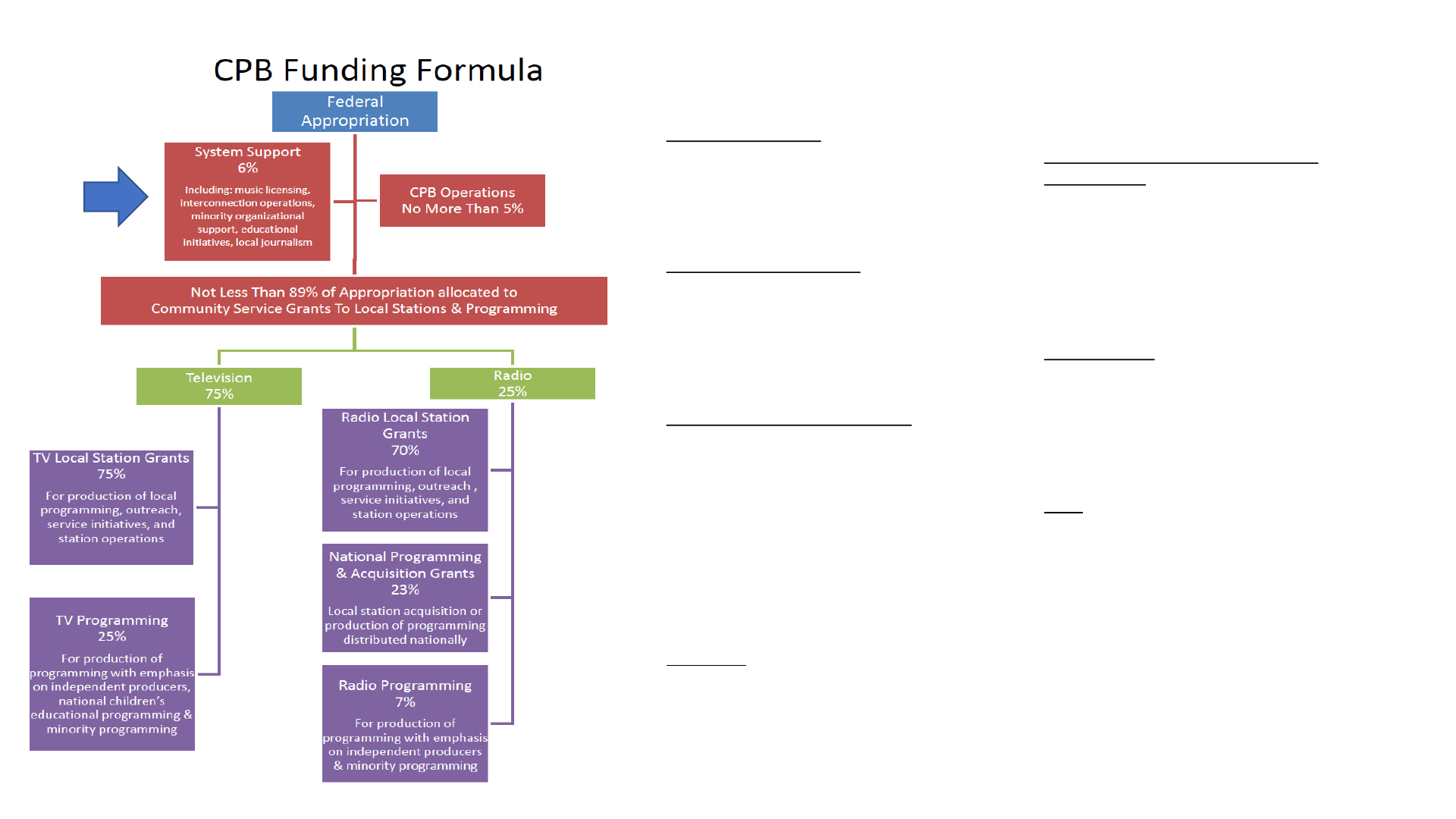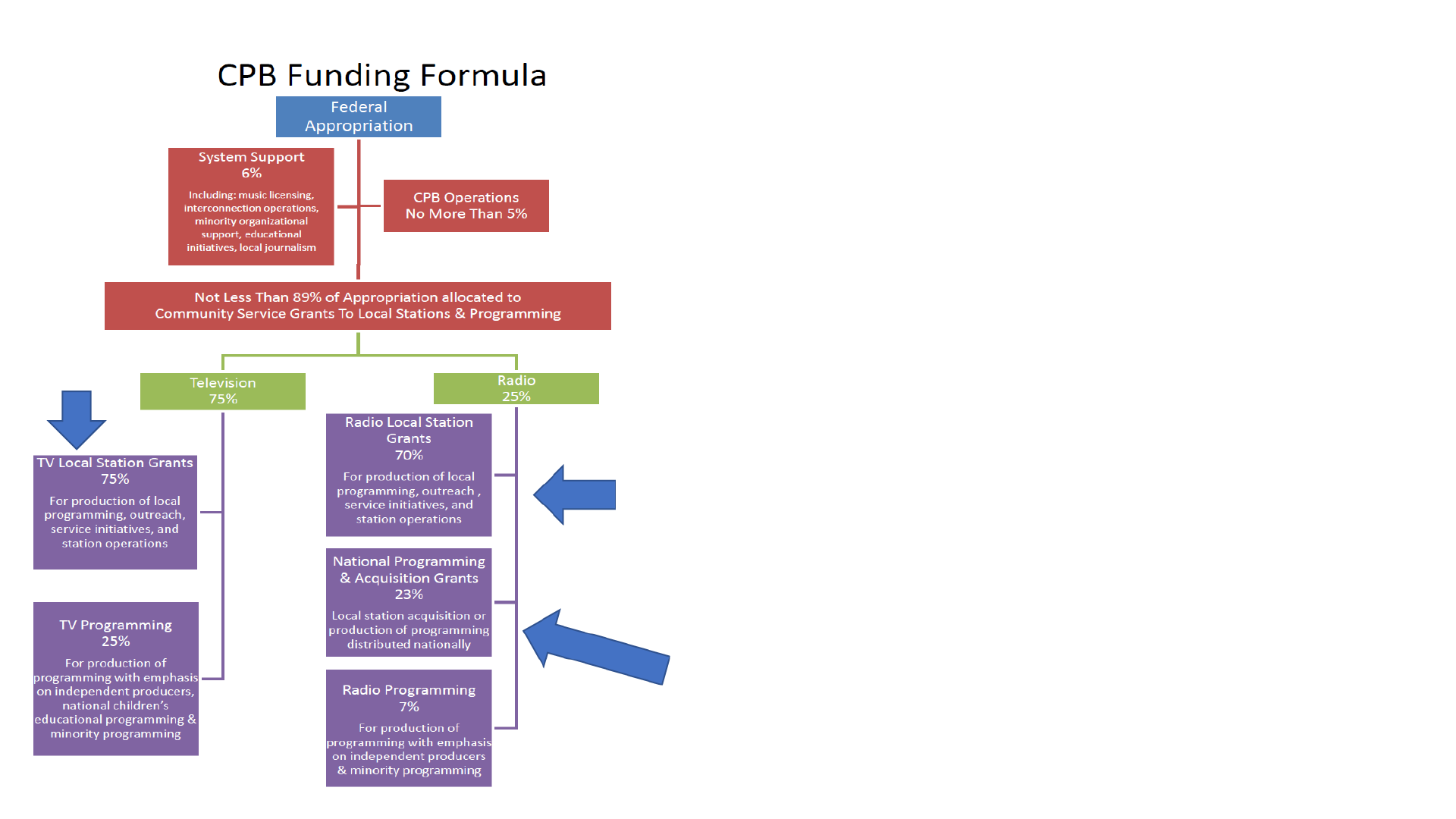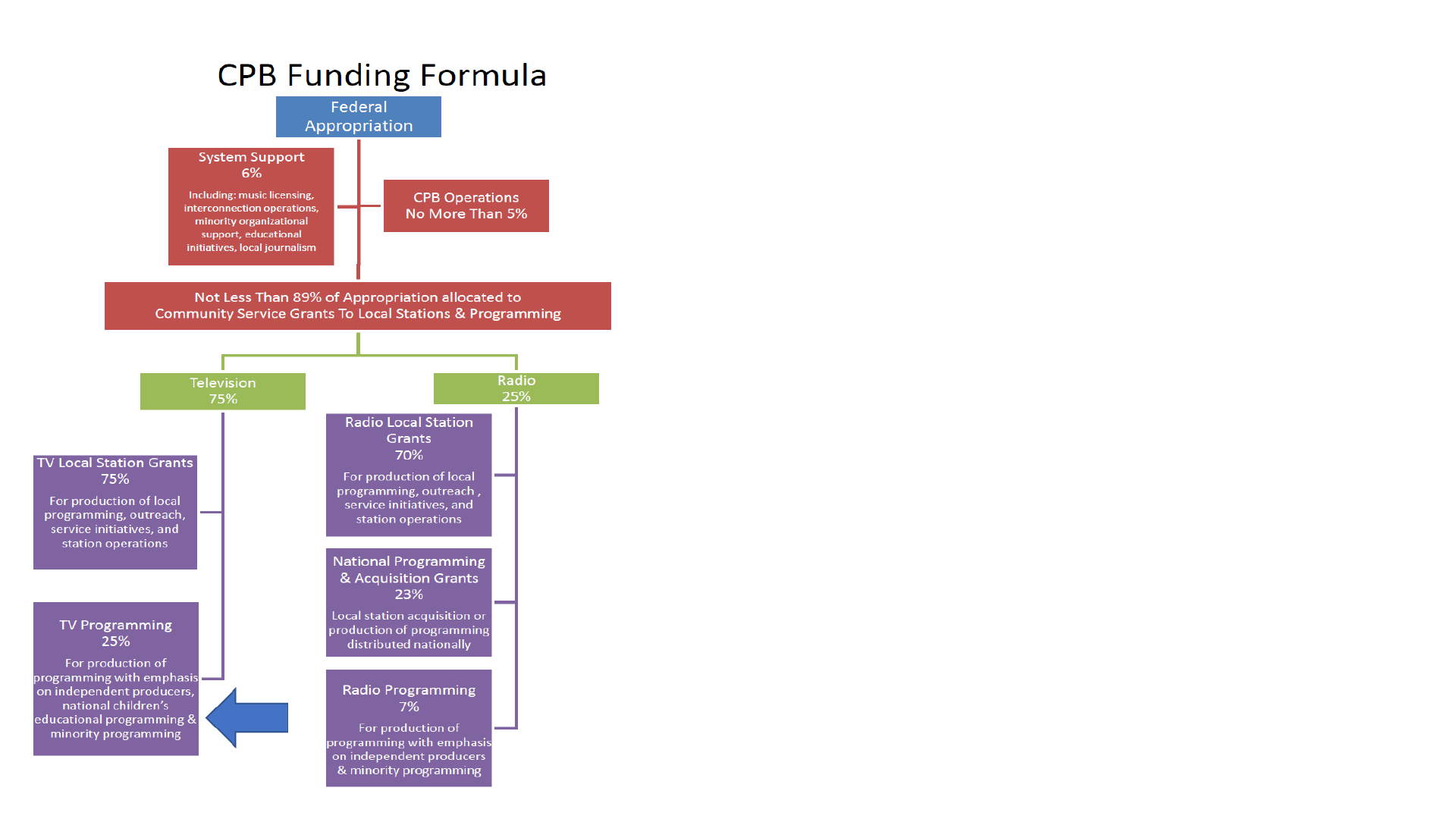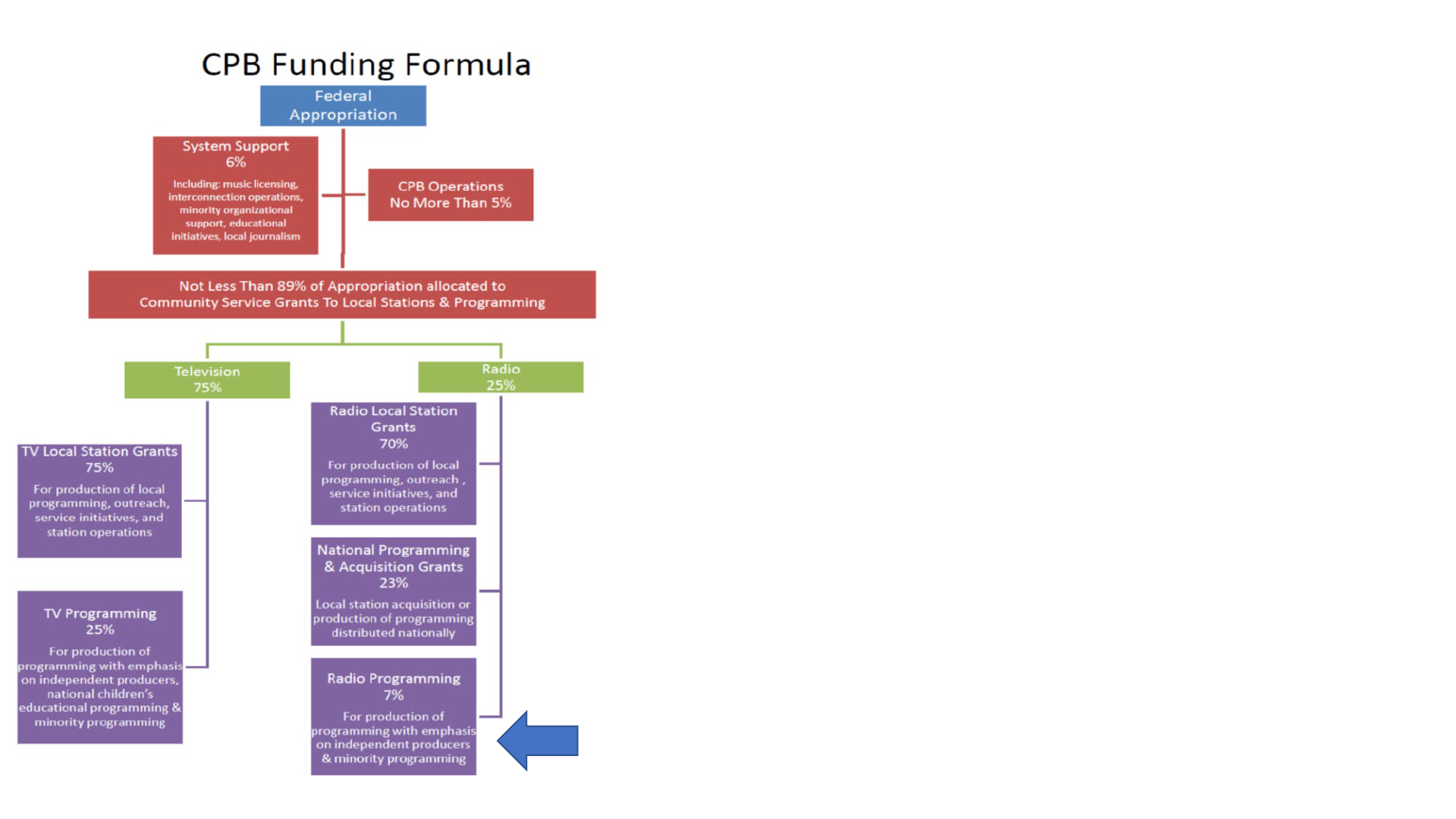
Corporation for Public Broadcasting
Appropriation Request and Justification
FY 2023/FY 2025
Submitted to the Labor, Health and Human Services, Education, and Related Agencies
Subcommittee of the House Appropriations Committee
and
the Labor, Health and Human Services, Education, and Related Agencies Subcommittee of the
Senate Appropriations Committee
March 28, 2022
This document with links to relevant public broadcasting sites is available on our Website at:
www.cpb.org
1
Table of Contents
Financial Summary …………………………..........................................................2
Narrative Summary…………………………………………………………………4
Section I – CPB Fiscal Year 2025 Request .....……………………...……………. 6
Response to House Committee Report 117-96, Continued Access to
Public Broadcasting …………………………………….............................45
Response to House Committee Report 117-96, Diversity and Inclusion…..46
Interconnection and System Support (6%) Request………………………..50
FY 2025 Proposed Appropriations Language……………..……………….52
Section II –
Interconnection Fiscal Year 2023 Request.……...…...…..…..… . ... 53
FY 2023 Proposed Appropriations Language……………………… 60
Section III – CPB Fiscal Year 2023 Request for Ready To Learn ……...…...…...62
FY 2023 Proposed Appropriations Language………………….…... 67
Appendix A – Inspector General Budget………………………..……..…………68
Appendix B –
CPB Appropriations History …………………...………………....69
Appendix C – Formula for Allocating CPB’s Federal Appropriation………….....71
Appendix D –
CPB Money Tree with Projects and Content……………………...72
Appendix E – Legislative History of CPB’s Advance Appropriation ………..…..77
Appendix F –
Public Broadcasting Interconnection and Funding History ….……78
Appendix G – Ready to Learn Research and Evaluation Studies …...……….…..82
Appendix H – State Profiles……………………………………………………....89
Appendix I – President’s FY 2023 Budget Request for CPB …………………..127

2
FINANCIAL SUMMARY OF THE CORPORATION FOR PUBLIC BROADCASTING’S
(CPB) BUDGET REQUESTS FOR FISCAL YEAR 2023/2025
FY 2025 CPB Funding
The Corporation for Public Broadcasting requests a $565 million advance appropriation for
Fiscal Year (FY) 2025. This is a $40 million increase compared to FY 2024 funding.
First proposed by President Ford as a five-year advance, the two-year advance appropriation, in
place since 1976, has served as a firewall that protects public media’s independence from
political influence and has helped public media achieve its status as the most trustworthy media
outlet in America. It has also made possible the long-term planning required to ensure public
media’s educational programming meets the highest academic and journalistic standards. This
serious and comprehensive approach to educational programming has helped children from low-
income families achieve on an educational level of their more affluent peers. The two-year
advance also allows us to invest in the most recent research required to ensure public media’s
content continues to have this positive impact.
CPB Annual Funding History, FY 2019 through FY 2025 (in millions)
FY2019
FY2020
FY2021
FY2022
FY2023
FY2024
FY2025
General Fund
$445 $445
$445
$465
$475
$525
$565
Request
Interconnection
$20
$20
$20
$20
$60
Request
TBD
TBD
FY 2023 Public Broadcasting Interconnection Funding
CPB requests $60 million, a $40 million increase, to continue modernizing the public television
and public radio interconnection systems, referred to in our request as the “public broadcasting
interconnection system,” and other technologies and services that create infrastructure and
efficiencies within the public media system. Interconnection is the infrastructure backbone of our
nation’s public broadcasting service. CPB requests Congress’s support in updating the public
broadcasting interconnection system and further investing in systemwide infrastructure and
services that benefit the American people.
Congressional support for interconnection originates in the 1967 Public Broadcasting Act. The
Act authorizes the “establishment and development of one or more interconnection systems to be
used for the distribution of public telecommunications services so that all public
telecommunications entities may disseminate such services at times chosen by those entities” [47
USC 396 (g)(1)(B)]. Since 1988, Congress has supported a separate appropriation for public

3
media’s interconnection needs.
1
Beginning in FY 2018, Congress endorsed an annual
appropriation, administered by CPB, to facilitate dynamic upgrading of the interconnection
system. CPB can now more easily report back to Congress regarding the ongoing strategic
application of the interconnection funds.
Audit and Inspector General Reports
The Corporation continues to receive clean financial statement audits from an independent
certified public accountant. The most recent audit report, dated February 16, 2022, states that
“the combined financial statements referred to above present fairly, in all material respects, the
financial position of Corporation for Public Broadcasting and Affiliate as of September 30, 2021
and 2020, and the changes in their net assets and their cash flows for the years then ended in
accordance with accounting principles generally accepted in the United States of America.”
In 1988, Congress established the Office of Inspector General (OIG), an independent office
within CPB. The Inspector General (IG) is hired by and reports to the CPB Board of Directors.
OIG's mission is to promote the efficiency, effectiveness, and integrity of CPB initiatives and
public media operations by conducting independent and objective audits, investigations, and
other reviews. Public Law No.115-414 requires CPB to report on public recommendations from
OIG that are more than one year old and for which no final action was taken. As of March, 21,
2022, CPB’s IG has confirmed that there are no “open” or “closed, unimplemented”
recommendations that are more than one year old.
1
Public Telecommunications Act of 1988 (P.L., 100-626)

4
NARRATIVE SUMMARY OF THE CORPORATION FOR PUBLIC
BROADCASTING’S (CPB) BUDGET REQUESTS FOR FISCAL YEAR 2023/2025
The Corporation for Public Broadcasting is the steward of our nation’s investment in a public
media system that serves all Americans every day with free informational, educational, and
enriching content. CPB supports a healthy and vibrant network of public media stations that play
an essential role in education, journalism, public safety, and civic leadership in communities
across America.
Through key initiatives such as Coming Home: Connecting to Community; American Graduate;
Move to Include; local and regional journalism collaborations; Ready To Learn; and support for
public safety communications, CPB encourages local public media stations throughout the
United States to serve their diverse urban and rural communities and strengthen our civil society,
locally and nationally.
The value of public media has been especially evident during the COVID-19 pandemic as
stations acted quickly to serve their communities’ needs. In spring 2020, when millions of
Americans’ lives were disrupted, public media’s services provided (and continue to provide) a
lifeline to community resources, health and safety information, and the education needs of our
nation’s children. Station website audiences grew 250 percent as Americans urgently looked for
trusted information and reporting on how coronavirus was affecting their localities.
CPB’s education mission encompasses all ages and grade levels from early childhood,
elementary and secondary education, adult and continuing education, including workforce
development, and lifelong learning. Public television, through the Ready To Learn program at
the Department of Education, helps millions of young children develop the basic early learning
skills to succeed in school. Hundreds of millions of children have benefited from this early
learning program throughout public broadcasting’s decades-long commitment.
PBS LearningMedia, a partnership of PBS and the GBH Educational Foundation (Boston), and
funded in part by CPB, provides free elementary and secondary school education resources to
approximately 2.2 million educators, students, and homeschoolers each month.
2
The service
offers teachers and parents access to more than 31,000 individual learning materials, bundled for
ease of teacher use into videos, images, interactive features, and media galleries to enrich
classroom instruction and to aid remote learning. PBS LearningMedia content includes
standards-based, curriculum-aligned, interactive digital learning content drawn from the best of
public television programming (NOVA, Nature, American Experience, and more), as well as
excellent source material from the Library of Congress, the National Archives, The National
Gallery of Art, the Smithsonian Institution, NASA, the National Science Foundation, and other
leading educational and cultural institutions.
CPB’s American Graduate initiative is public media’s long-term commitment to supporting
community-based solutions to help young people succeed in school and in the workplace.
Building on years of success, American Graduate has evolved from helping young people stay
2
Source: Google Analytics, August 2020-May 2021.
5
on the path to a high school diploma to addressing the skills gap and the education and training
needed for high-demand careers of today and in the future.
Public safety is another core aspect of our public service, and it goes well beyond local news
coverage and participation in the Emergency Alert System by radio and television stations
nationwide. Through PBS WARN, public television stations serve as the fail-safe alternate
distribution path for the nationwide Wireless Emergency Alert (WEA) system. Separately, NPR
and the Public Radio Satellite System’s MetaPub service enables about 12 percent of local public
radio stations to issue text and image alerts and other information to “connected car” smart
dashboards, mobile phones, HD radios, and online streams. Covering nearly 99 percent of the
U.S. population, public television and radio stations ensure on-air delivery of lifesaving alerts
and information during local and national emergencies.
Throughout the last two years of challenge and uncertainty, CPB support has made it possible for
public media to cover and contribute to the national discussion about the pandemic and the
economy, and economic, health and social inequities connected to race. Between 2011 and 2019,
before the pandemic and its economic fallout, public radio stations had expanded local
newsrooms and added more than 1,100 journalists. Today, public radio has more than 3,100
journalists working at local public radio stations across the country, bringing reliable local
reporting to communities everywhere – including to those that had become “news deserts” due to
the loss of local newspapers. Public media remains a calm, steady source of trusted daily news
and information during these disruptive times.
Public media programming continues to earn the nation’s most prestigious awards—including
six Peabody awards in 2021 (plus the first-ever Journalistic Integrity Peabody for PBS
NewsHour’s Judy Woodruff) and 302 Regional Murrow awards in 2021. Public radio claimed
277 awards – 80 percent of the 343 awards in the U.S. radio categories. In addition, NPR’s “No
Compromise” podcast—a collaboration between NPR, KCUR in Missouri, and WABE in
Georgia— received the Pulitzer Prize for audio journalism. Public media is a forum for civil
discourse, cultural enrichment and educational instruction reaching virtually every household in
America.
CPB, as the steward of the federal appropriation, will continue to support public media’s
essential role as a promoter of civility and mutual respect, providing lifelong learning and fact-
based journalism, as we engage with and serve new, diverse audiences and apply our funds in
ways that are of value to all Americans. Congress’ support of increased funding will allow public
broadcasting to remain true to this longstanding commitment.

6
Section I
CPB Requests a $565 Million Advance Appropriation for FY 2025
The Corporation for Public Broadcasting (CPB) requests a $565 million advance appropriation
for Fiscal Year 2025. The two-year advance is the most critical part of the congressionally
constructed firewall that protects public media’s independence from external interference and
control.
CPB's FY 2025 request provides the support for CPB to carry out its statutory mandate to
provide a resilient and trusted service to all Americans. Federal funding remains an irreplaceable
part of the fabric of the national-local, public-private partnership that is the foundation of public
media’s success. Numerous studies, including an investigation and report by the Government
Accountability Office, have shown that there is simply no alternative to the federal investment to
accomplish the public service mission that Congress assigned to public broadcasters and that the
American people overwhelmingly support. For the 19
th
consecutive year, PBS continues to be
one of the most trusted institutions and is considered the best value for the American tax dollar.
3
NPR ranks #1 as trustworthy among news providers in 2021, and NPR Member stations reach
more people weekly than the total combined daily circulation of the top newspapers in the
United States, including USA Today, The Wall Street Journal, and The New York Times.
4
Overview of the Corporation for Public Broadcasting
CPB is the only entity in public media that has the single viewpoint to assess the overall
economic health, changing media environment, infrastructure and technology needs, and
challenges and opportunities for both public television and radio. CPB works closely with PBS
and NPR to support a healthy public media system, but only CPB is in the position to assess
whether stations and content producers are effectively and efficiently serving the American
people. In this role, CPB seeks to support stations and producers in delivering content on new
platforms to engage new and younger audiences, train and increase diversity, diversify the public
media workforce, and grow the use of nationally shared infrastructure so that stations can focus
on creating content and serving their communities.
As the steward of the federal appropriation, CPB supports 1,190 public radio stations and 356
public television stations, serving nearly 99 percent of the American population living in rural,
small town, and urban communities in all 50 states, the District of Columbia, and four
commonwealths and territories. Public media is a trusted source of information, education, and
culture for millions of Americans, including, in disproportionately large numbers, underserved
populations such as rural Americans, minorities, older Americans, lower-income families and
individuals with disabilities.
CPB’s funding flows through a statutory formula, which apportions approximately 71 percent of
funding directly to stations. CPB’s administrative expenses are capped at 5 percent. Thus, 95
3 Marketing & Research Resources Inc. (M&RR) February 2022. https://www.pbs.org/about/about-
pbs/blogs/news/pbs-and-member-stations-voted-most-trusted-institution-for-19-consecutive-years/
4 E-Score Brand, E-Poll Market Research (April 2021).
7
percent of the appropriation managed by CPB provides essential services and programming to
local communities; addresses current issues in an objective, fair, and balanced manner; bolsters
the American Graduate initiative to help young people succeed in school and in their careers;
goes to stations to enhance their local emergency alert services; and funds diverse informational,
educational, and cultural content and services.
The federal investment through CPB is the foundation on which the entire public media system
is built. Undermining this foundation would put the entire public media structure, and the
services it provides, in jeopardy. Local stations leverage CPB funding to secure vital support
from other sources. More than six nonfederal dollars are raised for each dollar appropriated to
public broadcasting. Although private donations and existing sources help defray considerable
costs for the much-honored programming and services, the federal investment is essential to
sustain the operations and public service mission of local public broadcasting stations.
Further, smaller stations that serve rural communities do not have the donor base to raise as
much money as their more urban counterparts. In rural areas, public broadcasting stations may be
the only local source of news, weather, emergency alerts and other critical community services.
The federal investment in public media keeps these services commercial-free and available to all
Americans free of charge.
More than a decade ago, CPB created a strategic framework called the “Three Ds”—Diversity,
Digital, and Dialogue, to reflect our commitment to inclusion, innovation, and community
engagement. Since then, we have applied our resources to ensure public media content is
delivered over multiple media platforms and embraces inclusion and diversity in terms of age,
ethnicity, race, gender, socio-economic background, geography, points of view, and differing
abilities/disabilities—at all levels of public media. Diversity, Digital, and Dialogue continue to
shape public media’s future through the content, filmmakers, programming, and initiatives we
fund.
An Educational Treasure
Education is the heart of public media, and our contribution to education—from early childhood
through adult learning—is well-documented. With a mandate to provide content and resources
that educate and inform, public television and radio stations have a proven 50-year track record
of improving educational outcomes for all children, especially those from high-need
communities. Our content is regarded consistently as “most trusted” by parents, caregivers, and
teachers, and as classrooms become more connected, our content becomes an even more
valuable teaching tool.
Built on the success of programs such as Sesame Street, Reading Rainbow, and Mister Rogers’
Neighborhood, PBS is the number one source of media content for preschool teachers and a
leading resource parents turn to for preschool video online, with content demonstrated to
improve critical literacy and math skills in young children.
CPB’s appropriation makes this researched-based, educational content possible, both on-air and
through free digital platforms, to every child in the nation. Over the past several years, CPB has
supported award-winning shows that support children’s readiness for school in a variety of

8
subjects, such as Daniel Tiger’s Neighborhood, which focuses on the social-emotional
development of young children (ages 2 to 5); Donkey Hodie, which premiered in spring 2021 and
supports children’s problem-solving skills and perseverance; Elinor Wonders Why, which
encourages pre-school children to follow their curiosity about science and learn about the natural
world around them; and Molly of Denali, which teaches kids ages 4 to 8 about informational text
through video content and interactive games. Informational text (oral, written, or visual text
designed to inform) is essential to navigating daily life, and independent randomized controlled
trials have demonstrated that access to Molly of Denali resources improved children’s ability to
use informational text to solve real-world problems.
5
The content on PBS KIDS reflects the diversity of the United States. Molly of Denali, produced
by GBH (Boston), is the first nationally distributed children’s series to feature an Alaska Native
lead character. CPB funding for Molly of Denali supported the inclusion of Alaska Native talent
in every part of the production, including a scriptwriters’ fellowship for Alaska Native writers
and a series of voiceover workshops to cast Alaska Native youth in the series. In addition, with
CPB’s support, GBH convened a group of five rural-serving public media stations to create and
pilot the Molly of Denali Family Game kit, an educational engagement initiative designed
specifically to meet the needs of rural families in communities throughout the country. Following
this pilot, GBH worked with 53 stations to distribute 5,000 Family Game kits across the country
in spring 2021. Research showed that after playing the games, participating families
demonstrated increased knowledge of informational text and of Alaska Native culture and
language.
Recognizing the importance of a strong foundation in critical thinking skills, CPB supported a
new series for 4- to 6-year-old children called Alma’s Way (produced by Fred Rogers
Productions), which premiered in fall 2021. Alma’s Way was created by Sonia Manzano (Sesame
Street’s Maria) and centers around a Puerto Rican family living in the Bronx. Produced with a
team of Latino writers, animators, producers, casting directors, voiceover actors and musicians,
Alma’s Way showcases a relatable American family and models responsible decision-making as
young Alma learns to think and understand other people’s points of view. When Alma’s Way
premiered on PBS KIDS, it was broadcast alongside a new digital short-form series called Jelly,
Ben, and Pogo (produced by Primal Screen), also supported by CPB through our longstanding
support to PBS KIDS for innovations in children’s media production. This short-form series
targets children’s STEAM skills--Science, Technology, Engineering, Arts, and Math—and
features Filipino-American culture based on the experiences of the series creator.
CPB also provided support for Rosie’s Rules (produced by 9 Story Media Group), a new series
for preschoolers that will premiere in fall 2022. Rosie’s Rules takes place in a diverse Texas
suburb, and focuses on social studies, including the basic civic, democratic, and economic
principles that will help young children understand the communities and society in which they
live.
5
Kennedy, J. L, Christensen, C., Maxon, T., Gerard, S., Kook, J., Garcia, E., Hupert, N., Vahey, P., Pasnik, S.
(2021). The efficacy of digital media resources in improving children’s ability to use informational text: An
evaluation of Molly of Denali from PBS KIDS. Education Development Center, Inc., & SRI International.

9
The PBS KIDS 24/7 channel and live stream provides kids throughout the country with the
highest level of educational programming, available through local stations any time, day or night.
PBS and public television stations complement on-air broadcast services by making educational
and other noncommercial content and services available on PBS.org and PBSKIDS.org, as well
as station websites, streaming video services, social media, blogs, and interactive educational
games.
Mega Wow, a new short-form series funded through CPB’s PBS KIDS Digital Innovations
project, launched on YouTube and YouTube Kids. Mega Wow focuses on science experiments
that young children and parents can do together. Hosted by Portland, Oregon-based educator and
comedian Katie Nguyen, the series was produced in collaboration between PBS KIDS and PBS
Digital Studios. First season episodes released in spring and summer 2021 have been viewed
more than 1.7 million times.
Traffic across PBS KIDS digital platforms includes 8.2 million average monthly visitors to
pbskids.org, 2.8 million average monthly users of PBS KIDS-owned OTT apps, 2.8 million
average monthly users of the PBS KIDS Video App, and 2.4 million users of the PBS KIDS
Games app.
6
The collection of more than 42 mobile apps has been downloaded 99.5 million
times.
7
An evaluation of PBS KIDS’ digital content found that the games and at-home activities
had a positive impact on children’s math skills, as well as increased parent engagement in their
children’s learning.
8
Ready To Learn
Since Ready To Learn’s (RTL) inception, public media has produced and disseminated an
extensive collection of evidence-based content to advance the school readiness skills of children,
particularly those in low-income communities. Each year, CPB and PBS collaborate with
hundreds of local stations and their partners to implement literacy, math and science resources
with children, families, and educators. Using nationally created content for broadcast, digital,
and mobile platforms, local stations work with community partners to extend learning and target
resources where they are needed most. The demand for community-based Ready To Learn
funding exceeds the program’s current financial resources.
The 2015-2020 grant cycle resulted in production of innovative science and literacy content
including Elinor Wonders Why, Molly of Denali, The Ruff Ruffman Show, and new seasons of
The Cat in the Hat Knows a Lot About That! and Ready Jet Go. A total of 30 Community
Collaboratives for Early Learning and Media, led by local public media stations and partners,
excelled at deep community engagement that successfully connected RTL resources with
6
Source: Google Analytics pbskids.org, PBS KIDS Video iOS and Android, PBS KIDS OTT, PBS KIDS Games
App, Oct ‘20 - Sep ’21.
7
App downloads (AppFigures March 2011 – September 2021)
8
McCarthy, B., Li, L., Schneider, S., Sexton, U., & Tiu, M. (2013). PBS KIDS Mathematics Transmedia Suites in
Preschool Homes and Communities. A Report to the CPB-PBS Ready to Learn Initiative. Redwood City, CA:
WestEd.

10
children and families, especially those from low-income backgrounds, as well as their educators
and caregivers.
Local public television stations play a unique and essential role in leading RTL’s engagement
effort, and this has been especially evident during the pandemic. By working with partners such
as early learning providers, childcare facilities, housing authorities, public libraries, faith-based
organizations and others, local stations and their collaborators provide anytime, anywhere
learning opportunities. Local stations have the community connections to identify local partners
that help bring Ready To Learn content to the children and families who need it the most. Ready
To Learn local station engagement activities have included:
• virtual and hybrid engagement experiences for children, families, and educators who
need remote learning opportunities, in general, or because of disruptions to learning
caused by the pandemic;
• educational after-school programs and summer camps for kids who do not have other
out-of-school time opportunities;
• mobile learning labs that bring digital learning devices to under-resourced
neighborhoods; and
• local training for teachers and caregivers so they can make the most of the Ready To
Learn media resources.
No other media organization has this national reach, combined with proven effective engagement
and trusted local service to low-income communities.
CPB, PBS, and the U.S. Department of Education’s RTL program also invest in extensive
research that demonstrates the effectiveness of its content in both formal and informal
educational settings. For the 2015-2020 round of RTL, independent, third-party researchers
conducted a variety of studies to assess the impact of RTL resources on children’s learning.
Please see Appendix G for more information on Ready To Learn research studies.
Local Education Services
Partnering with local schools and education agencies, public broadcasters are providing an array
of resources to thousands of schools and homeschoolers across the country, helping educators
meet the specific needs and educational goals of each student. Federal funding through CPB
grants empowers stations to create solutions and reach students with engaging educational
content and experiences.
With the requested increase in CPB’s FY 2023/2025 funding, stations could expand educational
resources as well as their services to rural communities. Current examples of stations’
educational services include:
• Georgia Public Broadcasting’s Georgia Studies Digital Textbook teaches state history,
culture, and geography in the context of American history and government. The book is
updated regularly to make sure the content is relevant and aligned to the most recent Georgia
Performance Standards. To complement the digital book, GPB offers Georgia Studies videos

11
and primary source materials, 30 virtual field trips and created “Race Through Time” – an
online history adventure game aligned to Georgia Standards of Excellence for 8th-grade
social studies.
• PBS Wisconsin’s K-12 multimedia educational content connects to Wisconsin’s academic
standards spans all curricular areas and is vetted by the state’s educators. “Meet the Lab”
helps students relate to people in science careers and learn about the real-world problems that
research works to solve. “Wisconsin Biographies” connects children in grades 3-8 with
figures from Wisconsin’s past. Additionally, “Jo Wilder and the Capitol Case” is an
adventure game for children in grades 3 through 6 that engages students in critical thinking
and historical inquiry to learn about Wisconsin state history. Wisconsin PBS also partners
with the Wisconsin Department of Public Instruction and Wisconsin Indian Education
Association to produce a collection of resources and authentic educational materials for
teaching about the American Indian Nations of Wisconsin. These resources assist educators
in fulfilling the statutory requirement that all school districts provide instruction in the
history, culture, and tribal sovereignty of the America Indian nations in the state.
• PBS North Carolina’s SciNC produces and distributes engaging and educational STEM
content – on air, online, and in person. The project aims to inspire and educate the next
generation of scientists with originally produced, interactive, free digital lesson plans aligned
to elementary and middle school science standards.
• Iowa PBS offers STEM teacher externships to Iowa teachers who work with educational
media producers to curate and create media-based science phenomena for use in Iowa
classrooms. The station’s education staff actively promote the use of educational media
resources to support STEM learning at more than a dozen events reaching thousands of
participants. The station also offers Young Explorers, a growing collection of videos,
activities, and experiments designed for children ages 4-9 that encourage children to explore
and learn more about topics connected to STEM, the arts and literacy.
• WTIU in Bloomington, IN, hosts a summer tech camp, WonderCamp, for children. It
introduces students to mentors and challenges them to complete exercises in storyboarding,
script writing and editing. WonderCamp sessions are categorized by grade to provide age-
appropriate lessons and activities to students in kindergarten to eighth grade.
• KQED’s Above the Noise, the only PBS KIDS Digital Studios series produced specifically
for a middle- and high-school audience, helps students learn about both sides of debatable,
trending topics. Each episode models how to ask thoughtful questions, consider solutions,
and put forward an idea backed with evidence. Through KQED’s classroom platform, KQED
Learn, Above the Noise is used in California classrooms as the basis for assignments that
have students investigate topics, consider evidence, and present their findings by producing
their own media. CPB funding provided a template of KQED’s youth engagement model so
that public media stations across the country could engage youth in their communities.
• Georgia Public Broadcasting’s Lights, Camera, Budget! is an online game designed to help
middle and high school students learn, study, and review financial literacy topics while also

12
practicing their budgeting skills. Additionally, GPB recently released “GASHA GO! World,”
a suite of games and activities that teach number sense, numeracy, and literacy to children in
kindergarten to third grade.
• Nine PBS in St. Louis, working with the Regional Youth Employment Coalition, created a
Financial Literacy Guide complete with educational resources to help young adults gain the
skills and knowledge to make informed and effective financial decisions.
• In 2021, six Arkansas “Teacher of the Year” winners recorded nearly 90 instructional
broadcast and streaming segments for students. Written and produced by Arkansas PBS staff
in conjunction with the Arkansas Department of Education, Arkansas PBS filmed 30 field
trips across the state, and incorporated a puppet show, new animations, and 14 original songs.
In addition, 36,000 free learning packets were distributed through 55 organizations serving
kids in Arkansas.
• Montana PBS covers 95 percent of the state’s population and airs educational children’s
content 24/7. The station provides educational technology access through workshops and
community events with the Montana PBS Education Mobile Lab. Equipped with iPads and
Chromebooks, the Mobile Lab offers access to educators, families, and community members
to explore PBS Kids and PBS LearningMedia. The station also provides professional
development for rural teachers to help integrate education technology into the classroom.
• In Bowling Green, KY, WKU Public Broadcasting, in partnership with the Western
Kentucky University Suzanne Vitale Clinical Education Complex, established the David
Brinkley Student Employment Fellowship Program for WKU students with autism spectrum
disorder (ASD). CPB funding also provides WKU Public Broadcasting with an opportunity
to learn from the students’ neuro-diverse perspectives on how to generate content for and by
individuals with ASD.
• In Philadelphia, WHYY’s Pathways to Careers offers specialized training programs for
students to help them advance their media skills and learn how to market themselves as
freelancers. The summer program, building on a WHYY Media Labs pilot project, allows
youth to put their media skills directly into action as they pitch work, get feedback on drafts
and rough cuts, and ultimately see pieces published through the media organizations with
which WHYY works. WHYY provided the students with equipment including cameras,
microphones, and tripods, which the students can keep, helping them launch their own
freelance businesses. Through December 2021, WHYY’s Media Labs program has operated
in 49 schools, serving over 15,600 students, trained 548 teachers, and offered students 115
paid employment experiences.
At-Home Learning During the COVID-19 Pandemic
Providing proven, educational content to underserved communities is central to public media’s
mission. In response to the pandemic’s impact on our education system, public media stations in
all 50 states are leveraging investments in public media content, services, and technology to offer

13
educational resources for students, families, and teachers. This is especially valuable for students
who do not have reliable access to technology or broadband Internet.
When schools closed, public television stations helped teachers and families turn homes into
classrooms and narrow the gap between those who are connected online and those who are not.
Stations, often partnering with local and state education agencies, adjusted their programming
schedules to offer curriculum-aligned, grade-specific blocks of educational public media content.
These efforts have built on public media’s investments in research-driven content in new and
innovative ways to increase equity and support the learning goals of teachers and districts across
the country.
In the summers of 2020 and 2021, CAMP TV, produced by The WNET Group (New York),
premiered a 20 episode, one-hour daily, public television series for elementary school children
(grades K-5) that brought the day camp experience to homes nationwide. The series helped
children keep current with their education already impacted by COVID and through the summer
months and included sub-grants to ten public television stations each summer to create locally
customizable versions of the series.
In January 2021, after many months of coordination and planning with the Michigan Department
of Education and local education associations, Michigan public television stations launched the
Michigan Learning Channel, a statewide public television partnership offering instructional
content to support the education of students and to provide alternative resources for families and
teachers. The weekly calendar of on-demand, educational content and resources can be used in a
fully remote learning environment or a hybrid learning model. All the content is free to school
districts and parents. Over the past year, Michigan Learning Channel has become a vital
distance-learning resource, with an average of 500,000 viewers each month.
Since 2012, CPB has provided funding for the development of PBS LearningMedia. PBS
LearningMedia is an example of multimedia content that is leveraged for Pre-K and K-12
formal education purposes by building video resources for teachers to supplement their
own instruction. CPB’s funding support for PBS LearningMedia has bolstered the
development of content and interactive lessons. The service brings together the best of
public media, delivering tens of thousands of research-based, classroom-ready learning
resources—videos, interactive materials, lesson plans and images—to supplement and
enrich classroom instruction for nearly 40 million students.
PBS LearningMedia proved to be especially valuable during the COVID-19 pandemic.
As schools closed, the use of PBS LearningMedia hit record-breaking numbers in March,
April and May of 2020, with more than 8 million users during those months. This was
double the number of users in the prior three months and double the average monthly
users compared with the previous 12 months. As the 2020-2021 school year began with
many schools continuing virtual learning or adopting hybrid classrooms, PBS
LearningMedia served an average of 2.2 million users per month, continuing to double
the average monthly users compared with pre-pandemic levels.

14
During the pandemic, math teachers expressed a need for video-based digital math
lessons that are easy to use virtually and in the classroom. Responding to that need, and
with CPB funding, PBS LearningMedia is increasing its offerings of interactive math
resources, teacher-presented video lessons, and assignable student activities.
Today, more than 95 percent of all local public television stations, in every state and
territory, provide a highly localized PBS LearningMedia experience in their communities,
including local content, underscoring their significant role as community builders and
local leaders in education. Stations are also aligning the PBS LearningMedia content to
their state’s curriculum standards. This locally driven approach to creating standards-
aligned, digital content for classroom use has served as a best practice for states and
educators wanting to tailor content to the unique learning needs of their students.
In addition, local stations use PBS LearningMedia to provide professional development for
educators statewide. By providing educators with the tools and training they need to integrate
educational media into classroom instruction effectively, public television stations have a direct
impact on teacher and student success.
By/With/For Youth: Inspiring Next Generation Public Media Audiences
In 2020, CPB engaged the Joan Ganz Cooney Center at Sesame Workshop to help public media
identify ways to connect with youth between the ages of 8 and 18. This project, called
By/With/For Youth: Inspiring Next Generation Public Media Audiences, was designed to do two
things: provide an understanding of how youth are using media today, and to identify ways in
which public media can be a preferred platform for young content creators. The project’s work
included interviews with youth and stations, including programming leaders; a series of “design
sprints” with public media stations and producers; and the development of a white paper to chart
a path forward.
In May 2021, the Joan Ganz Cooney Center released the white paper, The Missing Middle:
Reimagining a Future for Tweens, Teens, and Public Media. The paper reflects the input of
media producers, stations, researchers, and young people themselves to help provide public
media with a detailed understanding of not only how youth use media today, but how to engage
and build an audience of tweens and teens. CPB is building upon this work by providing funding
to stations and producers to develop content and education projects “by, with and for” youth.
However, the demand for funding to develop educational content for teens and tweens exceeds
existing financial resources. In a recent grant application, 40 stations applied for content creation
funds, but there is financial capacity to award only 10 station grants.
CPB’s American Graduate Initiative
Building on its reputation as a trusted media provider and community convener, public media
through the CPB-funded American Graduate initiative is focused on helping young people
succeed in school, career, and life. The American Graduate initiative was designed to connect the
mission and capacities of public media—its local stations and national organizations—to
increase awareness, understanding and access to solutions.

15
Beginning in 2011, CPB and American Graduate partnered with Civic Enterprises and the
Everyone Graduates Center at Johns Hopkins University on America’s Promise Alliance’s
Building a Grad Nation to increase the high school graduation rate, especially among
underserved students and students of color who have been disproportionately affected.
In January 2019, Civic Enterprises analyzed the National Center for Education Statistics’
district-level graduation rates where CPB’s American Graduate initiative is active. The results
were impressive. More than 88 percent of the communities in which public media stations have
worked on the high school dropout crisis had an increase in their four-year graduation rate.
Specifically, American Graduate communities had an average 9.7 percent increase in their
graduation rate, compared with the national average of 5.5 percent.
While the high school graduation rate is now at an unprecedented 85.3 percent, the COVID-19
pandemic has introduced new uncertainty about continued progress. As students complete their
schooling and enter an uncertain workforce, they will need support as they navigate educational
opportunities and build in-demand skills to start their careers. The federal appropriation will
ensure that public media stations can continue to partner with businesses, schools, faith-based
and other non-profit organizations to improve outcomes for middle and high school students.
American Graduate Helps Close the Skills Gap
In recent years, CPB’s American Graduate initiative responded to the nation’s need for a skilled
workforce by starting to raise awareness about the skills gap, and the essential education and
training needed for the high-demand careers now and in the future. Public media stations are
addressing the nation’s workforce skills gap by partnering with businesses, education, and
workforce-related organizations; convening gatherings; creating content about the state of the
workforce; highlighting career pathways; and telling stories of job opportunities and skills
needed to meet local industry needs.
• Connecticut Public works with more than 50 businesses and local organizations to highlight
workforce development issues within the state. In its “Path Forward” digital series, the
station highlights stories of young talent and their career aspirations in the manufacturing,
healthcare, and technology industries. The station also produced CUTLINE: The State of
Work, which explored the fundamental ways work has — and has not — changed as a result
of the global pandemic.
• Kentucky Educational Television (KET) created Workplace Essential Skills – an online, on-
demand, instructional system utilizing videos, interactive learning tools and quizzes to guide
learners to develop skills for high-demand careers and provide them with a completion
certificate. Soft skills instruction in reading, writing and math content is presented with real-
life work examples and videos. KET has launched courses in Health Care, Manufacturing,
Transportation/Logistics, Construction, Information Technology, Marketing, Sales &
Service, Hospitality and Tourism. Recent evaluations of the Workplace Essential Skills
program showed 97 percent of participants learned new skills from the content and 85
percent say the coursework helped them achieve goals.

16
• Nine PBS (St. Louis) conducted a panel discussion with local businesses, community college
and school district leaders about the “State of the Workforce 2021 – Living St. Louis
Special.” Nine PBS has also become the lead organization for the Regional Youth
Employment Coalition, a group of local organizations, nonprofits and private sector partners
aiming to close the racial unemployment gap in the St. Louis region. As part of the Coalition,
Nine PBS hosted the 2021 Level Up Youth Conference, which virtually convened youth to
learn about high-demand, skilled careers and declare their plans to train and enter those
careers.
• Idaho Public Television produced “Journey to Education,” a digital series that raises
awareness of different paths young adults can take to further their education and find success
in their chosen career. Last year, Idaho Public Television produced 26 digital stories
promoting high-demand career pathways for youth. Six of these stories produced also
provided critical information to small businesses navigating the challenges of the COVID-19
pandemic. Partners include the State Board of Education, Idaho Department of Labor, Idaho
Workforce Development Council, and Idaho Career and Technical Education.
• WXXI-TV in Rochester, New York, helps audiences explore career options by raising
awareness of successful career pathway opportunities offered in the region. A sampling of
local partners includes the New York State Education Department, Adult Literacy agencies,
Finger Lakes STEM Hub, Finger Lakes Advanced Manufacturing Enterprise, Monroe
Community College’s Economic and Workforce Development Center, Rochester Mini
Makers Faire, the MAGIC Center at RIT and Workforce Development Boards. Last year,
WXXI’s local journalism and podcasts explored local youth training programs, how to build
a local pipeline for traditional trades, and the growing demand for careers in optics and
healthcare.
• KUEN-TV (Utah Education Network) in Salt Lake City, aims to improve capacity for Utah
learners to make well-informed decisions by reducing the stigma of technical education and
working with local partners to address the skills gap. KUEN features online courses in
partnership with Vegas PBS and WHRO in Norfolk, Virginia, to create career-focused
interstitials and update its UtahFutures portal with job comparison capabilities. Local
partners include the Governor’s Office of Economic Development, the State Department of
Heritage and Arts, the Department of Workforce Services, the State Board of Education, and
the GEAR UP program. KUEN has reached over 4,000,000 Utahns with messaging about
career education resources and opportunities and engaged 8,000 participants via in person
and digital events.
• Alaska Public Media (KAKM) brings awareness to the state of the workforce through a
multiplatform promotion of Alaska’s unique culture and infrastructure by highlighting
change-makers and solutions, and hosting community events focused on problem solving,
innovation and skills gap training. Local partners include the Anchorage Economic
Development Corporation, the University of Alaska Workforce Programs, Cook Inlet Tribal
Council and Best Beginnings.

17
• Alabama Public Television (APT) produces local content and partners with business,
education, and workforce-related organizations to highlight the state of the workforce and
career pathways. Last year, APT partnered with the Alabama Association of School Boards
on the “Road to Success” video content. Students participating in the contest create short
videos about the experiences that inspire students to graduate fully prepared for any “road to
success” they choose. Further, the station connects job seekers with public media resources
through a needs assessment, provides information on job opportunities and skills required to
meet local industry needs, and collects data for local and national impact measurement.
• For more than a decade, Vegas PBS has run a worker certification and job training center
providing learners with access to hundreds of online instructor-led certification courses.
These courses range from Cisco IT certifications to veterinary assistant to medical records
technician to home energy audit inspector to paralegal assistant to pharmacy technician to
supply chain warehouse manager to food service manager to alcoholic beverage server.
During the pandemic, Vegas PBS developed virtual field trips to connect students and young
adults with possible career opportunities. Local partners include the City of Las Vegas,
CCSD Career and Technical Education, Las Vegas Chamber of Commerce, the Governor’s
Office of Economic Development, and the United Way.
• WHRO in Hampton Roads, Virginia, produced a social media series titled “Work Like a
Girl” to create awareness of the great opportunities for young women in skilled careers.
Recently, “Work like a Girl” Facebook Live sessions include interviews with young women
describing how they entered their careers. WHRO also created a series of 24 online learning
modules, Workplace Ready, which employers and schools can offer to help prepare those
seeking to enter the workforce.
• GBH (Boston), with CPB funding support, produced a 10-part digital series, “Career Hacks”
to support the emerging young workforce whose first experience in the workplace might be
virtual. Younger job seekers and workers may have savvy technical skills but are not
necessarily adept at presenting themselves and interacting in the workplace professionally.
“Career Hacks” provides young people with accessible video resources to guide them
through the unanticipated challenges of job searching, interviewing, and work
• New Hampshire PBS partners with NH Department of Education, Bureau of Career
Development and others on the “I Build NH” initiative, which profiles local, in-demand,
trade careers and the pathways to attain those jobs.
• New Hampshire Public Radio’s daily news talk show, The Exchange, explored how New
Hampshire’s workforce shortage affects the economic and social fabric of life in the state,
with a special broadcast series In Depth: New Hampshire’s Workforce Challenges.
• WQED’s (Pittsburgh) “Future Jobs” initiative addresses the region’s changing workforce
needs and highlights the training and education needed for local, in-demand jobs. The
initiative includes a 25-part digital series, four broadcast documentaries, and two virtual
events.

18
• The Ohio stations’ American Graduate collaborative (ideastream, CET, and Think TV)
launched a series called “From Here to Career” featuring young people sharing their stories
from school and training programs to quality employment. CET (Cincinnati) launched a
series of shorts called “Finding Your Pathway” in aviation, electrical engineering, and
advanced manufacturing in Cincinnati.
• The SCETV (South Carolina) series “Let’s Go! CAREERS” introduces students to the work
environment through career profiles and 360 videos, especially in industries that need skilled
workers.
• KENW-TV partners with New Mexico Workforce Connection to broadcast “Employment
Opportunities,” a daily two-minute public service broadcast announcement of job openings in
the broadcast area.
Lifelong Learning
Public media remains committed to lifelong learning, available to all citizens. Every day, stations
provide people with opportunities to better their situation through high school equivalency/GED
support materials, teacher professional development, partnerships with colleges and universities
to recruit minorities and first-generation college students, reading services for the blind, and
workforce training and certification.
• Arkansas PBS provided more than 50 hours of professional development training for 600
teachers statewide last year.
• In Jacksonville, FL, WJCT’s Radio Reading Service serves individuals in Northeast Florida
and Southeast Georgia who are visually impaired and print challenged. This closed-circuit
radio station broadcasts commercial-free readings of local and national newspapers,
magazines, books, and more 24 hours a day, seven days a week. Founded in 1993, it remains
the only service of its kind on the First Coast.
• KQED in San Francisco created KQED Teach, an online professional development learning
platform that supports educators’ growing media literacy needs by helping them develop the
media skills necessary to bring media production to their learning environments. The courses,
offered to teachers across the country are free, self-paced, and instructor-led. They come with
certifications that can be used for required teacher professional development hours. KQED
and PBS also partnered to create the PBS Media Literacy Educator Certification program,
which certifies PreK-12 teachers to support students’ media literacy knowledge and skills.
• Kentucky public radio provides its content, staff, and technical support free of charge to the
Central Kentucky Radio Eye, a non-profit reading service that serves more than 9,000 blind
and physically disabled listeners statewide. Radio Eye airs a locally produced broadcast in
which volunteers read local, state, and regional newspapers and magazines. The service also
broadcasts health and exercise programs.
• Kansas University’s “The Audio-Reader Network” is a reading and information service
broadcast by public radio stations to blind, visually impaired, and print challenged

19
individuals in Kansas and western Missouri. Service volunteers read daily newspapers,
magazines, and best-selling books on the air and online, 24 hours a day. Audio-Reader also
offers automated newspaper readings by telephone. Services are provided free of charge to
anyone unable to read printed material.
• Vegas PBS (Las Vegas) hosts and maintains the Described and Captioned Media Program, a
statewide collection of media programs and services for deaf, hard-of-hearing, blind, or
visually impaired students beyond the closed-captioned and audio-described programs
broadcast on public media channels.
• Indiana public radio partners with local art museums and children’s science museums,
resulting in weekly on-air reports.
• East Tennessee PBS broadcasts weekly shows aimed at helping adults prepare for their GED
exam and provides participants with a set of companion study books at no cost.
• PBS NewsHour Student Reporting Labs (SRL) connects youth with public media in
meaningful and substantive ways. The program’s video journalism curriculum, teacher
professional development and mentorships produce unique video stories that explore how
national issues affect local communities. SRL works with schools, stations, and students in
49 states to create content for national broadcast and online platforms. SRL operates local
labs at 170 sites across the country, over 70 of which are at Title 1 schools. SRL reaches
3,260 students per year and has reached over 16,000 students since 2009. Student-produced
content has appeared on 47 local public media station social, digital, and broadcast platforms,
and on 90 national PBS NewsHour evening broadcasts.
• Sun Sounds of Arizona, a service of KBAQ and KJZZ, provides audio access to print
information to people who cannot read or hold print material due to a disability. Sun Sounds
broadcasts the reading of more than 200 local and national publications 24/7 from studios in
Tempe, Flagstaff and Tucson. Hundreds of trained volunteers do all the reading.
Serving Communities Diverse in Race, Heritage, Gender, and Geography
In the words of the Public Broadcasting Act, one of public broadcasting's greatest priorities is to
address “the needs of unserved and underserved audiences, particularly children and minorities.”
CPB’s commitment and funding for diverse filmmakers and storytellers spans decades and has
resulted in content that educates, informs, and inspires mutual understanding and respect.
One way that CPB meets the needs of diverse communities is by providing funds to five entities
that make up the National Multicultural Alliance (NMCA): Center for Asian American Media
(CAAM), Latino Public Broadcasting (LPB), Black Public Media (BPM), Pacific Islanders in
Communications (PIC) and Vision Maker Media (VMM), as well as other producers providing
unique programming for radio listeners.
In February 2021, CPB provided each of the five public media organizations forming the NMCA
a $500,000 funding increase. CPB’s support helps these organizations provide much-needed
content about diverse communities, created by diverse filmmakers, to the public television
system and viewers across the country. The increased support for the NMCA will build on that

20
foundation and ensure that public media’s content reflects the broadest range of cultural and
social perspectives.
CPB support to local public media stations allows stations to elevate the diverse voices of their
communities through inclusive content and engagement. CPB provided funding for the
expansion of Move to Include, a successful initiative developed by WXXI and the Golisano
Foundation in Rochester, NY, that promotes inclusion in all facets of life for people with
intellectual and physical disabilities. Six public media stations —WFYI (Indianapolis, IN), OPB
(Oregon), WGCU (Fort Myers, FL), WCNY (Syracuse, NY) and Iowa PBS (Iowa)—joined
WXXI in this initiative focused on the needs of people with disabilities. The stations all
produced and curated content to encourage community awareness and dialogue about disability
issues, including 22 new educational resources to help educators and parents support the success
of children with disabilities in the classroom, distributed through PBS LearningMedia. This work
was informed by stations’ relationships with local disability communities and provided a
platform for people with disabilities to tell their own stories.
In addition, CPB provides Community Service Grants to 140 minority public radio stations and
provides further support to these stations through funding to Native Public Media and for other
organizations that provide stations with additional capacity. These organizations assist stations
with fundraising, programming, and other efforts to enhance public service to diverse
communities. Funding for these services provides needed capacity to stations operating in unique
and challenging environments. For example, in Native American communities, CPB provides
community service grants to 36 local public radio stations that transmit tribal culture and
languages, electoral information, health and economic news, and serve as emergency lifelines.
Tribal lands are among the most remote and least connected areas in the nation. Without CPB’s
grants to stations such as these, many Americans would lack access to information and basic
educational services. Examples of local public media stations service to Native communities
include:
• KABR-FM (Alamo, NM) partners with the Alamo Navajo Health Center to produce
weekly health programs, especially topics on diabetes and prescription drugs, in English
and Dine’ (Navajo) languages.
• KNBA-FM (Anchorage, AK) produces the Native Artist podcast, which profiles
Indigenous artists from a wide range of artistic disciplines.
• KSUT-FM (Ignacio, CO) produces the series of audio vignettes, Native Braids, capturing
intimate conversations between Native American youth and elders.
• KIYE-FM (Lapwai, ID) works with the Nez Perce Cultural Resource Program to develop
radio programming that promotes learning and understanding of the Nez Perce language.
The station also partners with the Nimiipuu Health Clinics to develop general health tip
and diabetes PSAs that broadcast several times a day.
• KBRW-AM (Utqiagvik, AK) is the only broadcast service available in an area of over
90,000 square miles. The radio station airs programming and announcements, in English

21
and Inupiat, from the Borough School District, health department and local hospital and
police departments.
• KEYA-FM (Belcourt, ND) offers live broadcasts of the Turtle Mountain Tribal Council
meetings, updates from the Tribal Chairman, and Tribal office candidate forums. The
station also partners with area schools to encourage literacy through a radio reading
program and promotes school activities such as parent-teacher conferences.
• WOJB-FM (Hayward, WI) created an Ojibwe language PSA campaign on COVID-19
mitigation measures. The station also launched a mask-making campaign that donated
over 1,000 protective face masks, which were donated to elder Natives in the community.
• KOYA-FM (Lake Andes, SD) participates in the local Yankton Sioux Tribe COVID-19
Task Force. The station partners with the Task Force to provide updated information
about the pandemic and broadcasts PSAs, in English and Lakota, announcing testing and
vaccination sites.
• KILI-FM (Porcupine, SD) partners with the Tribal Education Agency, all 13 schools on
the reservation, OGLALA Lakota College, and local governments to provide news and
Lakota language programming to the Oglala Sioux, Cheyenne River Sioux, and the
Rosebud Sioux tribes.
• KCUW-FM (Pendleton, OR) partnered with three Umatilla Indian Reservation Incident
Command Teams to broadcast information related to flooding, wildfires, and COVID-19.
• KMHA-FM (New Town, ND) partners with The Door Resource and Recovery Lodge to
produce programming that serves those suffering from addiction and mental health
issues.
• KCIE-FM (Dulce, NM) broadcasts a different Jicarilla Apache word at the top and
bottom each hour to preserve the local Native language and culture.
• CPB-supported UnderCurrents is a daily music service that provides an eclectic mix of
Native music with other genres to Native and Triple-A audiences. UnderCurrents is a
primary offering of the CPB-supported Native Voice One (NV1) content distributor and
accounts for 33% of its 24-hour program stream to Native stations. UnderCurrents is
carried on 200 Native and non-Native public media stations from Alaska to Florida.
To foster an inclusive and diverse workforce and on-air talent, CPB has funded projects such as:
• GBH’s Next Generation Leadership Program, the Firelight Documentary Lab for diverse and
emerging media makers, and the Jacquie Jones Memorial Scholarship Fund to support media
projects created by diverse filmmakers.
• WNYC held a “Werk It” podcast festival, which aimed to increase the number of female
audio hosts in public radio.

22
• The Public Media Village at the National Association of Black Journalists and Unity
Conferences which seeks to recruit journalists of color into public media.
• Association for Independents in Radio’s (AIR) mentorships, fellowships, seminars, and New
Voices scholarships, which connect early-career and professional content creators to
professional development opportunities.
• Public media participation in industry conferences such as the National Association of Latino
Independent Producers (NALIP) Media Summit and AFI Docs, which bring together diverse
content creators and industry leaders to explore trends in media and filmmaking.
To attract diverse audiences to public media, CPB supports the development of innovative
content and formats including:
• Urban Alternative public radio. With support from CPB, Chicago Public Radio
implemented a new format in its Vocalo programming stream in 2007 to connect with
young, multicultural audiences through an appealing mix of new and local music
complemented by fresh on-air talent, community engagement, and community-based
programming. More recently, CPB supported the launching of this format in Denver
(KUVO/The Drop), Norfolk (Blazin' Hot 91), and Houston (KTSU's The Vibe). And in
2021, CPB awarded grants totaling $1.3 million for three public radio stations to implement
the Urban Alternative format to connect with young, multicultural audiences. The grants
went to Jackson, MS (WJSU), Milwaukee (Radio Milwaukee), and Minneapolis (Minnesota
Public Radio).
• Audio content for young and diverse audiences. Latinos make up nearly half of the Los
Angeles region. With CPB support, Southern California Public Radio (SCPR) is developing
new ways to reach younger, Latino audiences by increasing Latino on-air hosts, producers,
and production staff. LAist Studios, SCPR's podcast development and production division,
is empowering up-and-coming content creators to produce innovative, on-demand content
and engage audiences seeking connection, information, and entertainment.
• A collaborative reporting project tracking the young Latino electorate ahead of the 2020
national election called Every 30 Seconds. The news collaborative reported on the issues,
influences, concerns, and challenges driving decision-making and turnout among young
Latino voters across the United States. Stations that contributed to Every 30 Seconds
included: KERA in Dallas, KJZZ in Phoenix, KPBS in San Diego, KUOW in Seattle, WABE
in Atlanta, WLRN in Miami, and WUNC in Chapel Hill. The content aired nationally on
PRI’s The World, a daily news program.
CPB’s television programming funds also support the work of an independent television service
as provided for in the Public Telecommunications Act of 1988. With this funding, the
Independent Television Service (ITVS) provides independent producers with financial,
production, and promotional support for their projects which, in turn, provides non-fiction
broadcast and digital programming to the public media system. ITVS curates the primetime

23
broadcast series Independent Lens, public television's largest showcase of original documentary
films, and expands the documentaries' impact through targeted engagement strategies. In 2022,
CPB will work with ITVS to finalize funding in its next multi-year contract beginning in FY
2023.
Supporting Diverse Communities During the COVID-19 Pandemic
During this unprecedented time, public media is responding to community needs and delivering
news, information and educational services that address the needs of those most affected by the
pandemic, especially in communities with large populations of people of color.
• In 2022, Black Public Media (BPM) is presenting a series of Black Media Story Summits
focused on generating media content provides fact-based information about vaccines. The
summits will include discussions with local healthcare providers, policymakers, faith
leaders, community organizers. Following the summit discussions, local Black media
makers will be invited to submit short videos focused on the vaccines and vaccine equity
and select projects will be eligible for up to $60,000 in funding.
• BPM held two “COVID-19 & the Black Community” virtual town hall events. The first,
in collaboration with FRONTLINE, covered public health in Black communities,
centering on testing, Black essential workers, and communications. The second town hall
focused on Black creative economies, highlighting talent development, and cultural
institutions’ response.
• BPM compiled a list of emergency relief resources for filmmakers and storytellers of
color.
• Latino Public Broadcasting (LPB) and PBS presented American Portrait: Somos Testigos
(We are Witnesses), a virtual professional learning session in April 2020. Presented in
Spanish by Puerto Rican educator Glenda Lozada, the online session focused on how
educators can leverage technology to bear witness to events around the world and in their
local communities.
• In connection with the CPB-funded, Peabody-award winning series Asian Americans, the
Center for Asian American Media (CAAM) and Asian American community leaders
hosted a digital town hall exploring how lessons from Asian American history can help
people understand the experiences of Asian Americans during the COVID-19 pandemic.
• Pacific Islanders in Communications (PIC) created COVID-19 resource pages with
funding initiatives, helpful tools, templates, and videos.
• Vision Maker Media (VMM) partnered with PBS LearningMedia to bring Native
American storytelling and content into family homes, with curated lesson plans and
discussion guides free for online use.

24
• With CPB support, Native Public Media (NPM) implemented a targeted public health
campaign. The campaign focused on eliminating misinformation regarding the
coronavirus pandemic, distributing life-saving information to one of the most vulnerable
populations in the country, and educating Tribal Nations on the COVID-19 vaccine.
NPM provided financial support and guidance to the 36 CSG-qualified Native public
radio stations to produce and broadcast public service announcements, many voiced by
tribal elders in Native languages, and other relevant content.
• American Public Media’s Research Lab provides comprehensive, ongoing analysis of
national and state-based data regarding the race and ethnicity of COVID-19 deaths. Since
its launch, the site has quickly become the top-viewed page ever on PMResearchLab.org,
and the analysis has been cited in the New York Times, the Atlantic, Vox.com, The Hill,
Miami Times, Minneapolis Star Tribune, the Minnesota Spokesman-Recorder, Minnesota
Public Radio, WUWM (Milwaukee), the Canadian Broadcasting Corporation and
beyond.
• NPR’s reporting on the Black community included early findings that suggested racial
disparities in COVID-19 death rates, job losses among people of color during the
pandemic, and interviews with faith leaders about existing inequalities that the pandemic
exposed.
• KTSU-FM, licensed to Texas Southern University in Houston, is providing resources and
coordinating CPB support to 14 public radio stations licensed to Historically Black
Colleges and Universities (HBCUs) to distribute vital information on the coronavirus and
vaccinations to their communities. The stations are producing educational public service
announcements, digital content for social media, and related engagement activities, and
they are engaging and forming new community partnerships.
• WCLK-FM, the jazz station licensed to Clark Atlanta University, an HBCSU, is
delivering daily interstitials about COVID-19. The station’s talk show, The Local Take,
has engaged community leaders in conversations about faith, civil rights, voting rights,
mental health, the local economy, and homelessness during the pandemic. Atlanta-based
clergy have offered words of encouragement during WCLK gospel programming, Joy in
the Morning. The station also hosted a live, virtual town hall focused on the COVID-19
vaccine, mental health, isolation, and navigating the COVID-19 economy.
• The Radio Bilingüe National Latino Public Radio Network provides coverage of the
COVID-19 public health pandemic and recent natural disasters, including regular
extended hours of the weekday, national Linea Abierta “open-line” news-talk show, and
many additional weekly public service programs and short educational messages in
Spanish, English and Mixteco. Topics include: the needs of low-income Latinos
regarding preventing infection spread, vaccine information, business reopening
information, advice from medical and science experts, job loss, sick leave, access to
health care, unemployment eligibility, job protection for essential workers, food
insecurity, eviction, relief packages and wildfire and extreme heat emergencies. Radio
Bilingüe is also collaborating with the Alliance for California Traditional Arts on a

25
cultural campaign called ACTAvando Contra COVID that is bringing songs, poems, and
radio dramas to farmworkers and other Spanish-speaking audiences.
• KWIT-FM/Siouxland Public Media partnered with another nonprofit to translate
newscasts into Spanish. The station also hosts COVID-19 information in Somali and
Oromo.
• KUNR in Reno, NV, partners with Noticiero Movil to provide bilingual pandemic
coverage. In 2021, the station was awarded an Edward R. Murrow award for Excellence
in Diversity, Equity, and Inclusion.
• The CPB-funded America Amplified is a community engagement journalism initiative
involving public media stations across the country. In response to demand for up-to-the-
minute answers to questions about the coronavirus, many newsrooms within America
Amplified’s collaborative built COVID-19 blog pages and digital posts answering the
most frequently asked questions from their communities. America Amplified works with
stations to translate that content into Spanish. In July 2021, CPB supported a second
round of funding to support 21 additional stations participation in the America Amplified
initiative.
• NJ Spotlight and NJTV News, through a partnership with NJ News Commons, are
distributing their pandemic reporting to local newsrooms across the state, some of which
serve specific minority communities. NJTV and NJ Spotlight translate some of their
pandemic coverage into Mandarin and Korean, which are the third- and sixth- most
spoken languages in NJ, respectively, and distribute them through local ethnic media
groups.
• Native America Calling, the weekly national call-in show produced by the Koahnic
Broadcast Corporation, airs programming that examines the coronavirus' impact on
Native populations. Topics have included: how to separate fact from misinformation
about the pandemic; the effect on Native businesses; emergency declarations and
lockdowns by tribes ranging from the hard-hit Navajo Nation to the Hopi Reservation
and Pine Ridge Reservation; the crisis-related collapse of rural air service that Alaska
Native communities rely on for daily necessities; and how the allocation of state and
federal relief funds may impact the ability of Native communities to respond to the crisis.
• KOSU-FM (Oklahoma) hired an Indigenous Affairs reporter to cover how the Tribes are
uniquely responding to the pandemic. The station is sharing this coverage with KCNP-
FM, the public radio station licensed to the Chickasaw Nation.
Developing Civic Leadership through Journalism
Today, the challenges we face as a nation require both innovative thinking and application as
well as effective collaboration. Community organizations, especially those in rural communities,
turn to public media to raise awareness, inform through fact-based reporting, and inspire local
solutions. In many communities throughout the country, public media stations are the last locally

26
operated and controlled media outlets. National news organizations often overlook heartland
America except in times of natural disaster or human tragedy, but local public media stations
devote themselves to telling the stories of hometown America every day. In addition, CPB
supports many of the major public media news producers, including PBS NewsHour,
FRONTLINE, Washington Week, Native National News and NPR.
The exceptional journalism that public media provides, including local news and documentaries,
requires financial support. Stations face a trade-off – the more fact-based, local journalism they
produce, the less they have available to spend on other services such as educational engagement
and infrastructure maintenance. CPB’s FY 2023/2025 request will help ease this pressure,
allowing stations to continue producing local news and information on community issues,
thereby developing the best possible, sustainable outcomes. Examples of such efforts include:
• Lakeland Public Television in Bemidji, MN, provides the only locally produced television
news program originating in the rural area of North Central Minnesota.
• Georgia Public Broadcasting airs Primetime Lawmakers, a nightly television program
covering the annual Georgia Legislative session. Interested Georgians can also watch live
streams of the House and Senate sessions at the website www.gpb.org/lawmakers.
• Public radio in Arizona supports various programs and initiatives to reach the many diverse,
local cultures around the state. The stations broadcast in different languages and service the
following reservations: Navajo, Hopi, White Mountain Apache, Hualapai, Havasupai,
Yavapai, and Paiute, as well as urban Native Americans.
• Boston’s 89.7 GBH Radio strives to make local connections with its news and talk
programming that examines public policy, cultural changes, and civic engagement. Each
week, GBH Radio broadcasts 15 hours of original programming that brings a wide range of
local voices and opinions to their listeners.
• KET (Kentucky), with support from the Foundation for a Healthy Kentucky, produces Health
Three60 and KET special reports examining the unique factors affecting teen health today,
including bullying, testing pressure, substance abuse and more.
• Public Television in Colorado airs Colorado Decides, a series of candidate and issue forums
as well as debates, creating an informed electorate which is essential for a thriving
democracy.
• The CPB-supported Civics 101 podcast produced by New Hampshire Public Radio is used as
a classroom-based learning tool. Downloaded more than 12 million times since 2017, Civics
101 podcasts are a refresher course on the basics of the U.S. government. Four classroom
contests were run in which students competed to create their own episodes. Winning entries
were heard on the Civics 101 podcast.
In 2021, CPB entered a partnership with Report for America (RFA) to support 10 new full-time
local reporters at 10 public radio stations over the next two years. Launched in 2017 in response

27
to the crisis in local news, RFA matches journalists with news organizations that want to address
local coverage gaps. The 10 public media stations receive the benefit of RFA’s salary
contributions as well as training and editorial support, core performance and excellence
guidance, local sustainability, and fundraising resources, along with other grant management and
support services.
The stations funded through the partnership, most serving communities in rural and small
markets where more reporters are needed, are: KUCB (Unalaska, AK); Marfa Public Radio
(Marfa, TX); KCAW (Sitka, AK); WFAE (Charlotte, NC); WITF (Harrisburg, PA); WPLN
(Nashville, TN); WSKG (Binghamton, NY); WUFT (Gainesville, FL); WYSO (Yellow Springs,
OH); and Yellowstone Public Radio (Billings, MT).
Local and Regional Journalism Collaborations
CPB funding is a driving force in the growth and innovation of public media journalism. Public
media’s mission is to deliver value to the American people in the form of trusted content that
gives them the information they need to understand our changing world, raise their families,
teach their children, improve their communities, and enhance daily life. With the reduced
capacity of local newspapers and the diminished footprint of commercial broadcast journalism,
there is a widely recognized gap in local reporting and editorial standards. Meanwhile, public
media stations added more than 1,100 journalists to local staffs during the eight years before the
COVID-19 pandemic.
With a $565 million appropriation, CPB would increase the capacity of public radio and
television stations to create local, fact-based, original journalism by supporting collaborations
among public media stations. The purposes of these collaborations are twofold: to marshal
resources of small and remote stations in ways that improve coverage and strengthen
relationships between public media stations; and to create a new focus on station-selected, under-
reported news topics. CPB believes that encouraging stations to produce news coverage
collaboratively strengthens public media’s position as a trusted source of fact-based journalism.
When news organizations pool resources, share lessons learned, and work together on in-depth
and time-intensive projects, the result is stronger than the sum of its parts.
A February 2019 Knight Commission Report on Trust, Media and Democracy recognizes public
media’s successful role in national-local journalism. It stated: “These regional collaborations
among news entities in the public broadcasting field are valuable. It is now time to bring the
learning from the current regional-local initiatives to an alliance for national-local collaborations.
By partnering national and local public broadcasters, this initiative would enhance the public
broadcasting model by further expanding local news coverage and by giving national
organizations greater ability to cover local aspects of larger stories.”
9
Through years of strategic investments, CPB has laid the groundwork for a network of local and
regional public media news organizations that, in partnership with national producers,
strengthens public media’s role as a trusted news source. Leveraging public media stations’ local
9
Knight Commission on Trust, Media and Democracy, Crisis in Democracy: Renewing Trust in
America, Washington, D.C.: The Aspen Institute, February 2019.

28
ownership as a foundation for nationwide collaborations, CPB has invested more than $42.1
million since 2009 to help launch 41 local, regional, and single-topic collaborations as well as
joint regional newsroom operations. These partnerships connect 150 public media stations in 42
states, providing the basis for a vibrant multimedia network of journalism.
By allowing public radio and television stations to better coordinate and share their reporting
expertise and resources, stations can undertake more ambitious journalism projects in multimedia
formats. The collaborations also contribute stories to national public media programs such as
PBS NewsHour and, in 2020, 140 stations contributed more than 10 percent of the stories on
NPR’s Morning Edition, All Things Considered, and Weekend Edition.
The collaborations include:
• Ohio Valley ReSource – Seven public media stations in Kentucky, Ohio and West
Virginia cover the economy, energy, environment, agriculture, infrastructure, the opioid
epidemic, and health in the Ohio Valley region. Louisville Public Media is the lead
station.
• Alaska’s Energy Desk – Five Alaska public media organizations focus on statewide
energy issues and rural coverage. KTOO Public Media (Juneau) is the lead station.
• Kansas News Service – Four stations provide a statewide news service with a focus on
statehouse politics, health, education, natural resources, rural life, and agriculture. KCUR
(Kansas City) is the lead station.
• Mountain West News Bureau – Six stations in Idaho, Colorado, Nevada, Wyoming and
New Mexico focus on natural resource management, Indian Country, public lands, small
towns, and the rural West, and expanding growth in cities. Boise State Public Radio is the
lead station.
• Indiana Public Broadcasting News – Nine public media stations in Indiana form a
statewide news network to cover government and politics; economics and business;
environment and energy; health, science and technology, and education. WFYI
(Indianapolis) is the lead station.
• New England News Collaborative – Eight public media stations in Massachusetts, Maine,
New Hampshire, Connecticut, Vermont and Rhode Island focus on energy, climate,
transportation, infrastructure, and immigration in the six-state region. Connecticut Public
Broadcasting Network (CPBN) is the lead station.
• Texas Newsroom- Four major public radio stations (Dallas-Fort Worth, Austin, San
Antonio, and Houston) coordinate and edit multi-station and statewide reporting projects
and establish the infrastructure to organize editorial resources from public broadcasting
newsrooms across Texas.

29
•
California Newsroom – Public radio stations across California are teaming up with NPR
on a regional newsroom collaboration to increase coverage of statewide issues and boost
reporting from and for underserved regions across the state.
• Gulf States Newsroom – Public media stations in Alabama, Louisiana and Mississippi
share resources and reporting, covering regionally important stories on health care,
criminal justice, economic justice, and more. The collaboration aims to better serve the
existing listeners while making a multi-platform push to reach new, diverse audiences. In
2021, the Gulf States Newsroom played a critical role supporting Louisiana stations
affected by Hurricane Ida, providing editorial resources in support of on-the-ground
reporting of the hurricane’s aftermath.
• Side Effects Public Media – Public media stations in Indiana, Missouri, Ohio, Kentucky,
Iowa, and Illinois join this public health-focused collaboration led by WFYI
(Indianapolis). During the pandemic, Side Effects has been partnering with the
Indianapolis Recorder, one of the oldest Black newspapers in the country, to reach
underserved communities.
As journalism capacity expands, public media needs to attract new editorial leaders from outside
the system and better develop potential leaders inside the system. As public media upholds high
editorial standards and engenders communication among local/regional/national editorial
leadership, stations must bring in new editorial leaders that reflect the great diversity of the
American people.
Beginning in FY 2020, through the Arizona State University Walter Cronkite School of
Journalism and Mass Communication for the Editorial Integrity and Leadership Initiative (EILI),
CPB provided $1.2 million over two-years for a program designed to strengthen the knowledge
and skills of public media journalism’s editorial leaders. The Cronkite School’s EILI program
supported the professional development of 100 public media news leaders in their role of
upholding public media’s highest editorial standards. The training has produced significant
results. EILI graduates have advanced into jobs with more responsibility including news director,
managing editor, and director of podcasts.
“In my thirty-plus years in broadcast journalism, I have had the opportunity to attend a
number of training programs. I would rate the Editorial Integrity and Leadership
Initiative at the top of that list because it addresses current needs, provides expert
coaching, creates a very practical and focused plan to set goals and accomplish them,
and focuses beyond the short-term to look at a sustainable long-term strategy for
consistent and constant improvement.” —Dennis Kellogg, news director, NET (Nebraska
PBS & NPR Stations)
Local and National Journalism During COVID-19 Pandemic
CPB’s investment in local and regional journalism enabled public media journalists and stations
to uncover the specific and unique ways the pandemic and related economic crisis affected

30
communities. Public media newsrooms quickly became frontline local news providers, with
public media reporters filing critical stories about how COVID-19 is affecting communities that
include large populations of people of color.
• Vegas PBS produces Nevada Week, which has distinguished itself with a series of COVID-
19 programs covering topics and including guests that have been overlooked in other media.
A series of informational spots is created from the programs broadcast throughout the week.
To produce the show, Vegas PBS had to purchase new equipment and software that will
allow multiple remote guests to participate in interviews and conversations at the same time.
These new production approaches also facilitate social distancing protocols for the
production staff.
• KUAC FM (Fairbanks, AK) provides locally produced, daily newscast reports on the
pandemic, along with PSAs on safety and hygiene and State of Alaska Health Mandates. The
locally produced programs Northern Soundings and Northern Soundbites feature longer, in-
depth conversations with experts about these tumultuous times.
• Floridians rely on The Florida Channel (headquartered at WFSU-FM/TV – Tallahassee) to
bring them live broadcasts of important meetings, hearings, and events in Tallahassee. The
Florida Channel also provides live feeds of the Governor’s COVID-19 briefings and press
availabilities. The briefings are broadcast and carried on Facebook.
• Lehigh Valley Public Media/PBS39 and WLVR (Bethlehem, PA) broadcast a weekday
Community Update on Coronavirus. Health professionals, business leaders, and a variety of
other experts come together to answer questions live on-air, providing local and regional
coronavirus information that concern the community.
• KUYI Hopi Radio in Keams Canyon, Arizona, began the House Calls weekly telemedicine
show in March 2020, featuring health-care providers discussing the coronavirus and its
symptoms. The station also got permission to simulcast tribal council meetings about the
pandemic, only the third time in the last 19 years the council allowed the practice. The
Navajo tribe, which surrounds the Hopi land, had one of the highest numbers of cases per
100,000 people in the country.
• Connecticut Public’s monthly broadcast town hall series Cutline has convened numerous
conversations to address the COVID-19 pandemic, including episodes focused on mental
health, small businesses, health inequities, and more.
Public radio’s digital audiences grew tremendously by 250 percent at the beginning of 2020,
public radio stations’ average monthly users were up by 31 percent over the previous year. While
in 2021, public radio experienced the same dip in news interest that was seen across the media
landscape, audience numbers grew alongside the resurgence of COVID cases. Across digital
platforms, public radio stations are providing COVID live blogs, links to local resources, press
conferences, updates to public health guidance and vaccine availability.

31
Relevant and Engaging Content
One of CPB’s goals is to strengthen the quality of public media’s content and services and to
deepen the engagement with audiences and users. In 2019, CPB provided two-year grants to
support the digital transformation of WNET’s major series, Nature and American Masters, with
a goal of helping them transition from broadcast-centric series into year-round multiplatform
publishers that reach younger and more diverse audiences. The project, which ended in May
2021, has been successful in creating change not only within the series, but across all WNET
national productions.
Nature’s new strategy resulted in a nearly five-fold increase in YouTube views, from 23.4
million to more than 116.5 million views by the end of the grant period. In that same period, the
total minutes of content viewed increased from 35.6 million minutes to 182.6 million minutes.
Further, Facebook video views grew exponentially from 10.8 million to 158.6 million by the end
of the grant. Their work on emerging platforms such as TikTok have increased their engagement
with younger audiences, reaching more than 300,000 video views per month. They have been so
successful that they are now one of TikTok’s featured science partners and have received support
from the TikTok Creative Learning Fund, which introduces emerging teachers to educational
content on their platform.
American Masters has made transformative investments in their strategy resulting in a 183
percent increase in website visits since the start of the grant. Facebook video views have also
continued to increase from 1.8 million views to 12.3 million views by the end of the
grant. American Masters digital content also performed well on YouTube with 9.5 million views
up from 1.2 million views at the start of the project. In addition, they have surpassed their goal of
having 50 percent of their digital engagements coming from a younger audience.
In 2020, Latino Public Broadcasting launched Latinos Are Essential, a collection of unique and
insightful short video portraits and stories about Latinos who are serving as essential workers in
a wide variety of jobs and/or services across the United States, even as the COVID-19 pandemic
continues to disproportionately impact Latino and other communities of color. The storytelling
initiative includes Essential Worker Resources that provide links to coronavirus updates and
relief resources, local food bank locations, mental health guidance and PBS LearningMedia
educational resources for young people.
In January 2021, CPB renewed its funding support for The American Homefront Project – an
award-winning public media journalism collaboration focused on the lives of military personnel,
veterans, and their families. The American Homefront Project chronicles the challenges and
successes of the American military, emphasizing the changing nature of military service and the
transition of recent veterans into civilian life. Station partners include WUNC-FM (Chapel Hill,
NC), KCUR-FM (Kansas City, MO), WSHU-FM (Fairfield, CT), KPBS TV/FM (San Diego,
CA), WUSF-FM (Tampa, FL), and Texas Public Radio (San Antonio, TX).
In fall 2021, GBH (Boston) premiered a four-hour primetime PBS special, digital series and
podcast on the veteran experience and identity titled American Veteran. It seeks to help bridge
the military-civilian divide by presenting compelling and relatable stories to broad audiences
32
about veterans’ experiences, survival, and memory, creating opportunities for dialogue and
deeper understanding.
In 2021, the Tribeca Festival hosted the world premiere of FRONTLINE’s Un(re)solved, a
multi-faceted investigative project examining a federal effort to examine more than 150 cold
case murders that date back to the Civil Rights Era. Through the Emmett Till Unsolved Civil
Rights Crime Act, a comprehensive interactive database of information about all cases on the
Till List has been made available for the first time. In addition to the immersive web experience,
a national tour of the augmented reality installation began with initial exhibitions at the Museum
of Mississippi History and the Mississippi Civil Rights Museum, the DuSable Museum of
African American History, and the Rosa Parks Museum. Further public engagement and
community programming was held in collaboration with institutions such as the Association for
the Study of African American Life and History, Brown University’s Center for Slavery and
Justice, and HBCUs.
Public media journalists have also played a key role in creating thoughtful spaces on issues of
race and inclusion. On May 25, 2021, the first anniversary of George Floyd’s murder, PBS aired
the NewsHour Special “Race Matters: America After George Floyd,” and FRONTLINE
collected key pieces of its ongoing coverage of police reform and police accountability in one
online destination, featuring documentaries, podcast episodes, and collaborative stories with
Local Journalism Initiative partners. Taken as a whole, the pieces provide an in-depth look at
where America’s conversation about policing, racism, and accountability stands today.
In 2022, PBS stations across the country will premiere the Twin Cities PBS-produced
documentary “Facing Suicide.” With major support from CPB and PBS, “Facing Suicide” seeks
to harness the power of public media to demystify and destigmatize the topic of suicide and to
equip friends and family to take appropriate action when someone close to them may be at risk.
In addition to the nationally broadcast documentary, CPB grant funding to local stations will
provide localized content on the issue and town hall discussions with local experts to help
identify and support people across the country. CPB received 27 public television station
requests for grant funding totaling more than $433,000. Only 10 proposals, totaling $175,000,
were accepted based on funding constraints. An increase in CPB’s appropriation would allow
CPB to support more local station engagement around content of great consequence.
This year, with CPB support, WAMU (Washington, DC) will launch 1A Remaking America, a
partnership between the national two-hour daily talk show and up to seven public media stations
that represent a geographical cross-section of the country. 1A Remaking America will examine
political polarization, the dissemination of misinformation, and public media’s role in restoring
trust in social institutions, and civility in public discourse.
Every day, public radio stations offer listeners the opportunity to discover, learn about and enjoy
new music selections, genres, and artists—including local musicians, emerging artists, and
regional genres. These public radio music stations uplift local culture, arts, and artists not
featured on national platforms. Across the United States, 691 public radio stations, reaching 25
million listeners weekly, feature music as a primary or significant part of their formats. These
stations offer interviews and performances, classroom music education, instrument donation

33
drives, and other educational and cultural activities in their communities. Public radio music
supports local artists, musical discovery, and the local music economy while also fulfilling its
unique mission of providing community service, education, and culture. During the COVID-19
pandemic, numerous public radio stations aired virtual music concerts and festivals to support
artists as well as local arts and community organizations.
StoryCorps
Since its inception in 2003, more than 600,000 Americans in all 50 states have engaged with
StoryCorps – recording stories about their lives and connecting with individuals and
communities through shared experiences. The recordings, archived at the American Folklife
Center at the Library of Congress, make up the largest single collection of human voices ever
gathered. CPB support, specifically, has enabled StoryCorps to work in more than 215 cities
across the United States, partner with 185 local public radio stations, and record over 40,000
interviews with approximately 65,000 participants. Many of these interviews were recorded in
CPB-funded mobile booths that travel across the country, in studios at public radio and TV
stations, and in the homes of participants. Selected stories are shared through StoryCorps’
weekly NPR broadcasts, podcast series, animated shorts, and on its digital platforms.
“Stories have the power to remind one another of our shared humanity, to
strengthen and build the connections between people, to teach the value of
listening, and to weave into the fabric of our culture the understanding that
everyone’s story matters.” – Dave Isay, Founder and President of StoryCorps
In January 2018, StoryCorps launched One Small Step, which is designed to help bring together
a politically divided United States by recording conversations between people with different
political viewpoints. One Small Step, supported by CPB, inspires the participants and those who
hear these conversations to remember our common humanity and our duty, as Americans, to
listen to others. And when the coronavirus pandemic necessitated the suspension of in-person
interviews in March 2020, support from CPB allowed StoryCorps to quickly modify its
StoryCorps Connect platform to conduct virtual interviews, enabling StoryCorps to continue its
core activities and counter social isolation through meaningful conversation.
Coming Home: Connecting to Community (Rural Initiative)
The CPB-supported Coming Home: Connecting to Community is a public media collaboration
that celebrates the people, culture, and stories of rural America through authentic local voices
and talent. Harnessing the power of public media through a national/local network of storytellers,
producers and distributors, public media stations are elevating stories about what home means,
the contributions and significance of America’s small towns, and the shared values, traditions,
aspirations, struggles and what it means to be an American.
In 2021, after receiving ten proposals for multiplatform, local-to-national projects, CPB provided
funding to advance the development of three projects: Louisiana Public Broadcasting’s Deep in
the Delta (with Arkansas PBS and Mississippi Public Broadcasting), which explores stories from
Black farmers, African American blues artists, young Black pastors, and mayors; WHRO’s
(Hampton Roads, VA) Against the Current, which offers a look at how the lives of Virginia’s

34
Eastern Shore residents are tied to the surrounding bodies of water; and Pioneer PBS’ (North
Dakota) The Alt-Meat Food Revolution, which looks at the impact of the alternative to meat food
revolution in rural America. The stations are currently in conversations with national distributors
to help enhance, refine, and finalize each of the three projects.
Emergency Alerting and Public Safety Communications
Locally managed and operated public media stations are trusted partners with public safety
officials, working with law enforcement, schools, businesses, and others to provide real-time
support in times of crisis. Since September 11, 2001, CPB has invested in building local station
capacity to assist emergency service providers. Currently, in many states and local communities,
public media stations’ digital and broadcast infrastructure provides the backbone for emergency
alert, public safety, first responder and homeland security services.
Additionally, PBS WARN uses the public broadcasting interconnection system and member
stations’ broadcast infrastructure to provide an essential distribution path for the Federal
Emergency Management Agency’s (FEMA) nationwide Wireless Emergency Alert System.
Wireless Emergency Alerts (WEA) are emergency messages sent by authorized government
alerting authorities to cell phones. The WEA system relies upon public broadcasters to ensure
delivery of messages that include imminent threats to life and safety, AMBER Alerts, and
Presidential Alerts during a national emergency. For example, between March 12, 2020, and
January 18, 2022, more than 13,091 WEAs were issued by state and local authorities and
transmitted over the PBS WARN system in different parts of the country. Approximately 644 of
those alerts were for COVID-19, harnessing for the first time the reach and ubiquity of mobile
device communications to address a pandemic.
To meet this demand from emergency management, PBS WARN has developed two situational
awareness tools: Eyes on IPAWS and warn.pbs.org. The utility of Eyes on IPAWS was
recognized by the FCC’s Communications, Security, Reliability, and Interoperability Council’s
(CSRIC) VII in 2020:
“PBS and its member stations are already integrated as a key component of the
WEA system, providing a national over-the-air feed of all WEAs as a robust,
redundant alert source available to wireless carriers. PBS has leveraged its WEA
feed to create Eyes on IPAWS, with the goal of providing stakeholders with
increased knowledge and transparency of issued alerts. Sourced directly from
IPAWS, the alerts are delivered over broadcast airwaves by local PBS member
stations and are not subject to network congestion or typical outages. Alert
Originators, emergency managers, and any other stakeholders can use Eyes on
IPAWS to determine active WEAs nationwide; confirm transmission of issued
WEAs; gain awareness of WEAs issued by other agencies; view alerts based on
location, alert type, or date; and analyze the impact of WEAs using the data from
Eyes on IPAWS in after-action analysis.”
10
10
CSRIC VII Report on “Standard Operating Procedures for Emergency Alerting Communications” (September 21,
2020) https://www.fcc.gov/files/csric7reportstandardoperatingprocedures-alertingpdf
35
Gary Timm, chair of the Wisconsin EAS committee provided unsolicited praise for these tools:
“PBS WARN [is] “on the big screen” in the Wisconsin State Emergency Operations
Center (SEOC), so that alone will attest to the value they put on your website…With your
new addition of being able to see the Update and Cancel messages associated with an
initial message, this gives much more clarity to what transpired in each WEA
incident…This data will be a good teaching tool, showing when [alert originators] forgot
to Cancel a WEA, issued overlapping messages so both were being broadcast by the cell
towers, and instances where an incident ended and the [alert originator] Canceled the
alert (which sends no text to the public) and then issued a new message to the public on
the All Clear rather than just doing an Update message when the event ended eliminating
the additional message…None of this would be possible without the PBS WARN website,
and your continuing improvements…It would be a nationwide tragedy to lose this
website.
Through innovative partnerships, public media stations customize the use of their infrastructures
to support public safety in a variety of other critical ways. Examples include equipping police
cars with the ability to receive school blueprints when a crisis arises, providing access to 24/7
camera feeds for public safety challenges, connecting public safety agencies in real time and
much more. Many stations serve as their states’ primary Emergency Alert Service (EAS) hub for
weather and AMBER Alerts.
“How do you communicate with people once they got on the road [in a hurricane
evacuation]? Public radio became the answer. Have you ever noticed the
evacuation signs on the interstate or highways, do you always notice what’s at the
base of that? It’s a radio station, right? Every one of them is a public radio
station. Florida public radio network got together and said, ‘we’ll be that voice
when people evacuate’ to give them updated information about what’s going on,
but more importantly where they are going … The only signal that can get
through in a disaster is a radio signal … that radio may save your life.”
--Craig Fugate, Former Administrator of the Federal Emergency Management
Administration
Local public television stations have partnered with the U.S. Department of Homeland Security
(DHS) to offer local first responders new communications services. Through datacasting, the
broadcast spectrum is used to securely transmit essential encrypted information to first
responders in the field in real time and without the capacity constraints of traditional mobile or
broadband delivery. DHS has conducted several datacasting pilot projects that have
demonstrated the benefits first responders receive by partnering with public television. Local
public television stations throughout the country have pledged to reserve up to 1mpbs of their
spectrum to expand these datacasting services on a national basis to support the FirstNet first
responder communications network.

36
The FCC’s CSRIC Working Group 2, June 2018 final report on “Comprehensive Re-imagining
of Emergency Alerting,”
11
referenced earlier, identifies three ways NextGen TV, and specifically
public television, can support and improve emergency alerting. Section 6.4 of the Report states:
“PBS and local public television stations play a crucial role in protecting
communities by using datacasting to deliver essential information to individuals
and first responders. These benefits are all made possible by public broadcasting
stations’ unique reach, reliability, and role across America, and are especially
vital in rural and underserved areas.”
Supporting CPB’s appropriations request of $565 million would allow stations to provide
enhanced public safety communications capabilities, particularly during emergencies. In
addition, continued funding could help more stations translate their emergency alert information
into a broader range of languages, to help ensure that stations can better reach their diverse local
communities with critical emergency alerts and information. A sample of the life-saving services
that stations offer includes:
• WHUT-TV in Washington, DC partners with the U.S. Park Police to distribute video services
during large-scale events in the city. This work has been crucial during Presidential
inaugurations, the Fourth of July, and other events.
• In December 2021, when deadly storms left a wake of destruction through Kentucky and
surrounding states, CPB provided five Kentucky public media stations and WPLN in
Nashville emergency grant funding for local journalism. This allowed the stations to hire
additional personnel, coordinate reporting coverage, incur travel costs, and engage with their
communities as they start to rebuild.
• Leveraging the TV broadcast “one-to-many” multicast delivery, Houston Public Media
(KUHT) can support an unlimited number of public safety users with minimal bandwidth
concerns. The station can deliver secure, encrypted IP data to targeted, multiple users while
continuing its television broadcast service. For example, police can watch a helicopter aerial
feed, firemen can watch a dashboard camera, another entity can send building blueprints and
television viewers can watch a program all at the same time. Houston Public Media has
provided these resources to several local and national public safety officials during numerous
events in the last several years including the Republican Primary Presidential debate in
Houston, the Final Four and Super Bowl sporting events, and Hurricane Harvey.
• The Florida Public Radio Emergency Network (FPREN), a collaboration of 13 public radio
stations headquartered at the University of Florida’s WUFT-FM/TV in Gainesville, provides
statewide multimedia updates during hurricanes or other emergencies to stations across the
state, their websites, social media channels and on mobile devices via the Florida Storms app.
The free app provides geotargeted information such as live hurricane forecasts, evacuation
routes and shelter details, in addition to live streaming the closest Florida public radio station
— a particularly valuable feature for those evacuating from one part of the state to another.
11
CSRIC Final Report on “Comprehensive Re-imagining of Emergency Alerting.” June 2018
https://www.fcc.gov/files/csric6wg29junereportcomppdf

37
FPREN also partners with the Florida Division of Emergency Management on the statewide
communications initiative, “Know Your Zone, Know Your Home.” The PSA campaign
emphasized the importance of knowing where you live and how that impacts your hurricane
evacuation plans.
• South Carolina Educational Television (SCETV) entered into a partnership with FPREN and
launched a new emergency preparedness/weather tracking initiative called the SC Emergency
Information Network (SCEIN). SCETV serves as the liaison with the South Carolina
Emergency Management Division, producing and coordinating the Governor's live briefings
on all its channels. SCETV is the media agency of record for the state’s Emergency
Management Division.
• California’s public media stations partner with Listos California and the California
Governor’s Office of Emergency Services on a statewide media campaign called “Building
Resiliency with Emergency Preparedness.” The cultural and linguistic appropriate campaign
is designed to reach diverse and underserved populations and encourage them to plan for
wildfires and other natural disasters.
• Ohio Educational Television Stations, Inc., in partnership with the Ohio Emergency
Management Agency (EMA) and the state’s Broadcast Educational Media Commission
(BEMC), began an initiative to strengthen the state’s emergency messaging infrastructure.
They created Ohio Digital EAS (OEAS), an alternative, secure IP-based delivery system for
the dissemination of emergency information to the public and first responders utilizing all 12
of Ohio’s public television stations that reach virtually all 11.5 million Ohioans. The focus of
the project is to provide an alternative pathway to deliver all existing EAS, IPAWS
(Integrated Public Alert & Warning System) and National Weather Service emergency
messages for distribution to the public. It aggregates all emergency messaging that originates
from the Federal Government or inside the state of Ohio, originating from the state EMA
headquarters in Columbus.
• Through three CPB grants to NPR, 73 public radio stations across 23 states can provide text
alerts and graphic alerts to listeners and viewers before, during, and in the aftermath of
emergencies. These emergency messages can be heard and seen in cars—on smart radios
through “connected car” devices, HD radios, Radio Data System displays, and online audio
streaming on tablets and laptops. Since 2016, six California public radio stations (Capital
Public Radio, KCBX, KCRW, KQED, KPCC and KPBS) have tested the use of MetaPub
alerting during the state-run Great California ShakeOut earthquake drills. Another 32 public
radio stations across 10 Midwest states vulnerable to tornadoes received the hardware,
software, and training to connect with MetaPub. As examples, Iowa Public Radio and KGOU
in Norman, OK, have been able to issue live text alerts warning listeners and viewers as
tornadoes occurred, giving them time to seek shelter. The third grant helped enable alerts at
35 stations along the Gulf Coast and southeastern United States, in areas prone to hurricanes.
• The first MetaPub alert for a non-weather event was issued by WVIK-FM, in Rock Island,
Illinois. The station, which serves the Quad Cities area, alerted listeners and viewers to
COVID-19 information.

38
• A grant from CPB to NPR has enabled the Public Radio Satellite System (PRSS) to assemble
and test three portable transmitter kits and two portable studio kits that can be shipped
quickly in emergencies to public radio stations that have suffered damage to their facilities or
that are unable to use their facilities. This loaner equipment assists stations in continuing or
restarting broadcast operations in the event of natural or other disasters, such as tornadoes,
hurricanes, floods, wildfires, mudslides, or chemical spills.
• Two of the CPB-funded emergency transmitter kits were sent to stations in California under
threat from wildfires. Fresno-area stations – KFCF-FM and KVPR-FM – requested
emergency transmitters, antennas, and masts in September 2020 as flames closed in on both
stations’ transmitter sites.
• Northern California Public Radio – KCRB-FM – began using one of the CPB-funded
emergency transmitter kits in October 2019 because wildfires burned its main transmitter.
The station extended its use of the transmitter and antenna mast through October 2020
because of weather-related issues.
• South Dakota Public Broadcasting serves as the emergency alert service hub for the state as
well as the primary outlet for AMBER Alerts and weather warnings.
• Tennessee public television stations WKNO, Memphis; WLJT, Lexington; WNPT,
Nashville; WCTE, Cookeville; East Tennessee PBS, Knoxville; and WTCI, Chattanooga; use
part of their broadcast spectrum to deliver encrypted videos, files, alerts, and other data
(datacasting) to officials statewide, as needed, during emergencies and natural disasters.
• Vegas PBS is airing a variety of PSAs between programs, covering topics including personal
safety messages about hand washing and social distancing. The station is also running spots
by local organizations that provide information about where and how to access food,
medical, mental health, legal and financial assistance services. More than 100 public service
messages air each week.
Public Media in the Larger Media Landscape
This budget request comes at a time of great media fragmentation and technological transition.
The role of public media is more important than ever as we focus on connecting content and
services to local communities, delivering the highest quality trusted educational multimedia
content, and innovating for greater efficiency and responsiveness.
Americans are seeking more in-depth and factual information. While there are more media
outlets today than there were 50 years ago, very few of them provide the in-depth, local content
that public media is committed to delivering consistently. With fewer local newspapers, and
streaming video services uninterested in providing local service, public media’s local news and
information is more important than ever.
Over the past 50 years, public media stations have been early adaptors, anticipating and
responding to the changing ways Americans choose to receive media. What has not changed is

39
our commitment to high-quality content and services that improve the lives of all citizens, that
honor the stories of our country, educate our youngest citizens, and deliver lifelong learning to
all Americans. CPB’s appropriation will help the public media system respond to the quickening
pace of technological change and the ever-evolving ways Americans are consuming and
engaging with media.
ATSC 3.0 (NextGen TV)
The broadcast television industry is undertaking a major technology transition, moving from the
current broadcast standard Advanced Television Systems Committee (ATSC) 1.0 to a new
Internet Protocol-based ATSC 3.0, or the Next Generation (NextGen TV) television standard. In
February 2018, the Federal Communications Commission (FCC) published the standard for
voluntary adoption by both public and commercial television broadcasters, and it is expected that
the new standard will be widely adopted by the industry and by viewers over the next five to ten
years.
CPB’s goal, as it was during the FCC-mandated spectrum auction, is to provide the public
television system with accurate, balanced, and objective analysis that will help inform the
decisions and investments stations will need to make as they consider their service in a changing
media and technology landscape.
There are several potential public service benefits of NextGen TV: interactive educational
children’s programming; enhanced remote learning through datacasting; public safety;
telemedicine; and accessibility. Strengthened signal propagation and penetration will improve
the reach of public broadcasting and access to its noncommercial services, in addition to visual
and audio enhancements to the viewer experience.
Children’s Programming. By creating the opportunity for interactive broadcast programming,
NextGen TV creates the possibility for children’s television programming to incorporate
activities that reinforce the learning objectives of that educational content.
Public Safety. The features and functionality of the new standard are particularly well-suited to
advancing the public safety work of public television stations. For example, the NextGen TV
standard will enable enhanced geo-targeting of emergency alerts and could provide
comprehensive auxiliary data, such as evacuation routes and weather maps. The standard also
allows broadcasters to “wake up” receiver devices when an emergency alert is transmitted, which
will facilitate the dissemination of critical information, particularly at night, when severe weather
or other emergencies may occur.
The FCC’s Communications, Security, Reliability, and Interoperability Council’s (CSRIC)
Working Group 2 June 2018 final report on “Comprehensive Re-imaging of Emergency
Alerting”
12
identifies three ways NextGen TV, and specifically public television, can support and
improve emergency alerting. Section 6.4 of the Report provides an example of how a public
television station can use the new broadcast standard to improve emergency alerting:
12
CSRIC Final Report on “Comprehensive Re-imaging of Emergency Alerting.” June 2018
https://www.fcc.gov/files/csric6wg29junereportcomppdf
40
“NextGen TV: Saving Lives One Alert at a Time, UNC-TV (North Carolina) won
first place in the National Association of Broadcasters (NAB) Pilot Innovation
Challenge for a proposal that uses datacasting technology in broadcast television
to update outdated first responder emergency pagers. Initial stages show
potential to decrease a fire station’s time to respond to a given alert by nearly one
minute for each notification. The project currently uses ATSC 1.0 to reach fire
stations across the state. Once ATSC 3.0 broadcasting is implemented, updated
receivers connected to mobile devices will allow mobile paging for first
responders, even in areas where LTE service does not reliably reach.”
The Report further states, “we believe that PBS stations and first responders can find even more
ways to identify and utilize opportunities presented by ATSC 3.0.”
PBS North Carolina (PBS NC) has continued to build and deliver on this promise. In 2018,
PBS NC reported that the first successful emergency announcement from a 911-dispatch center
via the new ATSC 3.0/NextGen TV system was broadcast over-the-air in Raleigh, North
Carolina. The successful delivery resulted from an alliance among PBS NC, commercial
broadcaster Capitol Broadcasting Company/WRAL-TV, the North Carolina Department of
Information Technology (NCDIT), and a local Public Safety Access Point (911 dispatch
center). The breakthrough was evidence that NextGen TV offers new capabilities through
advanced transmission and audio/visual coding techniques that extend its functionality beyond
consumer uses to include the public safety community.
In 2019, PBS NC joined the NCDIT and the Wireless Research Center of North Carolina in
developing the North Carolina Public Safety Research Center partnership. This agreement was
to “explore the development and operation of the Public Safety Research Center...initially
focused on NextGen TV applications.” PBS NC commissioned its NextGen TV lab as a
foundation of the Public Safety Research Center, a fully functional environment containing the
systems needed to create a NextGen TV broadcast.
In 2020, PBS NC and the NCDIT were awarded a grant by the U.S. Department of Homeland
Security (DHS) to continue the development of a new emergency digital paging system over
public television. The emergency digital paging system utilizes digital ATSC 3.0 technology to
deliver an affordable paging structure to improve situational awareness and response time for
first responders across the state of North Carolina. The system will help first responders with
increased coverage area and penetration, reduce delay and provide a secure and reliable means
for transmitting emergency alerts.
Accessibility. NextGen TV could also allow public broadcasters to better serve those who are
hearing or visually impaired. For the first time, stations could transmit closed caption sign
language alongside their broadcasts to better serve hearing impaired viewers. In addition, the
system would be able to provide greater dialogue intelligibility by allowing users to
independently adjust the non-dialogue elements of a program’s audio track. Closed captions and
subtitles could also be offered in multiple languages and could transmit through either broadcast
or broadband.

41
For public television to provide these expanded public services and stay relevant, competitive,
and viable, stations will have to undertake this costly technology transition. A January 2018
report prepared for CPB by Meintel, Sgrignoli & Wallace, stated: “As with any new technology
migration, there will be a need to acquire new equipment and integrate that new equipment into
an existing operational TV broadcast plan.” There are a variety of new technologies being
adopted in ATSC 3.0 that are not backward-compatible with existing infrastructure at a typical
TV station.
13
Advanced Television Systems Committee Inc. reports that it will cost a station
between $300,000 and $4 million to transition to the new broadcast standard, depending on the
station’s current infrastructure.
14
This broad range of potential costs depends the age of station
equipment and if it can be easily updated for ATSC 3.0. Unfortunately, many public television
stations have been forced to push their infrastructure and equipment beyond its optimal end of
life due to financial uncertainties. As a result, the upgrade to ATSC 3.0 may be on the higher end
of this range.
Providing resources that foster technical innovation is a critical part of CPB’s leadership role in
the system. Public media stations and national organizations are continually innovating, using
new platforms and technologies to ensure high-quality content is reaching all Americans. Unlike
commercial entities, CPB has a responsibility to serve Americans who do not have access to or
cannot afford broadband service, and to those who cannot afford the latest technology or a cable
or satellite subscription. This is especially true as the technology gap between urban and rural
communities continues to grow. As media and technology evolve, CPB must strategically invest
so that public media’s content is available to all Americans free of charge and free of commercial
influence, wherever and however they choose to consume it.
To date, only a few public television stations have been able to participate in NextGen TV
launches in their local markets. Phoenix was the first NextGen TV market to launch in the
country, and as of July 2020, PBS station KAET has joined the local commercial stations in
offering a NextGen TV service to its viewers. In July 2021, New Mexico PBS launched a full
service NextGen TV broadcast, carrying their full line-up of five channels (PBS, KIDS, FNX,
World and Create), marking the first PBS station to launch a comprehensive NextGen TV
service on its own.
With the support of the NextGen TV Collaborative in the Washington, D.C. market, WHUT at
Howard University serves as the host station for NextGen TV broadcasts from PBS (WHUT),
ABC (WJLA), CBS (WUSA), FOX (WTTG), and NBC (WRC). Further, a Media Technology
Innovation Learning Lab is being formed in partnership with participating broadcasters and the
professional equipment and consumer technology companies that are involved with the project.
The Lab will foster industry collaboration, showing how the myriad capabilities of NextGen TV
could be best applied for future public service objectives and to entertain and inform audiences
throughout the Washington area and the nation.
13
ATSC 3 Digital Television Implementation for Public Television. Dennis Wallace, MEINTEL, SGRIGNOLI, &
WALLACE, LLC. January 31, 2018.
14
https://www.tvtechnology.com/news/noland-details-atsc-30-transition-costs-for-public-tv-stations February 23,
2021
42
Public media stations will continue to meet the challenges of the rapidly changing media
environment and the needs of the American people, but success will not occur independently.
Increased financial support from the federal government is critical in ensuring that public media
makes this transition.
Collaboration and Capacity Building
The Corporation for Public Broadcasting continually seeks to promote collaboration and capacity
building within the public media system to help stations achieve efficiencies while increasing
services to local communities. Our collaboration grants seek to strengthen investments in direct
audience services, including local content creation, and more cost-effective technology
infrastructure; to maximize efficient use of scalable technology, reduce costs, and increase long-
term relevancy and sustainability. In this challenging fiscal environment, these best business
practices are more essential than ever.
During the past two years, public media stations have experienced a dramatic rapid acceleration in
digital transformation as they found themselves operating remotely. The heavier reliance on digital
channels for content distribution, revenue generation, and audience engagement, along with a
corresponding spike in audience growth on digital platforms, created a heightened sense of
urgency for digital culture transformation. The economic impact of the pandemic has also driven
the rapid adoption of digital technologies and is forcing change in public media entities’
operations.
This new normal increases the urgency and demand for CPB to increase its support of public
media stations and its leaders to adapt and lead in the digital world. Helping public media
organizations build employees’ skills in emerging technologies will result in more agile
operations, resulting in new and innovative content and services. These leaders will be able to
create a long-term, unique value proposition of their local station and community.
CPB makes systemwide strategic investments, helping public media organizations connect with
people by expanding the ability to distribute content on multiple platforms, whenever and
wherever people choose to consume that content. The appropriation provides CPB a leadership
role in helping fund and foster a culture of innovation at local stations, which directly benefits
the American public and advances civil society.
Building on this work, CPB continued its assessment of the system’s digital infrastructure needs
and corresponding investments in those solutions and platforms. CPB has provided major grants
to expand content creation capacity, the development and deployment of different digital
services across the system, professional development for station managers to help them lead their
stations in the digital era and in the wake of the pandemic and serve local and national audiences
with content experiences across digital platforms. To date, CPB supported stations and existing
and future system-wide projects include:
• More than 200 stations have participated in a digital capacity and technology infrastructure
maturity assessment. The project identified and analyzed both public media’s infrastructure
current and future needs and evaluated public media’s readiness to serve the American
public’s changing media consumption patterns. Based on the findings and recommendations

43
from this project, stations and national organizations are working collaboratively to build out
and deploy system-wide infrastructure solutions for a shared technical foundation. This will
strengthen the technology foundation for public media’s digital future to meet the anticipated
and evolving audience needs as well as enable the use of data to inform business and content
decisions and strategies.
• Staff at 75 PBS stations continue to participate in a ten-month digital immersive professional
development initiative. Through in-person and virtual sessions, participants gained expertise
in digital audience development, platform strategies, and data analytics and metrics. An
expanded program launched in 2020 and is projected to reach 83 percent (126) of PBS
stations and 340 participants through 2022.
• Leaders at 22 public media stations continue to participate in a two-year phased program to
accelerate their digital transformation efforts. The program is specifically designed to address
the new realities and challenges stations are currently experiencing due to COVID-19. The
program helps public media station leaders master digital best practices across all station
departments and foster cross-departmental cooperation and new agile ways of working.
Throughout the course of the program, stations will execute discrete projects in core digital
domain areas including email marketing and social media marketing to acquire new and
diverse audiences, increase audience engagement, and help convert audiences to loyal
members and donors.
• In 2022, CPB is supporting a separate, virtual, nine-month educational program for 75 public
media station leaders as well as those from the National Multicultural Alliance (NMCA)
organizations, to help them accelerate their digital transformation in the wake of the
pandemic and its impact on public media. This program will educate public media leaders on
the digital business strategies and best practices required to reach and engage broader,
diverse audiences and better serve their local audiences’ needs.
Digital technologies have dramatically changed the American media landscape. With the
proliferation and polarization of media outlets, audiences now must navigate when, on what
platform, and whom they trust to provide timely, reliable, high-quality content, to inform the
decisions that affect their families and communities. As technology evolves amid this hyper-
fragmented landscape, the needs and expectations of audiences will continue to change. Rising to
that challenge requires public media to invest in shared technology that reduces redundant costs
and labor across the system, while also enabling stations to engage more effectively with
audiences across the rapidly growing range of digital channels—from websites to apps, new
streaming video platforms to smart speakers.
CPB is investing in new technologies and organizational change to ensure that the public media
system remains relevant in the 21
st
-century; however, an increased appropriation is needed to
improve the system’s efficiencies, increased growth, and sustainability. With additional funding,
CPB can invest in new foundational technologies and digital infrastructure that benefits the
entire system, so that stations can then strategically focus their limited resources on continuing to
create relevant local content and services. This investment will enhance our ability to deliver
44
content and experiences to audiences on the digital platforms of their choice, thus enriching their
relationship with their local public media station.
Conclusion
Nearly 55 years after the passage of the Public Broadcasting Act, this uniquely American public-
private partnership is keeping its promise to the American people by providing a safe place on-
air and online where children can learn; providing high-quality educational content for teachers
in the classroom, learners at home and on the go; and providing reliable and trusted news and
information. Public media is clearly making a difference in the lives of individuals and
communities across the United States as a trusted provider every day, including in emergency
situations.
Private donations and existing funding sources can and do help defray costs for the much-
honored programs of public television and radio. However, the federal investment is
indispensable to sustaining the operations of public broadcasting stations, capitalizing on the
benefits of an integrated system, fostering stations’ public service mission and community-based
accountability, and ensuring the universal access to which the Public Broadcasting Act aspires.
45
Response to House Committee Report 117-96, Continued Access to Public
Broadcasting
House Committee Report 117-96 states, “Continued Access to
Public Broadcasting.— The Committee recognizes the importance of continued
access to public broadcasting in local communities. The Committee directs
Federally funded public radio stations to engage in public-private partnerships with
State and local entities, including nonprofits, in this effort. The Committee looks
forward to information in the fiscal year 2023/2025 Congressional Budget
Justification on how public private partnerships may be used to ensure continued
access to public broadcasting in underserved areas.”
The entire public media system is built upon a public-private partnership, both nationally and
locally. Locally, the establishment of a public broadcasting station begins in a community. After
identifying available radio broadcast spectrum or a local radio station for sale, a local, non-profit
organization can move to obtain a noncommercial educational license from the
FCC for the station. In addition to identifying a new public radio entity, the community
organization or not-for-profit institution license holder must raise funding (from public or
private sources) to support the purchase of a new public radio license and the operational costs of
the station.
CPB supports existing locally managed and operated public radio and public television stations
that are supported by their community. Per the Public Broadcasting Act, CPB is to “ensure that
all citizens of the United States have access to public telecommunications services.” Section
396(k)6(B) of the Act prescribes how CPB should financially support public television and radio
stations, stating that Community Service Grant (CSG) funding must be “distributed to licensees
and permittees of such stations in accordance with eligibility criteria (which the Corporation
shall review periodically in consultation with public radio and television licensees or permittees,
or their designated representatives) that promote the public interest in public broadcasting, and
on the basis of a formula.” Annually, all CPB-supported stations must raise non-federal financial
support (NFFS), the “private” part of public media’s public-private partnership, in order to be
considered for CSG support.
The Public Broadcasting Act limits the federal share of the total revenues for public broadcasting
to 40 percent. This cap was enacted not only to protect against undue governmental control, but
also to act as a guarantee of continuing support. With a stable and continuous source of federal
funds, it was felt that public broadcasting would be able to leverage additional donations from
other sources. Historically, the federal share of funding has never approached the 40 percent
envisioned in the Public Broadcasting Act. After reaching its highest peak of 18.8 percent in
1994, the federal share has declined to approximately 13.1 percent in FY 2020. In large part, this
is a testament to public broadcasting’s success in leveraging the federal appropriation. However,
federal funding remains an irreplaceable part of the fabric of the national-local, public-private
partnership that is the foundation of public media’s success.

46
Response to House Committee Report 117-96, Diversity in CPB Funded
Programming
House Committee Report 117-96 states, “Diversity in CPB Funded
Programming.— Diversity in CPB Funded Programming.—The Committee
recognizes the importance of diversity and inclusion in federally funded public
media in television and radio programming. The Committee requests CPB include
in its fiscal years 2023/2025 Congressional Budget Justification information on its
diversity and inclusion efforts, including programming supported by funding from
the Corporation, as well as professional development opportunities and services
provided by CPB for individuals from underrepresented communities.”
Public media stations and national organizations are trusted providers of news and educational
and cultural programming that serve our diverse nation and help inform civil discourse, which is
essential to American society. In the words of the Public Broadcasting Act, one of public
broadcasting's greatest priorities is to address “the needs of unserved and underserved audiences,
particularly children and minorities.” CPB is committed to maintaining a public service media
system that draws on the broadest possible range of cultural and social perspectives of the
individuals who make up our nation. To achieve this mission/goal, CPB supports and encourages
the development of content that addresses the needs of unserved and underserved audiences.
More than a decade ago, CPB’s Board of Directors and management worked together to develop
a strategic framework to steward the federal appropriation. It is called the “Three Ds”– diversity,
digital, dialogue – and reflects its commitment to inclusion, innovation, and community
engagement. CPB is committed to fostering inclusion, ensuring that public media connects to the
lives of all Americans in terms of race, ethnicity, gender, geography, socioeconomic status,
ability, and viewpoints. CPB uses this “Three D” framework to guide its grant-making decisions
and help public media remain true to its mission and values.
CPB helps America's public media organizations and stations support and encourage filmmakers
and storytellers to reflect the diversity of our nation and stations' local communities through the
content they develop and the voices and stories they feature. CPB’s funding helps develop and
elevate filmmakers and storytellers who reflect the diversity of our nation and the local
communities that stations serve. Through these investments, CPB strives to promote a sense of
connection to and belonging in the public media system.
One way CPB meets the needs of diverse communities is by providing funds to five entities that
make up the National Multicultural Alliance (NMCA): Center for Asian American Media
(CAAM), Latino Public Broadcasting (LPB), Black Public Media (BPM), Pacific Islanders in
Communications (PIC) and Vision Maker Media (VMM), as well as other producers providing
unique programming for radio listeners. Generally, the NMCA works to increase the number and
quality of content by and about underrepresented groups within the public media system and
helps train and develop diverse talent.
The NMCA play a vital role within public media, within their communities, as well as in the
careers of the filmmakers they support. Each Alliance member takes the needs of their
community into account when developing their organizational goals and strategies. NMCA
47
organizations provide production funding for content and are often the first funding diverse
filmmakers will ever get for their project. The NMCA also help producers interface with the
public media system by introducing them and their projects to local stations, PBS, and major
series such as FRONTLINE, NOVA and American Experience. This is an important pathway for
diversifying public media’s national offerings. In addition, they are public media’s trusted
cultural navigators providing insight into the multiplicity of perspectives that exist within their
communities. For instance, Vision Maker Media works to give voice to tribes across the country,
and a pillar of CAAM’s work is discovering and supporting Asian American stories and
storytellers from the South and rural communities.
Another important part of their work is bringing diverse audiences into public media by
developing strategies that directly engage communities. For example, Latino Public Broadcasting
has built a network of stations that activate their communities around LPB content. Latinos are
Essential has been used across the country to discuss the important role Latinos have played and
continue to play during the pandemic. The Center for Asian American Media is developing
resources to help stations use the series Asian Americans to hold conversations on rising hate
crimes, and Black Public Media has created a film club in partnership with the Smithsonian
Affiliate, the Museum of the African Diaspora.
Further, a distinguishing feature of the NMCA is that there are many filmmakers that they have
supported from the very early stages of their careers through to more advanced levels of
executive producing. With that broad level of support, many filmmakers that they have mentored
over the years are called upon to mentor others.
Through longstanding CPB support, the National Multicultural Alliance has become an
important part of the public media system-- its stories and work are woven into the fabric of the
system. In FY 2021, CPB increased funding to each of the NMCA members by $500,000 which
brought CPB’s annual total support to more than $9 million, representing a 37 percent increase.
With the “Three D’s” ever present in CPB’s decision-making, the NMCA is one important way
CPB invests in authentic storytelling, but it is not the only way. CPB also supports:
• The Independent Television Service (ITVS), provides independent producers with
financial, production, and promotional support for their projects which, in turn, offers
non-fiction broadcast and digital programming to the public media system. ITVS curates
the primetime broadcast series Independent Lens, public television's largest showcase of
original documentary films, and expands the documentaries' impact through targeted
engagement strategies.
• The WORLD Channel, whose mission is to tell the personal stories behind the headlines
that help us understand conflicts, movements and cultures that may be distinct from our
own. WORLD Channel is not only committed to distributing diverse content but they
also work closely with filmmakers to develop content and to provide introductions and
funding where necessary;
• Radio Bilingue, the leading Latino public radio network and content producer for the
public media system;

48
• The Koahnic Broadcast Corporation, located in Anchorage, strives to be the leader in
bringing Native voices on radio to Alaska and the nation; and
• Firelight Documentary Lab, a flagship mentorship program that seeks out and develops
diverse filmmakers providing filmmakers with one-on-one support, funding, professional
development workshops, and networking opportunities. Since 2017, Firelight has
worked with more than 100 diverse filmmakers and ushered 15 films to the national
schedule. Their digital content has been distributed nationally through an investigative
fellowship with FRONTLINE and a series with American Masters called MASTERS IN
THE MAKING that focused on up-and-coming diverse creative artists who are making
an impact.
Further, CPB provides Community Service Grants to 140 minority public radio stations and
provides further support to these stations through funding to Native Public Media, and for
UnderCurrents as well as for other organizations that provide stations with additional capacity.
These organizations assist stations with fundraising, programming, and other efforts to enhance
public service to diverse communities. Funding for these stations’ services provides needed
capacity to stations operating in unique and challenging environments. For example, in Native
American communities, CPB provides community service grants to 64 local public radio stations
that transmit tribal culture and languages, electoral information, health and economic news, and
serve as emergency lifelines. Tribal lands are among the most remote and least connected areas
in the nation. Without CPB’s grants to stations such as these, many Americans would lack access
to information and basic educational services.
To foster an inclusive and diverse workforce and on-air talent, CPB has funded projects such as:
• GBH’s Next Generation Leadership Program, the Firelight Documentary Lab for diverse and
emerging media makers, and the Jacquie Jones Memorial Scholarship Fund to support media
projects created by diverse filmmakers.
• WNYC’s Werk It podcast festival provided training, opportunities for employment, and
additional support to women in podcast production with the goal to diversify public media
and podcasting. The CPB-funded Talent Quest Public Radio competition discovered Glynn
Washington, host of Snap Judgment, which airs on over 400 public media stations, and Al
Letson, creator and Executive Producer of State of the Re:Union and host of Reveal, from the
Center for Investigative Reporting and PRX.
• The Public Media Village at the National Association of Black Journalists and Unity
Conferences which seeks to recruit journalists of color into public media.
• Public media participation in industry conferences such as the National Association of Latino
Independent Producers (NALIP) Media Summit and AFI Docs, which bring together diverse
content creators and industry leaders to explore trends in media and filmmaking.

49
• The Public Media Executive Fellowship provides work experience with the CPB executive
team for recent college graduates from diverse backgrounds. Opportunities to apply are
announced on the CPB jobs page.
To attract diverse audiences to public media, CPB supports the development of innovative
content and formats including:
• Urban Alternative public radio. With support from CPB, Chicago Public Radio implemented
a new format in its Vocalo programming stream in 2007 to connect with young, multicultural
audiences through an appealing mix of new and local music complemented by fresh on-air
talent, community engagement, and community-based programming. And in 2021, CPB
awarded grants totaling $1.3 million for three public radio stations to implement the Urban
Alternative format to connect with young, multicultural audiences. The grants went to
Jackson, MS (WJSU), Milwaukee (Radio Milwaukee), and Minneapolis (Minnesota Public
Radio).
• Audio content for young and diverse audiences. Latinos make up nearly half of the Los
Angeles region. With CPB support, Southern California Public Radio is developing new
ways to reach younger, Latino audiences by increasing Latino on-air hosts, producers, and
production staff. LAist Studios, SCPR’s podcast development and production division, is
empowering up-and-coming content creators to produce innovative, on-demand content and
engage audiences seeking connection, information, and entertainment. CPB also supported
the development of SCPR’s daily two-hour public affairs program “Take Two.”
A listing of diverse content and content produced by minorities can be found at
https://www.cpb.org/diverseaudiences.
The Corporation for Public Broadcasting is an equal opportunity employer that does not
discriminate on the basis of race, creed, color, religion, national origin, ancestry, age, disability
or handicap, sex, gender identity, marital status, sexual orientation, or any other characteristic
protected by applicable federal, state, or local laws. CPB's Board of Directors reviews and
approves an annual affirmative action plan for CPB management and staff, and CPB hiring
practices include an emphasis on diversity in recruitment and interviewing. CPB is currently
working with the Medici Group with the goal of building on our long commitment to diversity,
equity, and inclusion (DEI) and advancing DEI practices throughout CPB and public media.
Public media has a long track record of supporting diverse content and filmmakers, and we
are committed to ensuring that the public media system remains relevant by fully
embracing diversity and inclusion as we continue to respond to the educational,
informational, and civil society needs of all Americans.
50
FY2023 Interconnection/System Support (6%) Request
As the steward of the federal appropriation, CPB is responsible for ensuring taxpayer funding is
spent efficiently and effectively. CPB’s request of Congress to allow CPB to use the
interconnection appropriation as the primary means to fund CPB’s statutory 50 percent
interconnection operations obligation would increase the impact of CPB’s funding. Should the
interconnection appropriation be unavailable or insufficient, CPB would use its 6% fund to fulfill
its statutory obligation in supporting the interconnection systems. Since NPR’s operating costs
are not currently funded by the 6% fund, this funding modification would not have an immediate
impact on the PRSS operational budget.
After a decade of level funding, CPB is facing increasing stress on its 6% fund. Demands are
outpacing the available resources, even when factoring in the increase enacted in the base
appropriation over the next two years.
CPB currently pays $4 million to public television stations out of the 6% fund to fulfill its
statutory obligation to pay half of interconnection operations. In addition, the Public
Broadcasting Act also specifies that CPB support music royalties (a growing cost that already
represents the largest single claim on the 6% fund), grants for non-English station broadcasts,
and station employee training from the 6% fund. In accordance with the Act, CPB also supports
many projects and activities to enhance public broadcasting, as available funding permits from
the 6% fund, including ITVS and WORLD Channel operations, investments in PBS
LearningMedia, local and regional journalism collaborations and other education initiatives,
support for digital immersion and digital culture accelerator initiatives, system and station
collaborations and consolidations, public safety projects, system-wide professional development,
and other initiatives aimed at fostering sustainability.
CPB has funded the operational costs of the television interconnection system from the 6% fund
based on a 1981 Congressional mandate, which was established before the separate
interconnection appropriation was contemplated. In recent years, as content distribution
technology has evolved, interconnection costs have shifted away from capital expenditures
(CAPEX) toward primarily operational expenditures (OPEX). CPB needs to address this
transition as the Public Broadcasting Act delineates between the two types of expenditures and
how each is funded. Today, for example, the Public Radio Satellite System (PRSS), based at
NPR, funds public radio’s interconnection operating costs, in part, by leasing excess satellite
capacity. In the future, as PRSS decreases its reliance on satellite distribution, that revenue
stream will diminish, and PRSS may need CPB to fulfill its statutory obligation to pay 50 percent
of its interconnection operating costs. Without this proposed change, CPB must cover the 50
percent interconnection operating expense solely out of the 6% fund.
Allowing the operational costs for interconnection to also be financed out of the separate
interconnection appropriation is necessary for the long-term health of the entire public media
system. This move would allow CPB to make further investments in local and regional
journalism collaborations, public safety projects, and professional development initiatives from
the 6% fund.

51
Further, allowing the statutory requirement to fund 50 percent of interconnection operational
costs from the interconnection appropriation, in addition to the 6% fund, would aggregate all
costs for interconnection (operational and capital) in interconnection budget proposals and
provide helpful transparency and flexibility to address the systems’ needs. This proposal would
not only provide a more direct and transparent accounting of interconnection costs to OMB and
Congress, but also to the public media system.
Background: History of Interconnection Operations and CPB System Support (6%)
When Congress amended the Public Broadcasting Act in 1981, it included a provision that
reduced television Community Service Grant (CSG) funding from 80 percent to 75 percent. To
counter the loss of funding directly to stations, Congress added a provision requiring CPB to pay
for 50 percent of the cost of interconnection facilities and operations out of the 6% fund.
In 1988, Congress again amended the Public Broadcasting Act. One amendment established the
Satellite Interconnection Fund, a separate appropriation that CPB used to fund the capital costs
of the satellite interconnection system from FY 1991 until Congress ceased appropriations to the
Satellite Interconnection Fund over a decade ago. Since then, Congress has made separate
appropriations for the capital costs of periodic interconnection system replacements and
upgrades.
In 1981, public radio stations voted to assume full financial responsibility for the operating cost
of public radio interconnection and approved an agreement among NPR, CPB and stations. This
vote eliminated public radio’s reliance on CPB’s 6% appropriation to fund annual
interconnection operating costs. Since then, the Public Radio Satellite System (PRSS) has
covered its own operating expenses using income derived from fees paid by participating stations
and program producers. This revenue is supplemented by sales of excess satellite capacity
funded by the federal investment in PRSS to non-public radio customers that help to offset costs
to public radio users.

52
FY 2025 PROPOSED APPROPRIATIONS LANGUAGE
Federal Funds
CORPORATION FOR PUBLIC BROADCASTING
For payment to the Corporation for Public Broadcasting (“CPB”), as authorized by the
Communications Act of 1934, an amount which shall be available within limitations specified by
that Act, for the fiscal year [2023] 2025, $565,000,000: Provided, That none of the funds made
available to CPB by this Act shall be used to pay for receptions, parties, or similar forms of
entertainment for Government officials or employees: Provided further, That none of the funds
made available to CPB by this Act shall be available or used to aid or support any program or
activity from which any person is excluded, or is denied benefits, or is discriminated against, on
the basis of race, color, national origin, religion, or sex: Provided further, That none of the funds
made available to CPB by this Act shall be used to apply any political test or qualification in
selecting, appointing, promoting, or taking any other personnel action with respect to officers,
agents, and employees of CPB.
In addition, for the costs associated with replacing and upgrading the public broadcasting
interconnection system, including the costs of interconnection facilities and operations under
subsections (k)(3)(A)(i)(II) and (k)(3)(A)(iv)(I) of section 396 of the Communications Act of
1934, and for other technologies and services that create infrastructure and efficiencies within the
public media system, $60,000,000: Provided, That such amounts shall be in addition to any other
funds available for such purposes.
Report Language
The Committee proposes an advance appropriation of $565 million for the Corporation for
Public Broadcasting (CPB) for fiscal year 2025. In 1975, Congress first agreed to begin
providing CPB with a two-year advance appropriation to support long-range financing planning
and to insulate programming decisions. This commitment of future federal dollars helps leverage
investments from other sources and gives producers essential lead time to plan, design, create,
and support programming and services.
The Committee understands that as content distribution technology continues to evolve, with less
distinction between capital and operational expenditures, so should funding mechanisms.
Congress permits CPB to use the interconnection appropriation as a means of fulfilling its 50
percent interconnection operation expense obligation to radio and television stations.
While the amendment from 1981 requiring CPB to pay for 50 percent of interconnection
facilities and operations remains critical, the separate appropriation provided to CPB for
interconnection and infrastructure allows for both capital and operational costs of the
interconnection systems.

53
SECTION II—Interconnection Funding Request
For FY 2023, CPB requests a $60 million appropriation, a $40 million increase, for the further
costs associated with replacing, and upgrading the public broadcasting interconnection system,
both television and radio, and for other technologies and services that create infrastructure and
efficiencies within the public media system.
This request, if fully funded, would signify a landmark investment in the public media system. A
$60 million appropriation beginning in FY 2023 would ensure that every public television and
radio station, no matter its size or location, could provide its community a public media
experience on par with the technology used by commercial media.
The $60 million appropriation would support continued investments in the public television and
radio interconnection systems and new shared technologies and services including:
cybersecurity; data analytics and business intelligence; and a content delivery network (CDN).
During a system consultation discussing this request, one participant referred to these proposed
shared infrastructure projects as “fundamental building blocks” for our nation’s public media
service.
In response to OMB and Congress’ request for more regular appropriations for interconnection,
CPB has moved to an annual, separate appropriation for interconnection. Working with PBS,
NPR, and system leaders, CPB is planning for future stages of interconnection work and
additional investments in digital infrastructure that will create efficiencies within the public
media system. The current annual $20 million interconnection and infrastructure appropriation
will not provide the resources needed to undertake additional future modernization projects, nor
account for the addition of funding the cost of half of television interconnection operations from
this appropriation as an alternative to the 6% fund to this account.
Maintaining our interconnection appropriation at a steady state of $20 million and funding only
interconnection-related expenses would prevent CPB from being able to contribute any further
resources to digital infrastructure projects. As such, CPB will reach a deficit in FY 2028 of $2
million. If Congress provides CPB the ability to fulfill its statutory obligation to cover half of
public television interconnection’s operational costs from this appropriation, then the deficit
would grow to approximately $18 million in FY 2028.
2021 2022 2023 2024 2025 2026 2027 2028 2029 2030 2031 2032
REVENUE
Appropriations 20,000,000 20,000,000 20,000,000 20,000,000 20,000,000 20,000,000 20,000,000 20,000,000 20,000,000 20,000,000 20,000,000 20,000,000
ENCUMBERED
TV IX Stage 2 Execution (4 Years) 71,098,000
Single Sign On (3 years) 2,360,000
Centralized CMS (3 Years) 6,965,000
PBS Stage 1 De-obligation (11,514,610)
PROJECTED
TV IX Stage 3-6 Execution (3 Years) 54,000,000 54,000,000 54,000,000
Radio IX Stage 2 Execution (3 years) 18,500,000
Radio IX Stage 3 Execution (3 years) 18,500,000 18,500,000 18,500,000
BALANCE
21,113,268 22,613,268 42,613,268 62,613,268 10,113,268 30,113,268 50,113,268 (2,386,732) 17,613,268 37,613,268 (14,886,732) 5,113,268
54
At $20 million a year, the deficit, as forecasted, would be erased in FY 2030, but there would not
be enough reserves accumulated to pay for future stages of interconnection for television and
radio in FY 2031. The forecasted deficit in FY 2031 would be six times larger than in FY 2028.
These cyclical deficits would only continue to grow in the out years.
A $60 million appropriation starting in FY 2023 would cover all interconnection costs, including
half of public television operations cost, which CPB forecasts at $4 million as well as critical
investments in new shared infrastructure.
Further, an increase in the interconnection and infrastructure account indirectly increases local
stations’ budgets. By providing the digital services and technologies outlined below at scale,
stations could reduce or eliminate funding currently allocated for these projects. This will also
enable stations to focus on providing educational, informational, and public safety services to
their communities rather than investing in technologies that could be shared across the system.
Moreover, small stations and rural stations would greatly benefit from larger investments in
shared infrastructure as they do not now, or may never, have the resources to acquire these
technologies.
Public Television Interconnection
As the steward of the federal appropriation, CPB seeks to ensure that federal appropriations for
public broadcasting are spent in the most cost-effective and technologically efficient manner
possible on behalf of the public media system and the American people. CPB and PBS, in
working with outside technology experts, review strategic technology opportunities when
planning for a practical and flexible interconnection system that meets the system’s needs today
and tomorrow.
The ongoing modernization of PBS’ television interconnection system is based on updated
technology that leverages broadband Internet Protocol (IP) networks, cloud solutions and
software-based architecture. These technologies provide the public television system with the
ability to meet new business requirements and take advantage of innovations in content delivery.
Correspondingly, the deployment has been broken into various program parts: Stage 1, which is
completed, included transitioning the non-linear, non-real time (NRT) file delivery portion of the
interconnection system to a terrestrial, cloud-based system; Stage 2, which is underway, adds the
delivery of linear and live content, with later stages to be defined as business and technology
needs evolve. Each stage uses and builds upon the previous Stage, creating an efficient and
flexible interconnection infrastructure to meet present and future needs.
In June 2020, PBS submitted a proposal to CPB requesting funding to continue the services it
has been providing in Stage 1, and for the development and deployment of three new essential
services in Stage 2: support for select NPR sites to utilize the terrestrial network built in Stage 1;
the delivery of live/linear content over the terrestrial network built in Stage 1; and the delivery of
station channels to digital partners.
Currently, PBS is working with NPR to provide terrestrial transport services to 41 public radio
sites that are co-located with public television stations, including 39 joint licensees. In addition,
PBS is moving forward to migrate the delivery of live/linear content from satellite to terrestrial.

55
In Stage 2, PBS will add the ability of stations to deliver live streams of their channels to digital
partners as an essential new service, while maintaining satellite stream delivery as a backup to
their terrestrial system. This will ensure the continued relevance of public media as audiences
access streamed content at rates greater than ever before.
As this work is undertaken, PBS is also mindful that significant technological developments will
require infrastructure changes on the part of PBS, stations, and distributors. The broadcaster
transition to the Advanced Television Systems Committee (ATSC) 3.0 or NextGen TV digital
transmission standard will require the interconnection system to support and deliver
supplemental content and functionality, such as multicast channels and access to related
information, enhanced public safety alerting, expanded accessibility for the hearing impaired,
and higher quality audio and video. As part of this, an upgrade to signal processing and related
technical modifications will be necessary to accommodate the distribution of media in the
emerging format of 4K Ultra HD.
Public Television Interconnection Finances
In continuing to steward these dollars efficiently, CPB employed One Diversified, LLC in 2019
to act as CPB’s independent expert on interconnection. During the past two years, Diversified
conducted financial, structural, and functional assessments of the existing interconnection
systems operated by PBS and PRSS. It evaluated the technical infrastructure of these systems for
efficiency, effectiveness, and present and future adaptability.
Generally, Diversified found PBS’s approach to be “reasonable, appropriate, and consistent with
industry standards.” Specifically, Diversified found a high level of station satisfaction with the
current system. It also found near unanimous station support for the implementation of sIX Stage
1, PBS’s management of the project, and the customer support they received from the managed
service vendors. In July 2020, the CPB Board of Directors authorized CPB management to enter
into an agreement for Stage 2 deployment with PBS, providing up to $71.1 million.
The Stage 2 budget, which covers four years of expenses, breaks down as follows:
Ongoing Maintenance and Management Services $50,357,258
System Deployment and Product Activities $8,725,854
PBS Project Staff and Contractors $9,427,504
Occupancy Expenses $603,854
Indirect Expenses $1,983,038
Total Grant Budget $71,097,508
Public Radio Interconnection
The federal appropriation allows the current satellite-and-Internet delivery system to be
refreshed, rehabilitated, and maintained with next-generation equipment and software. More
efficient design and improved technologies have enabled development of a cost-effective system.
During the first stage of refreshing the interconnection system, the number of C-Band satellite
transponders was reduced from four to one, resulting in significant cost savings. Improvements
in compression technology have allowed one transponder to serve all individual PRSS public
56
radio stations as well as station and regional public radio networks. The current PRSS
infrastructure distributes most content to local stations using one transponder on Intelsat’s
Galaxy 16 satellite. The term of the lease agreement is through the life of the Galaxy 16 satellite
(currently projected to remain operational until about January 2029) and may be extended for the
Galaxy 16 replacement satellite. In addition, NPR will continue to lease some Ku-Band satellite
transmission capability from Intelsat for regional networks that require it.
NPR plans to continue to lease satellite transmission capability from Intelsat. Satellite pricing by
an outside vendor also found that PRSS’s current Galaxy 16 satellite lease is preferred to
alternatives from other carriers because of transponder availability, minimum disruption to PRSS
and NPR operations, protection, and competitive pricing. Further, the contract extension price
terms are less than the currently quoted market price for a single C-Band transponder lease on
the same satellite.
NPR Distribution and PRSS have recently finished replacing and upgrading certain equipment
on the ground, at PRSS network head ends, known as the Network Operation Center (NOC) in
Washington, DC, and the Backup Network Operation Center (BuNOC) in St. Paul, Minnesota,
and at selected interconnected local public radio stations.
Each of the nearly 400 interconnected local stations received new satellite receivers during the
fall of 2020. The new receivers are designed to be able to receive content via satellite or
terrestrially via IP protocols (though not simultaneously) and are connected to the NOC and
BuNOC. This enables the receivers to be flexible in the technology used for distributing content
for broadcast. Potential new features include technologies that allow two-way communication
and more efficient use of bandwidth and automation to enhance operations at local stations. The
per-unit cost of these receivers is lower than those replaced because of advances in technology.
In addition, a local station’s satellite antenna and related ground-system equipment will be
replaced as maintenance requires.

57
New Public Radio Interconnection System Architecture
Public Radio Interconnection Finances
The most significant savings result from downsizing the satellite capacity was to reduce the
number of transponders for a 70 percent savings in that cost category. Network Project Support
is increasing slightly – about 2.5 percent – due to salaries and cost-of-living increases. Ground
System Refurbishment is increasing slightly for two reasons: first, based on experience in the
current project, there will need to be a second refresh of some equipment during later years of the
project as technology changes; and second, the budget accounts for refreshing four software
environments.
The Stage 1 budget, which covered four years of expenses and ended on September 30, 2021,
breaks down as follows:
Satellite Capacity $3,578,152
Network Project Support $7,421,058
Receiver Rollout $2,736,500
Head-End Build $11,218,210
Station Antennas & Related Equipment $891,932
Total Grant Budget $25,845,852
In February 2022, CPB and NPR signed a $3.686 million, one-year extension of Stage 1. They
continue to work together to refine plans for Stage 2.
Other Shared System Technology
While mindful of interconnection funding needs, CPB is also exploring investments in other
technologies and services that will benefit and create scale and efficiencies for the larger public

58
media system. Our 2017 Digital Infrastructure Assessment, conducted by Cognizant, a third-
party technology solutions expert, included recommendations to build out a suite of interoperable
digital platforms and solutions. This would create more effective and efficient uses of such
platforms, services, and tools to better serve the growing and dynamic needs of digital audiences.
Specifically, with a $60 million appropriation for this account, and in addition to funding radio
and television interconnection systems, CPB would look to fund the following shared technology
projects:
Cybersecurity Resilience Governance & Tools
In recent years, the risk of cyber-attacks has increased dramatically. As media companies
embrace technologies that enhance their audiences’ experience and meet their expectations, the
opportunities for cyberattacks will further increase. With increased levels of technology to
monitor, CPB needs to fund, and the public media system needs to implement, cybersecurity
tools and services to increase protection of the public television and public radio networks,
beginning at local stations.
Initially, CPB will commission a Vendor Data Management Analysis in FY 2023. This supply
chain risk management assessment is critical to ensure stations’ third-party vendors are not
vulnerable to cyberattacks and backdoor entries into our nation’s public safety infrastructure.
This assessment will also provide stations best practices for considering and analyzing vendor
proposals.
Subsequently, in FY 2023, CPB will support stations in implementing cybersecurity best
practices, tools, and training. These critical investments will enhance the safety, security, and
resilience of public alerts and warnings (national and local) that travel over public media’s
infrastructure. Providing these capabilities at scale across the public media system will also
create a fortified infrastructure that will ensure public media can continue to operate as a trusted
source of information and emergency services for the country.
Data Audit, Assessment and Recommendations- Data Readiness and Data Security
Before stations can utilize first-party identity data (i.e., personal user data such as name, email
address, mailing address) in their targeted marketing and messaging campaigns, including on
digital platforms such as Single Sign On (SSO) and Customer Relationship Management
(CRMs), stations must have measures in place to secure, prepare and “ready” their data. These
measures include assessing and determining the current quality and “health” of data, databases,
and data repositories existing at public media stations. More importantly, this also includes an
assessment of the level of data security employed by stations today, such as the data systems
architecture; data access rules and protocols; and the technology and the security protocols and
practices in place for data capture, data usage and data storage.
Included within a $60 million appropriation, CPB will contract for a data privacy and security
expert to assess each station’s current state of data capture and storage to help identify all data
assets currently used. This project will also help determine what data assets exist on platforms
such as CRM, Contributor Partnership Development (CDP), and PBS Passport. Further, this
assessment of data privacy and security practices and protocols currently in place at public media

59
stations will identify gaps and provide recommendations on what should be bolstered to meet
data privacy laws, regulations, and best practices.
Single-Sign-On Service (SSO)
Public media’s sustainability depends upon a better understanding of the behaviors and
preferences of its audiences and users in order to serve more personalized content and user
experiences. The first step in understanding those preferences is the ability to capture user
identity. A Single-Sign-On Service will reduce login friction and move users from unknown to
known by enabling digital audience members to use the same login credentials (username and
password) across public media digital platforms. The collected data is never sold or shared with
non-public media entities. This investment will create a more seamless content experience for
public media’s audience – wherever they are and on whatever device they are using.
The total cost of the development and deployment of SSO over three years (FY21- FY23) is
expected to be $4,703,889 million. CPB has already obligated $4,203,889 million to cover the
first three years, with PBS and NPR covering the balance. After this three-year period, the costs
to continue SSO will include license fees, technical and design support, as well as ongoing
management, integration, maintenance, and improvement costs.
Content Management System (CMS)
A Content Management System (CMS) is a software solution that facilitates creating, editing,
organizing, and publishing content. In simplest terms, a CMS helps a content publisher or
journalist build and modify a website (or web page, mobile app) without having to write all the
programming code from scratch. In February 2021, CPB finalized a $6.965 million grant to NPR
to develop and deploy Phase 1 of an Enterprise CMS initiative across the public media system.
This initiative, with support for joint licensees by PBS in current and future phases, will unify
website publishing systems across public media, facilitating easier creation, collaboration and
sharing of multimedia content among public media stations and producers.
Content Delivery Networks (CDN)
A CDN is a series of computer servers located in data centers throughout the country that help
media organizations cost-effectively and efficiently distribute video on demand, audio, live
streaming, and other types of content. A CDN improves the speed of delivery for content,
reduces delivery latency and errors, and provides a consistent quality audience experience.
Analytics and Business Intelligence Platforms
In order for public media to be able to adapt to audiences’ changing media habits and meet their
expectations, CPB must fund a strategic approach to data management and data-driven
operations across the public media system, including the costs for a data analytics platform
(DAP), business intelligence platforms (BI) and data warehousing. These platforms will help
stations make better editorial and content decisions; engage their audiences with more
personalized content and communications; and drive conversion from unknown users to frequent
visitors, loyal members, and repeat donors.
Customer Relationship Management (CRM) System
In the for-profit world, a Customer Relationship Management (CRM) System is a technology
platform used by companies to store customer data and manage interactions with its customers,

60
streamline its processes, increase productivity, and improve its business relationships. For public
media, an Enterprise CRM will enable stations to personalize their relationships with audiences –
users, viewers, listeners, donors, and members.
Future Appropriations
As CPB plans to meet the public media system’s growing infrastructure needs, CPB will need to
request incremental increases in future years for the interconnection and infrastructure
appropriation. This appropriation would continue to support additional online streaming and on-
demand platforms; necessary upgrades to the interconnection system that will be required as
public television stations transition to ATSC 3.0 and, where appropriate, transition from satellite
to fiber connectivity for parts of the public radio system, as well as cybersecurity upgrades.
Further, it would support personalized experiences in public media that will expand audience
horizons through a more tailored approach and allow stations to connect with their audiences in
more relevant and effective ways. Given current funding, CPB will not be able to assume all the
costs associated with these projects should they progress. In fact, without a substantial increase
in the interconnection and infrastructure appropriation, CPB will not be able to provide any
substantive support to any of these projects.
Conclusion
CPB is proud of its strategic planning and oversight in carefully stewarding taxpayer funding
over multi-year contracts to benefit the public media system and, ultimately, the American
people. This groundbreaking support would enable CPB to support shared infrastructure to gain
efficiencies and resilience, realize significantly reduced costs for network services, and minimize
risk as legacy practices by stations are discontinued. Without a substantial, sustained increase in
CPB’s interconnection and infrastructure account, the public media system will continue to fall
further behind commercial media consumer experiences and fail to meet public media’s users’
evolving needs and expectations. It also would devalue the federal investment through CPB’s
base appropriation and ultimately put public media’s unique public-private partnership at risk.
These large, critical investments ensure that our nation’s public media system is constantly
innovating, taking advantage of technological and budget efficiencies, and delivering content and
services to Americans via a multitude of platforms and devices on which they consume public
media’s robust content.
With Congress’ financial support, these projects, and those that build upon them, will help
stations meet their public service mission for years to come, ensuring universal access to public
media to which the Public Broadcasting Act aspires.
FY 2023 PROPOSED APPROPRIATIONS LANGUAGE
Federal Funds
CORPORATION FOR PUBLIC BROADCASTING
In addition, for the costs associated with replacing and upgrading the public broadcasting
interconnection system, including the costs of interconnection facilities and operations under
subsections (k)(3)(A)(i)(II) and (k)(3)(A)(iv)(I) of section 396 of the Communications Act of

61
1934, and for other technologies and services that create infrastructure and efficiencies within
the public media system, $60,000,000: Provided, That such amounts shall be in addition to any
other funds available for such purposes. (Departments of Labor, Health and Human Services,
and Education, and Related Agencies Appropriations Act, 2023.)
Budget Language
Interconnection—Technology and distribution systems have greatly evolved since Congress
established the practice of funding public broadcasting interconnection. Recognizing
technology’s power in creating further cost efficiencies across the public media system, the
Committee recommendation includes $60,000,000 for continued support of CPB in replacing
and upgrading the public broadcasting interconnection systems and further investing in
systemwide infrastructure and services that benefit the American people.

62
SECTION III-- Ready To Learn Funding Request
CPB Supports a $30.5 million request for Ready To Learn in FY 2023
CPB joins with the public broadcasting community in supporting a $30.5 million appropriation
for Ready To Learn (RTL) Programming awards within the U.S. Department of Education. This
request is level funding compared with the FY 2022 appropriation. The $30.5 million in funding
will enable public media to continue, and in some areas, to expand its work in:
- Supporting a new generation of children and their early learning needs through the
production of new multiplatform content for functional literacy, critical thinking,
collaboration, and “World of Work” skills.
- Scaling the development of gaming experiences featuring characters and learning goals
that are consistent and connected across video and gaming platforms. Gameplay data and
learning analytics will be utilized to systematically improve engagement and learning
outcomes in games.
- Creating digital and real-world hybrid learning experiences that engage children and
families around the theme of “Learn Together,” and support intergenerational and family
learning at home, in virtual spaces, and in the community.
- Scaling an innovative network of local collaboratives so that increased numbers of
communities may participate as “Learning Neighborhoods” and be better able to reach
and serve children and families from low-income backgrounds.
- Experimenting with new digital and learning technologies that will increase reach,
engagement, and accessibility of the content.
- Investing in local content development and related engagement supports so that more
public media stations can produce original television, radio, web, YouTube, and mobile
content in response to local community needs of children and families.
- Rigorous and scaled research studies of children, families, and communities that actively
participate with RTL content and community-based learning experiences.
Ready To Learn--An Innovative School Readiness Solution
Across America, parents and education and community leaders recognize that high-quality early
learning experiences play a vital role in improving school and career readiness prospects for our
nation’s children, especially those children with the highest needs, who often stand to make the
greatest gains. However, 52 percent of American children ages 3 to 4 do not attend formal
preschool programs, a factor that influences socioeconomic differences in educational
achievement (Annie E. Casey Foundation, 2021). Combine this situation with the fact that more
than 10 million American children currently live in families with incomes below the federal
poverty level—a known factor that can impede a child’s ability to learn and grow in healthy
63
ways—and it becomes clear that fresh and innovative approaches are needed to reach and enrich
children wherever they live, play and spend time in the community (Children's Defense Fund,
2021).
In response to these significant early learning needs, leading partners from Congress, the U.S.
Department of Education, the Corporation for Public Broadcasting, and PBS have joined forces
on Ready To Learn. This innovative public media initiative supports the school readiness of our
nation’s youngest learners, ages 2-8 years, especially those who come from low-income
backgrounds. This work is carried out both nationally and locally in collaboration with leading
children’s producers, educational technologists, researchers, local public media stations and
community partners. They each play an essential role in creating, evaluating, and distributing
content that helps children from low-income families achieve on an educational level of their
more affluent peers. Further, new Ready To Learn content will help children believe they have
the ability to consider a wide range of career options, especially those options for which there is
high underrepresentation due to gender, race/ethnicity, and disability.
Ready To Learn content is freely available to all U.S. households across the country.
We are proud that Ready To Learn has maintained strong bipartisan support throughout its
history, including during the reauthorization of the Elementary and Secondary Education Act in
2015.
A Track Record of Success
Ready To Learn builds upon a 25-year track record of success. Ready To Learn content reaches
nearly 99 percent of U.S. households through the broadcast of local public television stations.
Approximately 13 million children ages 2 to 11 view Ready To Learn television content
designed to improve their early STEM and literacy skills, and more than 37 million children
experience related interactive content and games via media platforms such as the Internet, mobile
smartphones, and tablets. This extensive national reach is an important accomplishment of the
project and illustrates the capacity of public media to support the school readiness needs of all
children, especially those who do not attend formal preschool programs, or due to the pandemic,
are unable to participate in face-to-face programs or even virtual learning experiences due to
technology access barriers.
This media and related resources for educators and families comprise collections of high-quality
preschool and early elementary school content that align with literacy and computational
thinking learning frameworks that are based on state standards and other early learning goals
designed to help advance children’s socioemotional learning and executive function skills.
Throughout the long and proven history of this program, Ready To Learn has evolved to
successfully address some of the nation’s most pressing educational needs regarding children’s
growth and development in a constantly evolving media landscape.
Following the 2005-2010 grant round, which focused on literacy, an independent, non-
commissioned review of the educational effectiveness of Ready To Learn literacy content
(Hurwitz, 2018) was conducted. This review found that children who consumed Ready To
Learn-funded media gained the equivalent of 1.5 months of literacy development beyond typical

64
growth.
15
These effects were comparable for both television and digital. This analysis also found
that Ready To Learn literacy materials were particularly effective at promoting children’s
vocabulary and language sound knowledge. Significant positive effects were also found for
alphabet knowledge.
In the 2010-2015 round, Ready To Learn took on the curriculum area of early math and
produced major new media properties including Peg + Cat for preschoolers and Odd Squad for
elementary-age students. In the 2015-2020 cycle, the focus was on science inquiry and
informational text literacy content to support new properties including the award-winning
16
Molly of Denali and Elinor Wonders Why with additional support for creating interactive
experiences through programs like The Cat in the Hat Knows A Lot About That! and Ready Jet
Go!, This work employed design for learning principles to support increased accessibility for all
children, as well as adaptive and interactive game mechanics that level and customize game play
to meet children’s individual learning needs.
Through the 2015-2020 grant, public media also learned a great deal about what parents need to
be successful in supporting their children’s learning through the use of media. The report, “What
Parents Talk About When They Talk About Learning: A National Survey About Young Children
and Science” (EDC/SRI 2018), based on in-depth interviews with more than 1,400 parents of
young children ages 3 to 6, provided significant insights for developing content and engagement
resources to help parents, especially parents from low-income households, extend their
children’s learning. It also provided a foundation for assessing changes in parents’ attitudes and
beliefs about science and literacy learning, as well as their child engagement practices around
science and informational text literacy in several efficacy studies.
Rigorous randomized controlled trial (RCT) studies conducted by independent third-party
researchers demonstrate the efficacy of RTL’s science and literacy content on child learning of
targeted concepts, practices, and skills. For example, the EDC/SRI (2019) study found that
exposure to The Cat in the Hat Knows a Lot About That! television episodes, digital games, and
related resources for parents and caregivers has a positive impact on children’s understanding of
physical science concepts related to the two core physical science ideas: matter and force.
Similarly, the University of Rhode Island study of The Cat in the Hat TV episodes, games, and
resources for the adults in kids’ lives (2020) found that children who were exposed for at least
four weeks made gains in their understanding of the nature of science and engineering.
In addition, findings from two studies of Molly of Denali showed that children exposed to
television episodes, digital games, and resources for parents and caregivers made significant
improvement in their informational text knowledge and skills.
17
15
“Getting a Read on Ready To Learn Media: A Meta‐analytic Review of Effects on Literacy,” by Lisa B. Hurwitz,
2018. She was a Ph.D. student at the Center on Media and Human Development, Northwestern University when she
conducted this research. The study article can be found at:
https://onlinelibrary.wiley.com/doi/full/10.1111/cdev.13043.
16
Molly of Denali has won the Peabody Award for Children’s and Youth Media, the Television Critics Award for
Outstanding Achievement in Youth Programming, the Kidscreen Award for Best Inclusivity and the Shorty Industry
Award for Best Multicultural Community Engagement.
17
The efficacy of digital media resources in improving children’s ability to use informational text: An evaluation of
Molly of Denali; (EDC/SRI, April 2021)

65
Findings from the initiative’s extensive community engagement efforts underway in 30
communities across the country (EDC-SRI, 2020) revealed:
• RTL community programs helped children feel confident that they can do science,
engineering (86%) and find, use, and create informational text (97%);
• RTL community programs increased children’s problem-solving skills, perseverance, and
determination (90%), and skills for collaboration (90%);
• Molly of Denali Family and Community Learning increased children’s enthusiasm for
finding, using, and creating informational texts, and improved children’s ability to find
and use information from various sources;
• 73% of parents indicated their child used more science, more often to explore, build or
understand the world;
• 67% of parents reported their child was more interested in science jobs after
participation; and
• 96% of parents reported they felt more confidence helping their child learn science.
The key to the success of Ready To Learn is its national-local nature. Through public television’s
unique national-local organization, the Ready To Learn initiative ensures broad distribution and
use of proven-effective educational content through public media’s free broadcast and digital
channels to every community and household nationwide. Further, through local station
partnerships that provide strategically targeted outreach activities and family engagement
resources, Ready To Learn delivers new tools to where they are most needed: low-income
communities. This last-mile school readiness effort is conducted by education staff at public
media stations together with local partners to support better families, teachers and community
providers who work with children in home, school, and out-of-school settings.
A Strong Evidence Base
Through every phase of development and implementation, Ready To Learn’s math, literacy, and
science and engineering content is rigorously tested and evaluated by experts to assess its impact
on children’s learning. A body of more than 100 research and evaluation studies completed since
2005 of Ready To Learn literacy content, demonstrates that public media’s content engages
children and enhances their early learning skills, and that children can make significant academic
gains when taught through a combination of media. See Appendix G for highlights of Ready To
Learn Research and Evaluation Studies.
Measurement of Ready To Learn’s success is based upon three primary government performance
indicators: wide reach of content to children, quality of the content, and evidence-based research
that demonstrates the impact of this content on children’s learning. In the case of reach, Ready
To Learn’s influence is significant.
Evidence of Reach for Content
(Performance Measures, October 2020)
13 million………………Children ages 2 to 11 who viewed RTL science and literacy
television content

66
37 million ...……………...Children who played RTL science and literacy web-based and
mobile games
9 million ………………RTL mobile applications downloaded
67,000………………...Number of children, educators, and families that participated in on-the-
ground community engagement activities implemented by stations and partners
Evidence of Learning Continues and Shapes Innovation
Ready To Learn continues to have a significant impact on children’s learning, as reported in
numerous studies of the initiative, including the most recent meta-analysis that synthesized data
from 45 evaluations of RTL literacy resources from 2005-2010 (N = 24,624 child participants)
which found positive effects of RTL media exposure on young children’s literacy skills
(Hurwitz, 2018). Then between 2010-2015, researchers found that children made significant
gains in early math skills when they engaged with Ready To Learn’s newly produced math
content and games. More recently, research from the 2015-2020 grant continued to find and
report evidence of children’s learning growth in science and engineering, and informational text
literacy.
Across these grant rounds, research teams have also found that RTL’s interactive content and
technology resources have also resulted in improved parent understanding of their children’s
development, increased family involvement in educational activities at home and other informal
settings, and increased parent confidence in their ability to help their children learn. These
findings have influenced the development of dynamic new family, educator, and community
engagement models and tools, including the initiative’s Family and Community Learning
workshops, Educator Professional Learning workshops, and a parent texting service.
Priorities for Ready To Learn, 2020–2025
In September 2020, the U.S. Department of Education awarded CPB and PBS a new five-year
grant for Ready To Learn. The CPB and PBS proposal is a comprehensive, learning and
engagement initiative called Learn Together: Connecting Children’s Media and Learning
Environments to Build Key Skills for Success. CPB and PBS are supporting the creation of
dynamic, new learning experiences produced by diverse media makers that will expose young
children to career and workforce opportunities; helping them build vital functional literacy,
critical thinking, collaboration, and “World of Work” skills and knowledge. At the same time,
the project will help empower and equip parents, caregivers, and communities to support
children’s learning and growth in these areas. Major deliverables for the five-year project
include:
• Three new multiplatform television series and connected digital experiences that build
knowledge and support the development of the project’s key skills in children ages two to
eight, including:
Functional literacy, focused on use and comprehension of a variety of texts and oral,
written, and social communication skills;
Critical thinking, focused on computational thinking, creative problem solving, and
flexible thinking;
Collaboration, focused on social awareness and relationship skills including
perspective taking;

67
World of Work skills, focused on self-confidence, goal-oriented behavior, and task
persistence; and World of Work knowledge, including exposure to a variety of careers
and jobs.
• Four new short-form video series that support these key skills, including a collection of
videos that highlight real people and PBS KIDS characters in various jobs and careers.
• Innovative new media, including two new podcast series for children and families, and
experimentation with new digital experiences and learning technologies that will increase
reach, engagement, and accessibility of the content.
• Digital and real-world hybrid learning experiences that engage children and families
around the theme, “Learn Together,” and support intergenerational and family learning at
home, in virtual spaces, and in the community.
• Forty public media stations, over the five-year grant cycle, will receive funding to work
with schools, libraries, museums, businesses, and other stakeholder groups to empower
the adults in children’s lives and provide the wraparound supports that enable families
and children to engage in experiences that improve early learning.
• Formative testing to inform the early production phases of all broadcast and short-form
series and digital games, as well as use of data analytics to iterate and improve on the
media’s ability to deliver learning outcomes.
• Efficacy studies by the Education Development Center (EDC) and other research partners
to determine whether the Ready To Learn Initiative moves the needle for children and
families with respect to building the four Key Skills and inspiring children to explore the
World of Work. Further, exploratory studies will provide new insights into the ways in
which newer media and intergenerational media engagement can support children’s
learning.
FY 2023 PROPOSED APPROPRIATIONS LANGUAGE
Federal Funds
DEPARTMENT OF EDUCATION- INNOVATION AND IMPROVEMENT
Of the amounts made available to the Department of Education Office of Elementary and
Secondary Education for fiscal year 2023, not to exceed $30,500,000 is available for Ready-To-
Learn Television awards.
Budget Language
Ready-To-Learn Television
Provided for in Fiscal Year 2023, $30,500,000 for Ready-To-Learn Television awards. Any
funds appropriated above the awarded amounts to current grantees shall be distributed to current
grantees in proportion to their overall grant awards. These additional funds shall be directed to
further the reach and goals of the negotiated projects.

Appendix A
CPB Office of the Inspector General FY 2023 Budget
Congress established the Office of the Inspector General (OIG) in the 1988 amendments to the
Inspector General Act of 1978. The OIG is an independent office within CPB, and the Inspector
General is appointed by and reports to the CPB Board of Directors. The OIG’s mission is to
promote the efficiency, effectiveness, and integrity in CPB initiatives and operations by
conducting independent and objective audits, evaluations, investigations, and other reviews.
OIG is authorized 8.5 FTEs.
OIG is funded from CPB’s administrative budget, which by statute is limited to no more than 5
percent of CPB’s overall appropriation. In compliance with the IG Reform Act of 2008, P. L.
110-409, the following is the detailed breakout of the OIG’s FY 2022 and FY 2023 budgets,
based on CPB’s projected advance appropriations for those years.
CPB Office of the Inspector General
FY2022
Annual Budget
FY2023
Annual Budget
FY2023
Budget
Increase
Employee salaries & benefits
1,562,350
1,562,350
0
Professional development/training
8,000
8,000
0
Consultant fees
25,000
25,000
0
Staff travel
70,000
67,500
(2,500)
Conference & registration fees
8,000
8,000
0
Telecommunications
6,000
6,000
0
Reproduction/external editing
2,000
4,500
2,500
Supplies & materials
1,500
1,500
0
Furniture & equipment purchases
800
800
0
Maintenance – software
10,500
10,500
0
Delivery services
1,000
1,000
0
Membership fees
9,000
9000
0
Subscriptions/publications
1,200
1,200
0
Total
1,705,350
1,705,350
0
I certify that the amounts requested support the mission of the OIG, satisfy all training
requirements, and include the funds necessary to support the Council of the Inspectors General
on Integrity and Efficiency as a member OIG in FY’s 2022 and 2023.
___________________________________
Kimberly A. Howell
Inspector General

69
Appendix B: CPB Appropriations History
($ in millions)
Fiscal Year
Administration Request
(a)
Appropriation Received
Interconnection
2025
$565.00
2024
$475.00
$525.00 (in law)
2023
$30.00
$475.00 (in law)
$60.00 request
2022
$30.00
$465.00
$20.00
2021
$30.00
$445.00
$20.00
2020
$30.00
$445.00
$20.00
2019
$15.00
$445.00
$20.00
2018
$15.00
$445.00
$20.00
2017
$445.00
$445.00
$50.00
2016
$445.00
$445.00
$40.00
2015
$445.00
$444.75
2014
$451.00
$445.00
2013
$460.00
$421.86
2012
$440.00
$444.16
2011
$0.00
$429.14
2010
$0.00
$420.00
$25.00
2009
$0.00
$400.00
$26.64
2008
$0.00
$393.01
$26.28
2007
$0.00
$400.00
$34.65
2006
$0.00
$396.00
$34.65
2005
$0.00
$386.88
$39.68
2004
$0.00
$377.76
$9.94
2003
$365.00
$362.81
2002
$350.00
$350.00
2001
$340.00
$340.00
2000
$325.00
$300.00
1999
$275.00
$250.00
$48.00
1998
$296.40
$250.00
1997
$292.60
$260.00
1996
$292.60
$275.00
1995
$275.00
$285.60
1994
$260.00
$275.00
1993
$259.60
$259.60
$65.00
1992
$242.10
$251.10
$76.00
1991
$214.00
$245.00
$58.00
1990
$214.00
$229.40
1987
$186.00
$200.00

70
Fiscal Year
Administration Request
(a)
Appropriation Received
Interconnection
1985
$85.00
$150.50
1984
$110.00
$137.50
1983
$172.00
$137.00
1982
$172.00
$172.00
1981
$162.00
$162.00
1980
$120.00
$152.00
1979
$90.00
$120.20
1978
$80.00
$119.20
1977
$70.00
$103.00
TQ (b)
$17.00
$17.50
1976
$70.00
$78.50
1975
$60.00
$62.00
1974
$45.00
$50.00
1973
$45.00
$35.00
1972
$35.00
$35.00
1971
$22.00
$23.00
1970
$15.00
$15.00
1969
$9.00
$5.00
(a) Values reflect the Administration's request for two-year advanced funding, i.e.: FY 2023 funding was
requested in FY 2021.
(b) Transition Quarter funding, during which federal budget year changed from July to September.

71
Appendix C – Formula for Allocating CPB’s Federal Appropriation
(FY 2025 Request)
47 U.S.C. § 396(k)(3)(A)
Not Less Than 89% of
appropriation to Grants to
Stations or Program Producers
No More Than 5%
CPB Operations
($28.25 million)
For Radio Programming
($8.81 million)
For Radio Programming
Acquisition Grants
($28.90 million)
For Radio Station Grants
($88 million)
7%
23%
70%
For Radio
($125.71 million)
6%
System Support
($33.90 million)
Federal
Appropriation
($565 million)
For TV Programming
($94.28 million)
For TV Station Grants
($282.86 million)
For Television
($377.14 million)
25%
75%
25% (of 89%)
75% (of 89%)

CPB Operations (5%)
Rent
Personnel
Insurance
General Operation Expenses
Appendix D – CPB Money Tree with Projects and Content
72

System Support (6%)
Core System Support
TV Interconnection Operation Grants
Music Licenses
Radio Minority Support
Station Resource Planning Research
Professional Development
Public Media Workforce Collaborative
DEI Support
Leadership for Diversity and Inclusion
Public Media Village
Digital Accelerator Program Extension
Educational Content and Services
PBS LearningMedia
PBS Distance Learning Support
Local Innovations in Station Education Service
American Graduate
By/With/For Youth- “Inspiring Next Gen Public
Media Audience”
Children’s Media Production Academy
Student Reporting Labs
Sesame in Communities
Journalism
Regional Journalism Collaborations
Editorial Integrity and Leadership
Newsroom Advantage-Report for America
State Capital News Survey
Health and Efficiency of Public Media
Infrastructure
Collaborative Operations & Services (COS) Grants
Emergency Relief Grants
SSO: Single Sign-On
Public Safety Pilot Projects
NextGen (ATSC 3.0) Pilot Projects
Digital Infrastructure Strategy Expert
Media Content
ITVS Operational Support
NMCA Operational Support
World Channel Operations
Firelight Documentary Lab Operations
PBS Digital Studios Operations
Misc.
Integrated Station Info System Computer Platform
Harassment Training
Spectrum Policy Research
Public Media Conference Support
Honoraria for External Review Panels
73

Television & Radio
Community Service Grants (CSGs)
More than 70% of CPB’s funding directly supports public
media stations through Community Service Grants.
These grants are “unrestricted,” allowing stations the
flexibility needed to best serve the community.
• Television: 158 grantees operating 356 transmitters
• Radio: 399 grantees operating 1,176 transmitters
• 23%- R
estricted programming grants that are
distributed through the CSG program
74

Television Programming
National Production Schedule- PBS
National Multicultural Alliance (NMCA)
Black Public Media
Latino Public Broadcasting
Center for Asian American Media
Pacific Islanders in Communications
Vision Maker Media
Independent Television Service (ITVS)
RTL Series: Wombats
New Children’s Series: Rosie's Rules
New Children’s Series: Alma's Way
Specials/Continuing Children’s Series
By/With/For Youth: “Inspiring Next Gen Public Media
Audiences”
Children’s Media Production Academy
PBS Learning Media: WGBH US History Project
Student Reporting Labs: News and Information for
Children, Youth and Families
Road Trip Nation
CampTV for Children
Expand Healthy Local News Initiative
Statewide News Innovation
Local Digital Video News Pilot
Digital/Broadcast Hybrid Pilot
Media Literacy Programming
World Channel
Firelight Documentary Lab
FRONTLINE - Un(re)solved
FRONTLINE – Annual Support
PBS NewsHour - Joint Session Address
PBS NewsHour - Communities of Color
PBS NewsHour - Impeachment Coverage
PBS NewsHour – Annual Support
PBS NewsHour Weekend
Washington Week
R&D Fund for Television Programming
American Experience Renewal - Civil Rights Content
PBS Digital Studios
NOVA Science and Society
First Look at Second Films
Content Accessibility Funding
Inclusive Voices: A Town Called Victoria
Inclusive Voices: The Harvest
Making Black America (Skip Gates)
Finding Your Roots with Skip Gates
Stanley Nelson Productions
Florentine Films (Ken Burns)
American Historia
La Frontera
Storm Lake Film and Community Engagement
The Race to Solve Suicide
Great American Recipe
American Portrait
Southern Storytellers (The Literary South)
Lidia Celebrates America
Unladylike
Performance Specials
LoC Gershwin Prize for Popular Song
National Memorial Day Concert
A Capitol Fourth Concert
In Performance at the White House
American Graduate: Path to the Future
Coming Home: Connecting to Community (Rural Initiative)
General Support for Health Content & Engagement
General Support for Programming that Strengthens Civil
Society
General Support for Veterans Content
American Veteran Engagement
General Support for Civics Content
Rights Renewals (w/PBS consultation/collaboration)
75

Radio Programming
Regional Journalism Collaborations
Ohio News Collaborative
Expand Healthy Local News Initiative
Statewide News Innovation
Engaged Journalism Initiative-
(America Amplified)
Newsroom Advantage - Report for
America
Investigative Journalism Support
NPR: International Coverage
American Homefront (Military and
Veterans)
LAist Studios
New Music Format Expansion: Urban
Alternative
UnderCurrents: Airs on Native Voice
One
StoryCorps: One Small Step
StoryCorps: Mobile Booth
StoryCorps: Military Voices
StoryCorps: Animated Shorts
Native Public Media COVID
Programming
HBCU COVID Programming
American Veteran Engagement
Editors Corps
76
77
Appendix E
Legislative History of CPB’s Advance Appropriation
An advance appropriation becomes law one fiscal year or more before the fiscal year for which
the appropriation is to be dispersed. For more than 45 years, decisions on the amount of federal
support for public broadcasting have been made two years ahead of the fiscal year in which the
funding is allocated. In other words, Congress approved the FY 2022 funding level for CPB
during the FY 2020 appropriations process.
From public broadcasting’s inception, the establishment of a long-range financing mechanism
has been critical to the nature of the institution.
In that spirit, in 1975, Congress agreed to a two-year advance appropriation as a bipartisan,
bicameral compromise to legislation proposed by the Ford administration that would have
appropriated funds to CPB for five years automatically upon approval of the reauthorization bill.
House and Senate appropriators objected to appropriating on an authorization bill, but they did
not object to the need for advance appropriations for CPB. An agreement was reached between
appropriators and authorizers to remove the appropriations language from the authorization bill
in exchange for a commitment by appropriators to provide two-year advance funding for CPB.
Important Benefits
First Amendment Considerations. For more than 45 years, Congress has supported advance
appropriations for CPB to help insulate the Corporation from politically motivated interference
with programming. As the House Commerce Committee report accompanying the 1975 bill
stated, advance funding “would go a long way toward eliminating both the risk of and the
appearance of undue interference with and control of public broadcasting … and will minimize
the possibility of any government scrutiny of or influence on programming that might occur in
the course of the usual annual budgetary, authorization, and appropriation process.” With a two-
year buffer in place, such an influence is less likely because funding for the next two years is
already secured.
Leverage for Other Funds. A two-year advance appropriation is the keystone for the successful
public-private partnership that allows local public television and radio stations to include
projected federal support in their budget-planning processes two years before budgets are
implemented and leverage this funding for critical investments from state and local governments,
universities, businesses, foundations—and most importantly, viewers and listeners of local
stations. Federal investment is thus multiplied: More than six nonfederal dollars are raised for
each dollar appropriated to public broadcasting.
Lead Time. An advance appropriation also provides lengthy lead time for production of major
programming as signature series typically require several years to produce. Advance
appropriations allow producers to have essential lead time to plan, research, design, create, and
support the content—programming and services—that CPB is mandated to provide to viewers
and listeners nationwide.
78
Appendix F
Public Broadcasting Interconnection and Funding History
Interconnection Overview
Interconnection is the infrastructure backbone of the public broadcasting system. Congress
recognized the need for an interconnection system in 1967 when it passed the Public
Broadcasting Act and authorized the “establishment and development of one or more
interconnection systems to be used for the distribution of public telecommunications services so
that all public telecommunications entities may disseminate such services at times chosen by
those entities.” [47 USC 396 (g)(1)(B)].
The public television interconnection system is operated by the Public Broadcasting Service
(PBS), and serves other national public television distributors, state and regional public
television networks, individual public television stations, and individual producers to distribute
television programming and related materials to 157 non-commercial, educational television
licensees in all 50 states, the District of Columbia, Puerto Rico, the U.S. Virgin Islands, Guam,
and American Samoa. These licensees that hold approximately 20 percent of the Federal
Communications Commission’s television licenses reach nearly 100 percent of the U.S.
population, from large cities to rural and tribal areas, with quality educational and cultural
programming.
In addition, the public television interconnection system connects to the Public Radio Satellite
System
®
(PRSS
®
) Network Operations Center (NOC), based at NPR, and five television joint
master control facilities (two of which were funded by CPB to encourage system efficiency and
consolidation of services). The public television interconnection system enables distribution of
programming to American servicemen and women overseas via the Armed Forces Radio and
Television Service and for audiences around the globe via the Voice of America.
The public radio interconnection system, known as the Public Radio Satellite System and
managed and operated by NPR, interconnects nearly 400 sites via satellite downlinks, Internet
and local connections, which provide content for nearly 1,300 stations. The system provides a
common, shared platform for reliable, cost-effective distribution for all types of program
providers in public radio, including NPR, PRX/Public Radio International, and American Public
Media, as well as about 100 registered independent producers and distributors.
PRSS station broadcasts reach nearly 99 percent of the U.S. population. Listeners served by the
PRSS are located throughout the United States and its territories. As part of its mission to
distribute educational programming to the country’s increasingly diverse population, PRSS
provides satellite transmission services free of charge to distribute programming that targets
unserved or under-served audiences. Specifically, the PRSS currently extends almost $1 million
annually in full-time in-kind support to Native Voice One, a program service targeting Native
American listeners, the African American Public Radio Consortium, and to Satélite Radio
Bilingüe, a Spanish-language program service. The network also serves the American population
as a national emergency-communications resource, providing Presidential-level alerts from
FEMA to all satellite interconnected stations.
79
Replacement of the public television and radio interconnection systems has been necessary
several times, with each being funded by the federal government. Since 1988, Congress has
supported a separate appropriation for public media’s interconnection needs. CPB, in turn,
awards grants to PBS and NPR, respectively, to design and build the interconnection systems and
lease connectivity solutions.
Interconnection History
The broadcast distribution systems for public broadcasting have gone through several
incarnations. The original public television and radio interconnection systems involved
“bicycling tapes” to stations—literally using delivery services to move audio or videotapes from
station to station through a service called the National Educational Radio Network. The initial
interconnection system used telephone landlines for live programming via AT&T’s long-distance
network. This service was developed in the 1970s with capital costs covered by the Corporation
for Public Broadcasting from its annual appropriation and was used initially to distribute lower
audio quality programs. Higher audio quality programming (music, documentaries, etc.)
continued to be distributed on tape. NPR was the first radio entity, beginning in 1979, to use
satellite distribution for the creation of a national radio network.
In 1978, PBS built its second interconnection system to distribute the National Program Service
content via Western Union Telecommunications Westar I/IV satellite. This move from a terrestrial
to a satellite-based system represented a significant technological advancement in program
distribution. PBS was the first broadcast network to distribute television programming via satellite
technology. The satellite-based program distribution system resulted in drastically increased
reliability, efficiency, and cost-effectiveness and until recently has remained the industry standard.
Like its landline predecessor, the Westar I/IV interconnect system was funded through CPB’s
annual appropriation.
Congress included language in the Public Telecommunications Act of 1988 (P.L. 100-626)
authorizing a separate appropriation to CPB for public broadcasting interconnection needs. In
addition, the Act established and authorized appropriations for the Public Broadcasting Satellite
Interconnection Fund to be used “for the capital costs of the replacement, refurbishment, or
upgrade of their national satellite interconnection systems and associated maintenance of such
systems…”
House and Senate Commerce Committees reports reiterated the importance of funding for the
interconnection systems for public television and public radio:
“The Committee recognizes that replacement of the satellite interconnection system used
by public television and public radio is essential to ensure that public broadcasting can
continue to provide the quality and quantity of services now offered, including cultural,
informational and educational programming of national, regional and local interest…”
(House Report 100-825)
“The Committee strongly believes that funding for replacement of the satellite
interconnection system is essential to ensure continued high-quality service and must be
authorized this fiscal year. Not only is it important to provide for continued service, but
80
replacement interconnection facilities also could potentially support increases in program
offerings and related services, more specialized programming, and expansion of service
areas.” (Senate Report 100-444)
In 1988, Congress appropriated $198.4 million for the Public Broadcasting Interconnection Service
— $150 million for public television for the replacement of its interconnection system, and $48.4
million for public radio’s interconnection needs. In FY 1991, 1992 and 1993, the disbursement of
the Public Broadcasting Satellite Interconnection Fund monies occurred in three roughly
equivalent amounts of approximately $58 million, $76 million, and $65 million, respectively.
NPR oversaw the refurbishment of public radio’s interconnection service in 1993, contracting
with PanAmSat Corporation’s Galaxy IV satellite to carry two transponders dedicated to the
Public Radio Satellite Interconnection System. In 1999, when the Galaxy IV satellite failed,
Congress made an emergency appropriation of $48 million to secure replacement transponder
capacity and address related ground equipment needs. NPR, as manager of the PRSS and on
behalf of the stations, entered into long-term leases with PanAmSat to secure replacement
satellite transponder capacity beginning in 2000.
As the satellite contracts for both the radio and television interconnection systems again began to
wind down, CPB, working with PBS and NPR, developed a plan for another overhaul of those
systems. Numerous options were analyzed before CPB began requesting interconnection
replacement funding in FY04 for public television’s Next Generation Interconnection System
(NGIS) and in FY08 for the PRSS. Congress provided a total of $119 million (FY04 - $9.94,
FY05 - $39.7, FY06 - $34.6 and FY07 - $34.7) for the NGIS, and $78 million (FY08 - $26.3,
FY09 – 26.6, FY10 - $25) for the PRSS.
Meanwhile, the PRSS utilized the appropriated funds to create a live streaming and file-based IP
(Internet Protocol) over satellite digital distribution system called ContentDepot
®
. This
proprietary system, launched in 2007, permits nearly 1,300 public radio stations to receive
national distribution of radio content as digital data files. To integrate this technology with local
stations, the PRSS updated and installed new receiving equipment at stations; created a Network
Operations Center and a business continuity/disaster recovery center; and has completed several
software upgrades to the Content Depot system.
PBS similarly used appropriated funds to create a non-real time IP over satellite digital
distribution system for public television. PBS’ work included: purchasing and delivery of non-
real-time (NRT) file delivery system equipment for 169 stations; creation of a disaster recovery
site; development of software to support PBS broadcast operations and training of staff; and
interconnection services for stations on American Samoa and Guam.
Both NPR and PBS achieved efficiencies by acquiring satellite distribution capacities via long-
term contracts that offered discounts for volume use and pre-payment options and through
volume discounts for equipment purchases that went to stations.
In September 2016 and June 2018, the 10-year satellite leases for public television and radio,
respectively, expired. The FY 2016 Presidential Budget provided the following: $40 million in
81
FY 2016, $50 million in FY 2017, $55 million in FY 2018, and $52 million in FY 2019. In FY
2016, CPB requested $40 million to replace the public television interconnection system.
Acknowledging that public radio had future interconnection needs and that technology may one
day allow for a single interconnection system for television and radio, Congress provided CPB
$40 million in FY 2016 to “replace and upgrade the public broadcasting interconnection system.”
This allowed CPB to spend the appropriation on both public television and public radio
interconnection needs. In FY 2017, CPB requested and received $50 million for the public
broadcasting interconnection system. Since FY 2018, CPB has requested and received $20
million for public broadcasting interconnection and “and other technologies and services that
create infrastructure and efficiencies within the public media system.” In moving to an annual
appropriation for interconnection modernization, CPB and the public media system plan in three-
to-four-year stages instead of 10-year replacement cycles.

82
Appendix G
Ready To Learn Research and Evaluation Studies
July 2021
Below are key findings from CPB-funded studies from three Ready To Learn grant rounds: the
2015-2020 grant that focused on science and informational text literacy, the 2010-2015 round
that focused on early math, and the 2005-2010 round that focused on the five National Reading
Panel literacy skills. This document highlights efficacy studies that tested the effectiveness of
Ready To Learn media and learning resources in enhancing the science, numeracy and literacy
knowledge, skills, and practices of young children from low-income families. Some of these
studies also yielded findings related to improved family involvement and understanding of their
children’s learning and educators’ increased knowledge and confidence in using digital media in
instruction.
READY TO LEARN – 2015 -2020: SCIENCE & INFORMATIONAL TEXT LITERACY
Efficacy Studies
The Efficacy of Digital Media Resources in Improving Children’s Ability to Use
Informational Text: An Evaluation of Molly of Denali from PBS KIDS,, (EDC/SRI, 2021)
• Children who were exposed to Molly of Denali resources performed statistically significantly
better on the Informational Text assessment than children in the control group in Study 1 (p <
.05, g= 27) and in the Replication Study (p < .05, g=25).
• The more time children spent with the Molly of Denali Resources, the better they performed.
For every hour that children spent with the resources, they scored about a quarter of a point
higher at post-test.
Go and Explore: Elinor Wonders Why Pilot Study, (EDC, 2021).
• Children who had access to Elinor Wonders Why resources used slightly more target
vocabulary than did children in the comparison group, based on parent report.
• Children who had access to Elinor Wonders Why resources, particularly older children and
those who used the videos for more than two hours, made slightly more science statements
that were accurate during the open-ended assessment, compared to children in the
comparison group.
• Parents in the Elinor Wonders Why treatment group reported substantially higher levels of
confidences in helping their child learn science, on average, compared to parents in the
comparison group.
Early Science & Engineering: The Impact of The Cat in the Hat Knows a Lot About That!
on Learning, (EDC/SRI, 2019)
• Children in the treatment group showed a statistically significant improvement in the
understanding of:
o the role of strength and length in structure stability (e.g., bridges) (d = .40, p < .001)
o the influence of friction on movement down an incline (e.g., ramps) (d = .33, p <.01)
• Compared to control group parents, parents in the treatment group:
o rated their children’s excitement about science higher than control parents (d = .24, p
<.05)

83
o reported that their children used more study-related science vocabulary in the past
month than control families (d = .18, p < .10)
Mixed Methods Study of the Effects of The Cat in the Hat Knows a Lot About That! ™ on
Pre-School Children’s Perceptions of Science and Knowledge of the Nature of Science and
Engineering (University of Rhode Island, 2020)
• In the Draw a Scientist Test and Digital Design a Scientist Test, children demonstrated
increases in positive perceptions of science and engineering:
o 77% of the children depicted scientists and engineers working in everyday spaces and
places such as backyards and playgrounds by the end of the study rather than in
stereotypical settings such as chemistry laboratories, or in fantastical settings such as
secret locations in caves and castles, compared with 44% at the beginning of the
study
o 86% of girls drew female scientists at the end of the study compared with 49% at the
beginning of the study.
• In the Nature of Science and Engineering Survey, children from the lowest income
households increased their scores the most, 12.3% compared with 6.3% of children from
higher income households.
PBS KIDS Play & Learn Science: Evaluation Report, (EDC/SRI, 2019)
• Preschool children’s understanding of science content and practices improved significantly
between pre-test and post-test on a performance-based assessment (d =.62, p < .001)
• Children’s knowledge of science vocabulary words increased significantly on a multiple-
choice vocabulary assessment (d = .45, p < .001) and their use of science vocabulary words
increased in their verbal responses during the performance-based task administered at the end
of the study (d = .47, p < .05).
Learning Analytics Studies
Does "Measure Up!" Measure up? Evaluation of an iPad app to Teach Preschoolers
Measurement Concepts, (CRESST, 2020)
• Compared to children in the control condition, on a test of measurement concepts
o children who played the treatment games performed higher (d = 0.43, p = .009)
o children who played the treatment games and whose parents had access to their
child’s gameplay information and learning resources, performed higher (d = 0.41, p =
.016)
To Adapt or not to Adapt: Evidence from a Digital Physics Game, (CRESST, 2020)
• Compared to children in the control condition, children who played the nonadaptive version
of the game performed higher on a test of knowledge about height and friction (g = .33, p <
.05).

84
• Compared to children who played the adaptive game, children who played the nonadaptive
reported higher levels of engagement (d = .27, p = .04).
Cat in the Hat Builds That Analytics Validation Study, (CRESST, 2020)
• For the Slidea-ma-zoo game,
o children’s performance on the hands-on performances task was positively related to
the number of levels completed (r = .24, r < .05) and total number of correct first
attempts at solving the level (r = .32, p < .01).
o children’s knowledge of height and friction was negatively related to the mean time
spent on a level (r = -.29, p < .01)
o children’s strategy of manipulating of the slide’s height or friction was related to their
knowledge of height and friction (r = .26, p < .001).
o children who used more productive strategies to manipulate the slide, compared to
children who used less productive strategies, performed higher on the hands-on
performances task (d = 1.0, p < .001) and had higher levels of knowledge of height
and friction (d = 0.71, p = .002).
Feature Analysis of Cat in the Hat Builds That App, (CRESST, 2020)
• Assessment features related to item difficulty: selected response question (less difficult),
explanatory response (more difficult), and compare-contrast response (more difficult).
• Children’s overall accuracy in gameplay was positively related to their knowledge of science
and engineering concepts and their performance tasks.
• The number of levels children completed in the game and the number of videos children
watched were positively related to their performance on the hands-on performance task
READY TO LEARN – 2010 – 2015: MATH
Large-Scale Studies
PEG+CAT Home Study (EDC/SRI, 2015)
• Children in the PBS KIDS PEG + CAT treatment group who engaged with PEG + CAT
content over a 12-week period exhibited greater improvement in the mathematics skill areas
of ordinal numbers, spatial relationships, and 3D shapes compared with children in the
Business as Usual condition.
• There was a significant increase in the number of parents in the PBS KIDS group who
reported making connections between Peg + Cat media and daily life with their children.
• At the end of the study period, parents in the PBS KIDS PEG + CAT treatment group
reported helping their children more frequently with less common mathematics skills
(drawing shapes, subtraction, measurement) than parents in the Business-as-Usual condition.
85
Engaging Families in Early Mathematics Learning: A Study of a Preschool Family
Engagement Model (WestEd, 2014)
• Mathematics knowledge increased significantly for children in the PBS KIDS treatment
group from both low-income and higher-income families, with test scores of children from
low-income families approaching the pre-test scores of children from higher-income
families.
• PBS KIDS children showed statistically significant increases in their overall mathematics
knowledge.
• The number of PBS KIDS children who could correctly recognize basic and advanced shapes
(such as circles, triangles, and pentagons) increased.
• PBS KIDS parents’ awareness of their children’s mathematics learning increased, as did their
use of activities and strategies to support their children’s learning. Parents were also
motivated to set aside time each day to do math activities with their children.
Preschool Teachers Can Use PBS KIDS Transmedia Curriculum Supplement to Support
Young Children’s Mathematics Learning: Results of a Randomized Controlled Trial
(EDC/SRI, 2013)
• Low-income children in the treatment group exhibited higher math skills on the Supplement
Based Assessment (SBA) than children in the comparison group. The effect is the equivalent
of moving a child from the 50
th
to the 59
th
percentile on the SBA.
• The RTL Mathematics Transmedia Curriculum Supplement has a greater benefit on those
children who have more math to learn, i.e., on children with the lower pretest scores.
PBS KIDS Mathematics Transmedia Suites in Preschool in Preschool Families and
Communities (McCarthy, Li, Atienza, Sexton, & Tiu, 2013)
• The 10-week intervention in the homes of low-income preschool children was positively
associated with gains in children’s knowledge and skills in mathematics.
• Three-year-old children in the intervention group significantly outscored their comparison
group peers.
• Parents in the intervention group significantly increased their awareness and support of their
children’s mathematics learning compared with comparison group parents.
PBS KIDS Mathematics Transmedia Suites in Preschool Homes (McCarthy, Li, & Tiu, 2012)
• Low-income children in the treatment groups who used PBS KIDS mathematics transmedia
suites in their homes for eight weeks showed significant improvement in number sense.
• Parents in the treatment group who participated in weekly workshops:
o showed improved understanding of children’s math development
o promoted math activities at home
o applied PBS KIDS online games to support their children’s math learning
Evaluation of The Electric Company Summer Learning Program (McCarthy, Michel,
Atienza, Rice, Nakamoto, & Tafoya, 2011)

86
• Percentage of students who participated in the five-to-six-week summer learning program
who made statistically significant gains in their:
o knowledge of mathematics vocabulary (41 percent)
o numeracy skills (20 percent)
o phonics skills (17 percent)
Small Studies
PEG+CAT Small Content Study (EDC/SRI, 2014)
• Children who watched PEG + CAT episodes and played PEG + CAT games with minimal
adult intervention over a five-week period experienced gains with identifying 3-D objects,
greatly improving on identifying a specific concept (i.e., a cylinder).
• More than half of the participants’ parents reported that interacting with PEG + CAT
materials positively influenced their children’s behavior at home. This included improved
vocabulary, counting, talking about shapes, patterns, and colors.
ODD SQUAD Small Content Study (WestEd, 2015)
• Children who participated in the Odd Squad study exhibited significant increases in their
overall knowledge of mathematics in the domains of Number and Operations and Algebraic
Thinking, with significant gains in the sub-categories of skip counting, pattern recognition,
and simple addition and subtraction.
• Teachers reported that Odd Squad content supported learning in the mathematics topics of
skip counting, patterns, fact families, addition, and subtraction.
• Over 80 percent of parents in the study used Odd Squad home intervention activities and
many reported learning new strategies to support their children’s mathematics learning.
Learning Math with Curious George: PBS KIDS Transmedia and Digital Learning Games in
the Preschool Classroom (WestEd, 2014)
• Children with lower pre-test scores who independently interacted with Curious George
content at hands-on learning stations in their preschool classroom and watched Curious
George videos at home gained on skills relating to numbering; whereas children with higher
pre-test scores improved on number comparison and informal concepts.
• The self-directed use of the Curious George games led to increased collaborative learning
and discussion around math within the classroom.
• Children developed social emotional skills such as listening, respecting others, and sharing.
• Teachers’ knowledge of each student’s learning and mathematical development increased.
2012 Preschool Pilot Study of PBS KIDS Transmedia Content (EDC/SRI, 2012)
• After implementing a PBS KIDS transmedia curriculum supplement in their classrooms,
more preschool teachers in the treatment condition than the comparison condition reported:
o They felt like a “mathematics person.”
o The felt like they taught mathematics as well as they taught other subjects.
READY TO LEARN 2005 – 2010: LITERACY

87
Summative Evaluation of the Ready To Learn Initiative: Preschool Teachers Can Use a
Media-Rich Curriculum to Prepare Low-Income Children for School Success: Results of a
Randomized Control Trial (Penuel, Pasnik, Bates, Townsend, Gallagher, Llorente, & Hupert,
2009)
• Children who participated in the literacy curriculum outscored children in the comparison
curriculum on all fives measures of early literacy use in the study; four of the five differences
were statistically significant
o Letter naming—20.8 percent more; knowledge of the sounds of letters—37.0 percent
more; knowing concepts of story and print—12.0 percent more; recognizing letters in
child’s own name—7.4 percent more.
Super WHY!
Summative Evaluation of Super WHY!: Outcomes Dose, and Appeal (Linebarger,
McMenamin, Wainwright, 2009)
• Treatment group outperformed control group on all indices of program-specific learning as
well as the majority of normative outcomes:
o Learning was most pronounced for letter knowledge—15.4 percent more treatment
than control children knew lower case letters.
o Phonological and phonemic awareness skills—treatment children scored 14.0 percent
higher than control children on speech-to-print matching and 9.9 percent higher on
blending phonemes or syllables.
Television’s Impact on Children’s Reading Skills: A Longitudinal Study (Linebarger, 2010)
• Children in the Viewing Only group outperformed their peers in the Viewing & Internet and
control groups on letter sounds (Viewing Only scored 6.4 percent higher than Controls)
• Children in the Viewing & Internet group outperformed their peers in the Viewing Only and
Control group on tasks measuring lower case letter knowledge and rhyme awareness
(Viewing & Internet scored 3.7 percent higher than Controls)
Super WHY! Summer Camp: An Analysis of Participant Learning in 2008 and 2009 Summer
Camps (Marshall, Lapp, Cavoto, 2010)
• Participants showed an 11.7 percentage point gain in literacy skills as a result of the four-day,
12-hour intervention; 4-year-old participants achieved the greatest gains (13.9 percentage
points).
Super Why Summer Camp Assessment Findings (Phillips, 2008)
• Across both younger and older age groups, scores on six different literacy tasks demonstrated
evidence of reliable growth from pretest to post-test. For example, Super WHY! viewers’ pre-
test to post-test gain on tasks that measured phonological and phonemic awareness averaged
29 percent compared with an average gain of 13 percent for children in the control group.
Martha Speaks

88
Martha Speaks: Indicators of Appeal and Parasocial Interaction and Relations Among These
Indicators and Child Outcomes (Linebarger, McMenamin, Jennings, & Moses, 2010)
• Twenty percent of the children who reported they learned new things reported that those
“new things” were words, often commenting that those words were new, big, hard or words
that “I didn’t know.”
Vocabulary Learning from Educational Television: Can Children Learn New Words From
Martha Speaks? (Linebarger, Moses, McMenamin, 2010)
• Martha Speaks, as an early intervention targeting vocabulary knowledge provides strong
support for word learning compared with the average educational television program,
resulting in vocabulary knowledge scores that were between 1.39 and 2.22 times higher.
The Electric Company
A Summative Evaluation of The Electric Company (Garrity, Piotrowski, McMenamin,
Linebarger, 2010)
• Exposure to TEC TV program was associated with growth in knowledge of episode-specific
receptive vocabulary, particularly for nouns, moderately challenging words, and words
repeated 1 to 15 times.
• Exposure to TEC was associated with growth in knowledge of three of eight phonetic
structures.
PBS Kids Island
Summative Evaluation of PBS Kids Island: Usability, Outcomes, and Appeal (Schmitt,
Sheridan, McMenamin, & Linebarger, 2010)
• After using PBS Kids Island, treatment group children showed more learning gains than
control group children in several areas, especially phonological and phonemic awareness—
PBS Kids Island viewers scored 23.4 percent higher than controls and grew 24.1 percent
from pretest to post-test while controls grew just 18.7 percent.

* Public radio station licensed to a Historically Black College and University (HBCU)
+ Public radio station licensed to a Native American tribe
Public Broadcasting in
ALABAMA FY 2021
Em
ployment Public Broadcasting Employees in State 136
& Earnings Total Wages $8,828,146
Average Annual Salary $64,913
C
PB Station Grants (FY2021 Figures)
By statute, over 70 percent of funds appropriated to CPB ($445 million in Fiscal Year
2021) flow directly to local public television and radio stations under formulas established by
the Public Broadcasting Act. Community Service Grants (CSGs) are by far the largest station
grants, and stations have wide latitude to use CSG funds to serve local needs in a manner they
choose, which often includes community outreach, program purchasing, and local content
development. CPB also provides stations with discretionary grants for purposes such as the
creation of television or radio programming, as well as funds from a special digital conversion
fund to help local stations use digital transmission technology and other digital platforms to
provide an expanded public service to their communities.
Pub
lic Alabama Public Television (Birmingham) $2,776,398
TV Stations WBIQ (Birmingham)
WCIQ (Mount Cheaha)
WDIQ (Dozier)
WEIQ (Mobile)
WFIQ (Florence)
WGIQ (Louisville)
WHIQ (Huntsville)
WIIQ (Demopolis)
Pub
lic Alabama Public Radio $344,658
Radio Stations WUAL-FM/91.5 (Tuscaloosa)
WQPR-FM/88.7 (Muscle Shoals)
WAPR-FM/88.3 (Selma)
WVAS-FM* (Montgomery) $337,070
WJAB-FM* (Normal) $378,132
WTSU-FM (Troy) $228,453
WBHM-FM (Birmingham) $351,592
WLRH-FM (Huntsville) $254,939
FY2021 Alabama Statewide Total $4,671,242
Public Broadcasting in
ALASKA FY 2021
8
9
Employment Public Broadcasting Employees in State 214
& Earnings Total Wages $13,230,164
Average Annual Salary $61,896
Public KAKM-TV (Anchorage) $1,526,775
TV Stations KTOO-TV (Juneau) $1,340,299
KUAC-TV (Fairbanks) $1,381,692
KYUK-TV (Bethel) $1,324,851
Public KBBI-AM (Homer) $330,154
Radio Stations KBRW-AM+ (Barrow) $453,476
KCAW-FM (Sitka) $346,638
KNBA-FM+ (Anchorage) $727,113
KCHU-AM (Valdez) $324,021
KCUK-FM+ (Chevak) $425,768
KDLG-AM (Dillingham) $444,517
KDLL-FM (Homer) $325,723
KFSK-FM (Petersburg) $338,017
KHNS-FM (Haines) $375,478
KUCB-FM (Unalaska) $459,577
KIYU-AM+ (Galena) $434,661
KMXT-FM (Kodiak) $341,043
KNSA-AM+ (Unalakleet) $423,977
KOTZ-AM+ (Kotzebue) $459,559
KRBD-FM (Ketchikan) $341,244
KSDP-AM+ (Sand Point) $426,569
KSKA-FM (Anchorage) $508,448
KSKO-AM (McGrath) $428,951
KSTK-FM (Wrangell) $332,489
KTNA-FM (Talkeetna $351,807
KTOO-FM (Juneau) $382,192
KUAC-FM (Fairbanks $408,532
KUHB-FM+ (St. Paul Island) $426,029
KYUK-AM+ (Bethel) $444,249
KZPA-AM+ (Fort Yukon) $422,587
KRFF-FM (Fairbanks) $393,545
FY2021 Alaska Statewide Total $16,649,981
Public Broadcasting in
American Samoa FY 2021
Employment Public Broadcasting Employees 50
& Earnings Total Wages $1,035.714
Average Annual Salary $20,714
Public KVZK-TV (Pago Pago) $1,190,279
TV Stations
FY2021 American Samoa Total $1,190,279
Public Broadcasting in
ARIZONA FY 2021
Employment Public Broadcasting Employees in State 288
& Earnings Total Wages $18,481,004
Average Annual Salary $64,226
Public KAET-TV/Channel 8 (Phoenix) $2,586,310
TV Stations KUAT-TV/Arizona Public Media (Tucson) $2,139,199
Public KNAU-FM (Flagstaff) $477,054
Radio Stations KUYI-FM+ (Kykotsmovi) $394,875
KOHN-FM+ (Sells) $480,060
KBAQ-FM (Tempe) $378,058
KJZZ-FM (Tempe) $867,253
KGHR-FM+ (Tuba City) $394,351
KUAZ-FM (Tucson) $649,915
KXCI-FM (Tucson) $242,940
KAWC-FM (Yuma) $358,116
KNNB-FM+ (Whiteriver) $356,551
Native Public Media (Flagstaff) $467,430
FY2021 Arizona Statewide Total $9,792,112
Public Broadcasting in
ARKANSAS FY 2021
Employment Public Broadcasting Employees in State 125
& Earnings Total Wages $7,235,729
Average Annual Salary $58,118
Public AETN (Conway) $2,947,914
TV Stations KAFT (Fayetteville)
KEMV (Mountain View)
KETG (Arkadelphia)
KETS (Little Rock)
KTEJ (Jonesboro)
KETZ (El Dorado)
Public KUAF-FM (Fayetteville) $274,230
Radio Stations KUAR-FM (Little Rock) $279,711
KASU-FM (State University) $340,196
FY2021 Arkansas Statewide Total $3,842,051
Public Broadcasting in
CALIFORNIA FY 2021
Employment Station Employees in State 1,115
& Earnings Annual Wages $100,736
Average Annual Salary $112,346,133
Public KCET-TV (Burbank) $4,710,629
TV Stations KEET-TV (Eureka) $1,228,381
KIXE-TV (Redding) $1,281,015
KLCS-TV (Los Angeles) $1,007,236
KPBS-TV (San Diego) $3,352,874
KQED-TV (San Francisco) $5,544,284
KRCB-TV (Rohnert Park) $708,885
KVCR-TV (San Bernardino) $1,058,036
KVIE-TV (Sacramento) $2,349,019
KVPT-TV (Fresno) $1,418,155
Public KHSU-FM (Arcata) $367,773
Radio Stations KCHO-FM (Chico) $407,891
KZFR-FM (Chico) $272,397
KSJV-FM (Fresno) $442,359
KVPR-FM (Fresno) $311,630
KIDE-FM+ (Hoopa) $408,801
KKJZ-FM (Long Beach) $228,801
KUSC-FM (Los Angeles) $1,248,402
KVMR-FM (Nevada City) $364,487
KPCC-FM (Pasadena) $2,509,779
KZYX-FM (Philo) $323,039
KWMR-FM (Point Reyes Station) $334,794
KMUD-FM (Redway) $284,108
KRCB-FM (Rohnert Park) $228,331
KXJZ-FM (Sacramento) $841,030
KXPR-FM (Sacramento) $517,696
KPBS-FM (San Diego) $1,317,505
KSDS-FM (San Diego) $267,268
KALW-FM (San Francisco) $342,380
KQED-FM (San Francisco) $3,858,299
KCBX-FM (San Luis Obispo) $372,838
KCSM-FM (San Mateo) $298,337
KCRW-FM (Santa Monica) $1,776,957
KAZU-FM (Seaside) $346,769
KCLU-FM (Thousand Oaks) $329,879
KXRN-FM (Laguna Beach) $289,963
Other
American Film Institute (Los Angeles) $105,000
NALIP (Los Angeles) $10,000
Ctr. for Asian American Media (San Francisco) $1,858,591
ITVS (San Francisco) $19,016,667
Latino Public Broadcasting (Burbank) $1,858,591
Roadtrip Nation (Costa Mesa) $355,000
ICM Speakers (Los Angeles) $20,000
RadioCamp (Walnut Creek) $266,000
California FY2021 Statewide Total $64,429,876
Public Broadcasting in
COLORADO FY 2021
Employment Public Broadcasting Employees in State 420
& Earnings Total Wages $30,667,277
Average Annual Salary $72,974
Public PBS12 (Denver) $908,089
TV Stations Rocky Mountain PBS $2,646,745
KRMA-TV (Denver)
KTSC-TV (Pueblo)
KRMJ-TV (Grand Junction)
KRMU-TV (Durango)
KRMZ-TV (Steamboat Springs)
Public KRZA-FM (Alamosa) $389,292
Radio Stations KAJX-FM (Aspen) $371,736
KGNU-FM (Boulder) $237,082
KDNK-FM (Carbondale) $338,547
KVOD-FM (Centennial) $1,660,565
KCME-FM (Colorado Springs) $224,551
KRCC-FM (Colorado Springs) $301,673
KSJD-FM (Cortez) $323,572
KBUT-FM (Crested Butte) $339,045
KUVO-FM (Denver) $251,767
KDUR-FM (Durango) $330,013
KRFC-FM (Fort Collins) $267,089
KAFM-FM (Grand Junction) $273,431
KUNC-FM (Greeley) $477,688
KSUT-FM+ (Ignacio) $521,265
KVNF-FM (Paonia) $318,573
KOTO-FM (Telluride) $336,925
Other NFCB, Inc. (Crawford) $3,889
FY2021 Colorado Statewide Total $10,521,537
Public Broadcasting in
CONNECTICUT FY 2021
Employment Public Broadcasting Employees in State 131
& Earnings Total Wages $13,599,412
Average Annual Salary $103,615
Public Connecticut Public Broadcasting $2,060,838
TV Stations WEDH (Hartford)
WEDW (Bridgeport)
WEDN (Norwich)
WEDY (New Haven)
Public Connecticut Public Radio $616,601
Radio Stations WPKT Meriden/Hartford/New Haven (90.5)
WNPR Norwich/New London (89.1)
WEDW-FM Stamford/Greenwich (88.5)
WRLI-FM Southampton, New York (91.3)
WMNR-FM (Monroe) $208,881
WSHU-FM (Fairfield) $459,213
WHDD-FM (Sharon) $332,437
Other LiberatED LLC (Waterbury) $13,500
FY2021 Connecticut Statewide Total $3,691,470
Public Broadcasting in
Delaware FY 2021
Employment Public Broadcasting Employees in State 10
& Earnings Total Wages $436,709
Average Annual Salary $44,791
Public WDDE-FM (Dover) $242,257
Radio Stations
FY2021 Delaware Statewide Total $242,257
Public Broadcasting in
Washington, DC FY 2021
Employment Station Employees in District 138
& Earnings Annual Wages $13,232,041
Average Annual Salary $96,233
Public WHUT -TV $1,535,675
TV Stations
Public WAMU-FM $2,486,873
Radio Stations
Other Programs Capital Concerts, Inc. $1,574,750
Civic Enterprises, LLC $91,900
National Hispanic Foundation for the Arts $10,000
EVERFI, Inc. $48,022
NPR $7,965,000
FY2021 District of Columbia Total $13,712,220
Public Broadcasting in
FLORIDA FY 2021
Employment Public Broadcasting Employees in State 597
& Earnings Total Wages $41,881,526
Average Annual Salary $70,153
Public WEFS-TV (Cocoa) $733,567
TV Stations WEDU-TV (Tampa) $2,061,956
WFSU-TV (Tallahassee) $2,408,639
WGCU-TV (Ft. Myers) $1,617,961
WJCT-TV (Jacksonville) $1,386,289
WLRN-TV (Miami) $911,197
WPBT-TV (Miami) $2,464,216
WSRE-TV (Pensacola) $1,550,291
WUFT-TV (Gainesville) $1,494,792
WUCF-TV (Orlando) $954,406
Public WGCU-FM (Ft. Myers) $330,091
Radio Stations WQCS-FM (Fort Pierce) $294,122
WUFT-FM (Gainesville) $304,597
WJCT-FM (Jacksonville) $359,113
WFIT-FM (Melbourne) $244,267
WDNA-FM (Miami) $358,712
WLRN-FM (Miami) $959,190
WMFE-FM (Orlando) $445,071
WKGC-FM (Panama City) $343,779
WUWF-FM (Pensacola) $310,812
WFSU-FM (Tallahassee) $560,549
WMNF-FM (Tampa) $263,957
WUSF-FM (Tampa) $830,406
WUCF-FM (Orlando) $235,888
Other The Poynter Institute for Media Studies, Inc $1,729,408
FY2021 Florida Statewide Total $23,873,276
Public Broadcasting in
GEORGIA FY 2021
Employment Public Broadcasting Employees in State 249
& Earnings Total Wages $20,915,649
Average Annual Salary $83,914
Public Georgia Public Broadcasting (Atlanta) $4,006,614
TV Stations WGTV (Athens)
WXGA-TV (Waycross)
WVAN-TV (Savannah)
WABW-TV (Pelham)
WNGH-TV (Chatsworth)
WCES-TV (Wrens)
WACS-TV (Dawson)
WJSP-TV (Columbus)
WMUM-TV (Cochran)
WPBA-TV (Atlanta) $1,405,773
Public WABE-FM (Atlanta) $837,187
Radio Stations WCLK-FM* (Atlanta) $441,065
GPB Radio (Atlanta) $873,499
WJSP-FM 88.1 Warm Springs/Columbus
WMUM-FM 89.7 Cochran/Macon
WSVH FM 91.1 Savannah
WWIO-FM 88.9 Brunswick
WWIO AM 1190 St. Mary’s
WUGA FM 91.7 Athens
WACG-FM 90.7 Augusta
WUNV FM 91.7 Albany
WWET FM 91.7 Valdosta
WUWG FM 90.7 Carrollton
WPPR FM 88.3 Demorest
WNGU FM 89.5 Dahlonega
WJWV FM 90.9 Fort Gaines
WGPB FM 97.7 Rome
WNGH-FM 98.9 Chatsworth
WABR FM 91.1 Tifton
WXVS FM 90.1 Waycross
WATY FM 91.3 Folkston
WBTB FM 90.3 Young Harris
FY2021 Georgia Statewide Total $7,664,138
Public Broadcasting in
Guam FY 2021
Employment Public Broadcasting Employees 19
& Earnings Total Wages $979,747
Average Annual Salary $52,959
Public KGTF-TV (Barrigada) $1,122,398
TV Stations
Public
Radio Stations KPRG-FM (Mangilao) $331,260
FY2021 Guam Total $1,454,018
Public Broadcasting in
HAWAII FY 2021
Employment Public Broadcasting Employees in State 65
& Earnings Total Wages $5,085,707
Average Annual Salary $78,848
Public PBS Hawaii (Honolulu) $1,948,644
TV Stations
Public Hawaii Public Radio $554,431
Radio Stations Honolulu (KHPR & KIPO)
Wailuku (KKUA)
Hilo (KANO)
KKCR-FM (Princeville) $248,866
Other Pacific Islanders in Communications (Honolulu) $1,858,591
FY2021 Hawaii Statewide Total $4,610,532
Public Broadcasting in
IDAHO FY 2021
Employment Public Broadcasting Employees in State 147

& Earnings Total Wages $8,825,561
Average Annual Salary $60,243
Public Idaho Public Television (Boise) $2,286,036
TV Stations KAID-TV (Boise)
KCDT-TV (Coeur d’Alene)
KIPT-TV (Twin Falls)
KISU-TV (Pocatello)
KUID-TV (Moscow)
Public KBSU-FM (Boise) $373,307
Radio Stations KBSW-FM (Boise) $540,864
KISU-FM (Pocatello) $314,053
KIYE-FM* (Lapwai) $412,575
FY2021 Idaho Statewide Total $3,926,835
Public Broadcasting in
ILLINOIS FY 2021
Employment Public Broadcasting Employees in State 489
& Earnings Total Wages $36,233,534
Average Annual Salary $74,135
Public WSIU-TV (Carbondale) $2,145,047
TV Stations WEIU-TV (Charleston) $1,188,450
WTTW-TV (Chicago) $3,870,750
WQPT-TV (Moline) $1,203,022
WTVP-TV (Peoria) $1,309,948
WILL-TV (Urbana) $1,458,429
Public WSIU-FM (Carbondale) $388,732
Radio Stations WBEZ-FM (Chicago) $2,330,245
WNIJ-FM (DeKalb) $385,307
WDCB-FM (Glen Ellyn) $246,247
WIUM-FM (Macomb) $391,698
WGLT-FM (Normal) $302,840
WCBU-FM (Peoria) $252,945
WGVV-FM (Rock Island) $337,000
WVIK-FM (Rock Island) $266,139
WILL-FM (Urbana) $587,630
WUIS-FM (Springfield) $444,637
FY2021 Illinois Statewide Total $17,109,066
Public Broadcasting in
INDIANA FY 2021
Employment Public Broadcasting Employees in State 373
& Earnings Total Wages $21,857,910
Average Annual Salary $58,561
Public WTIU-TV (Bloomington) $1,667,542
TV Stations WNIT-TV (South Bend) $1,369,689
WNIN-TV (Evansville) $1,411,582
WFWA-TV (Fort Wayne) $1,287,395
WFYI-TV (Indianapolis) $1,509,958
WYIN-TV (Merrillville) $789,358
WIPB-TV (Muncie) $1,455,051
WVUT-TV (Vincennes) $1,233,709
Public WFHB-FM (Bloomington) $266,045
Radio Stations WFIU-FM (Bloomington) $352,936
WVPE-FM (Elkhart) $284,387
WNIN-FM (Evansville) $216,267
WBNI-FM (Fort Wayne) $277,743
WFYI-FM (Indianapolis) $1,459,460
WBST-FM (Muncie) $272,027
WVUB-FM (Vincennes) $323,554
WBAA-FM (West Lafayette) $295,973
WLPR-FM (Merrillville) $265,420
FY2021 Indiana Statewide Total $14,521,829
Public Broadcasting in
IOWA FY 2021
Employment Public Broadcasting Employees in State 172
& Earnings Total Wages $12,225,428
Average Annual Salary $71,182
Public Iowa Public Television (Johnston) $4,114,783
TV Stations KBIN-TV (Council Bluffs)
KDIN-TV (Des Moines)
KHIN-TV (Red Oak)
KIIN-TV (Iowa City)
KQIN-TV (Davenport)
KRIN-TV (Waterloo)
KSIN-TV (Sioux City)
KTIN-TV (Fort Dodge)
KYIN-TV (Mason City)
Public WOI-FM (Ames) $589,204
Radio Stations KUNI-FM (Cedar Falls) $367,399
KCCK-FM (Cedar Rapids) $242,984
KIWR-FM (Council Bluffs) $246,718
KSUI-FM (Iowa City) $358,034
KWIT-FM (Sioux City) $207,969
FY2021 Iowa Statewide Total $6,272,200
Public Broadcasting in
KANSAS FY 2021
Employment Public Broadcasting Employees in State 130
& Earnings Total Wages $6,871,248
Average Annual Salary $53,060
Public KTWU-TV (Topeka) $1,364,759
TV Stations KOOD-TV (Bunker Hill) $1,327,996
KPTS-TV (Wichita) $1,406,150
Public
Radio Stations Kansas Public Radio $415,317
KANU-FM (Lawrence)
KANV-FM (Junction City)
KANH-FM (Emporia)
KHCC-FM (Hutchinson) $423,790
KRPS-FM (Pittsburg) $313,543
KMUW-FM (Wichita) $353,432
KANZ-FM (Garden City) $376,448
FY2021 Kansas Statewide Total $5,981,435
Public Broadcasting in
KENTUCKY FY 2021
Employment Public Broadcasting Employees in State 282
& Earnings Total Wages $16,595,571
Average Annual Salary $58,797
Public Kentucky Educational Television (Lexington) $4,662,319
TV Stations WKAS-TV (Ashland)
WKGB-TV (Bowling Green)
WCVN-TV (Covington)
WKZT-TV (Elizabethtown)
WKHA –TV (Hazard)
WKLE-TV (Lexington)
WKPC-TV (Louisville)
WKMA-TV (Madisonville)
WKMR-TV (Morehead)
WKMU-TV (Murray)
WKOH-TV (Owensboro)
WKON-TV (Owenton)
WKPD-TV (Paducah)
WKPI-TV (Pikeville)
WKSO-TV (Somerset)
WKYU-TV (Bowling Green) $1,97,867
Public WFPK Louisville Public Media (Louisville) $521,536
Radio Stations WKYU-FM (Bowling Green) $430,271
WUKY-FM (Lexington) $265,111
WMKY-FM (Morehead) $316,976
WKMS-FM (Murray) $375,539
WEKU-FM (Richmond) $408,633
WMMT-FM (Whitesburg) $322,039
FY2021 Kentucky Statewide Total $8,600,291
Public Broadcasting in
LOUISIANA FY 2021
Employment Public Broadcasting Employees in State 162
& Earnings Total Wages $10,341,243
Average Annual Salary $63,835

Public Louisiana Public Broadcasting (Baton Rouge) $2,701,190
TV Stations WLPB-TV (Baton Rouge)
KLTM-TV (Monroe)
KLTS-TV (Shreveport)
KLPB-TV (Lafayette)
KLTL-TV (Lake Charles)
KLPA-TV (Alexandria)
WLAE-TV (Metairie) $814,935
WYES-TV (Metairie) $1,103,428
Public WBRH-FM (Baton Rouge) $256,523
Radio Stations WWOZ-FM (New Orleans) $548,615
KSLU-FM (Hammond) $298,131
KRVS-FM (Lafayette) $326,970
KEDM-FM (Monroe) $317,606
WWNO-FM (New Orleans) $335,761
KDAQ-FM (Shreveport) $360,696
WRKF-FM (Baton Rouge) $288,872
FY2021 Louisiana Statewide Total $7,262,727
Public Broadcasting in
MAINE FY 2021
Employment Station Employees in State 95
& Earnings Annual Wages $8,365,337
Average Annual Salary $88,522
Public Maine Public Broadcasting (Lewiston) $1,758,897
TV Stations WCBB-TV (Augusta)
WMEB-TV (Orono)
WMEM-TV (Presque Isle)
WMED-TV (Calais)
WMEA-TV (Biddeford)
Public Maine Public Broadcasting (Lewiston) $1,172,685
Radio Stations WMEA-FM (Portland)
WMEP-FM (Camden)
WMEW-FM (Waterville)
WMEH-FM (Bangor)
WMED-FM (Calais)
WMEM-FM (Presque Isle)
WMEF-FM (Fort Kent)
WMPG-FM (Portland) $237,188
WERU-FM (East Orland) $320,509
FY2021 Maine Statewide Total $3,489,279
Public Broadcasting in
MARYLAND FY 2021
Employment Station Employees in State 213
& Earnings Annual Wages $16,940,144
Average Annual Salary $79,531
Public Maryland Public Television (Owings Mills) $4,281,347
TV Stations WMPB-TV (Baltimore)
WMPT-TV (Annapolis)
WCPB-TV (Salisbury)
WWPB-TV (Hagerstown)
WGPT-TV (Oakland)
WFPT-TV (Frederick)
Public WBJC-FM (Baltimore) $263,043
Radio Stations WEAA-FM* (Baltimore) $408,570
WESM-FM* (Princess Anne) $402,107
WSCL-FM (Salisbury) $235,286
WTMD-FM (Towson) $332,359
WYPR-FM (Baltimore) $557,980
Other Schaffer, Janice (Bethesda) $51,919
Public Media Business Association (Rockville) $10,000
Digital Velocity Partners LLC (Chevy Chase) $1,396,835
Mexican Table LLC (Chevy Chase) $250,000
Meintel, Sgrignoli and Wallace, LLC (Waldorf) $109,940
FY 2021 Maryland Statewide Total $8,299,386
Public Broadcasting in
MASSACHUSETTS FY 2021
Employment Station Employees in State 1074
& Earnings Total Wages $147,763,225
Average Annual Salary $137,614
Public WGBH (Boston) $15,412,241
TV Stations WGBY-TV (Springfield)
WBGH-TV (Boston)
WGBX-TV (Boston)
Public WFCR-FM (Springfield) $943,354
Radio Stations WBUR-FM (Boston) $2,601,072
WICN-FM (Worcester) $254,082
WOMR-FM (Provincetown) $254,348
WUMB-FM (Boston) $278,492
WGBH-FM (Boston) $1,360,760
WMVY-FM (Vineyard Haven) $365,064
WERS-FM (Boston) $261,794
Other Public Radio Exchange (Cambridge) $289,528
GroundTruth Project, Inc. (Brighton) $648,912
FY2021 Massachusetts Statewide Total $22,669,647
Public Broadcasting in
MICHIGAN FY 2021
Employment Public Broadcasting Employees in State 396
and Earnings Total Wages $27,229,389
Average Annual Salary $68,718
Public WKAR-TV (East Lansing) $1,761,018
TV Stations WGVU-TV (Grand Rapids) $1,699,855
WNMU-TV (Marquette) $1,301,914
WCMU-TV (Mount Pleasant) $1,552,581
WDCQ-TV (University Center) $1,351,836
WTVS-TV/Detroit Public Television (Wixom) $2,607,308
Public WUOM-FM (Ann Arbor) $714,878
Radio Stations WDET-FM (Detroit) $543,346
WKAR-FM (East Lansing) $392,598
WGVU-FM (Grand Rapids) $509,990
WIAA-FM (Interlochen) $500,326
WMUK-FM (Kalamazoo) $281,877
WNMU-FM (Marquette) $346,131
WCMU-FM (Mount Pleasant) $491,074
WBLV-FM (Twin Lake) $254,841
WEMU-FM (Ypsilanti) $287,232
WUVS-LP (Muskegon) $338,661
WRCJ-FM (Detroit) $266,644
FY2021 Michigan Statewide Total $15,202,110
Public Broadcasting in
MINNESOTA FY 2021
Employment Station Employees in State 953
& Earnings Annual Wages $85,857,408
Average Annual Salary $90,139
Public KSMQ-TV (Austin) $1,266,388
TV Stations KWCM-TV (Appleton) $1,367,949
KAWE (Bemidji) $1,356,356
Twin Cities Public Television (St. Paul) $5,635,924
WDSE-TV (Duluth) $1,471,253
Public KAXE-FM (Grand Rapids) $356,062
Radio Stations WSCD-FM (St. Paul) $552,480
KKWE-FM+ (Callaway) $389,592
KOJB-FM+ (Cass Lake) $400,902
WTIP-FM (Grand Marais) $343,866
KBEM-FM (Minneapolis) $238,252
KBPR-FM (St. Paul) $386,796
KCCM-FM (St. Paul) $435,581
KFAI-FM (Minneapolis) $203,214
KLSE-FM (St. Paul) $674,872
KSJN-FM (St. Paul) $4,516,066
KSJR-FM (St. Paul) $445,036
KSRQ-FM (Thief River Falls) $326,561
KUMD-FM (Duluth) $335,059
KVSC-FM (St. Cloud) $244,643
KBFT-FM+ (Nett lake) $424,839
KMOJ-FM (Minneapolis) $381,745
Other Greater Public (Minneapolis) $12,500
American Public Media (St. Paul) $400,000
FY2021 Minnesota Statewide Total $22,165,936
Public Broadcasting in
MISSISSIPPI FY 2021
Employment Station Employees in State 98
& Earnings Annual Wages $5,369,759
Average Annual Salary $54,654
Public Mississippi Public Broadcasting (Jackson) $2,179,839
TV Stations WMPN-TV (Jackson)
WMAH-TV (Biloxi)
WMAE-TV (Booneville)
WMAU-TV (Bude)
WMAO-TV (Greenwood)
WMAW-TV (Meridian)
WMAB-TV (Starkville)
WMAV-TV (Oxford)
Public WPRL-FM* (Lorman) $411,538
Radio Stations WURC-FM* (Holly Springs) $411,629
WJSU-FM* (Jackson) $791,889
MPB Radio (Jackson) $399,736
WMAB-FM (Mississippi State)
WMAE-FM (Booneville)
WMAH-FM (Biloxi)
WMAO-FM (Greenwood)
WMAU-FM (Bude)
WMAV-FM (Oxford)
WMAW-FM (Meridian)
WMPN-FM (Jackson)
FY2021 Mississippi Statewide Total $4,194,631
Public Broadcasting in
MISSOURI FY 2021
Employment Station Employees in State 337
& Earnings Annual Wages $22,986,328
Average Annual Salary $68,209
Public Kansas City PBS (Kansas City) $1,907,462
TV Stations Nine PBS (St. Louis) $2,274,781
KMOS-TV (Warrensburg) $1,416,328
KOZK-TV (Springfield) $1,389,128
Public KRCU-FM (Cape Girardeau) $326,393
Radio Stations KXCV-FM (Maryville) $362,028
KDHX-FM (St. Louis) $241,547
KSMU-FM (Springfield) $268,396
KCUR-FM (Kansas City) $687,535
KJLU-FM* (Jefferson City) $418,196
KWMU-FM (St. Louis) $795,555
KBIA-FM (Columbia) $390,625
KTBG-FM (Kansas City) $215,678
FY2021 Missouri Statewide Total $10,693,652
Public Broadcasting in
MONTANA FY 2021
Employment Station Employees in State 104
& Earnings Annual Wages $5,671,346
Average Annual Salary $54,532
Public Montana PBS $2,006,370
TV Stations KUSM-TV (Bozeman)
KUFM-TV (Missoula)
KBGS-TV (Billings)
KUGF-TV (Great Falls)
Public KEMC-FM (Billings) $419,419
Radio Stations KGLT-FM (Bozeman) $319,052
KGVA-FM+ (Harlem) $398,371
Montana Public Radio $494,439
KUFM-FM (Missoula)
KUKL-FM (Kalispell)
KAPC-FM (Butte)
KUHM-FM (Helena)
KUFN-FM (Hamilton)
FY2021 Montana Statewide Total $3,637,651
Public Broadcasting in
NEBRASKA FY 2021
Employment Station Employees in State 185
& Earnings Annual Wages $11,431,012
Average Annual Salary $61,873
Public Nebraska Educational Television (Lincoln) $2,272,619
TV Stations KHNE-TV (Hastings)
KLNE-TV (Lexington)
KMNE-TV (Bassett)
KPNE-TV (North Platte)
KRNE-TV (Merriman)
KTNE-TV (Alliance)
KXNE-TV (Norfolk)
KYNE-TV (Omaha)
KUON-TV (Lincoln) $1,723,317
Public KZUM-FM (Lincoln) $274,560
Radio Stations KVNO-FM (Omaha) $254,770
KIOS-FM (Omaha) $260,190
NET Radio (Lincoln) $345,191
KUCV 91.1 (Lincoln)
KCNE-FM 91.9 (Chadron)
KHNE-FM 89.1 (Hastings)
KLNE-FM 88.7 (Lexington)
KMNE-FM 90.3 (Bassett)
KPNE-FM 91.7 (North Platte)
KRNE-FM 91.5 (Merriman)
KTNE-FM 91.1 (Alliance)
KXNE-FM 89.3 (Norfolk)
Other Vision Maker Media (Lincoln) $1,858,591
FY2021 Nebraska Statewide Total $6,989,238
Public Broadcasting in
NEVADA FY 2021
Employment Station Employees in State 175
& Earnings Annual Wages $12,315,619
Average Annual Salary $70,375
Public Vegas PBS (Las Vegas) $2,203,489
TV Stations PBS Reno (Reno) $1,562,623
Public KCEP-FM (Las Vegas) $348,203
Radio Stations KUNR-FM (Reno) $435,738
KNPR-FM (Las Vegas) $914,186
FY2021 Nevada Statewide Total $5,464,239
Public Broadcasting in
NEW HAMPSHIRE FY 2021
Employment Station Employees in State 89
& Earnings Annual Wages $6,116,381
Average Annual Salary $69,112
Public New Hampshire PBS (Durham) $1,561,743
TV Stations WENH-TV (Durham)
WEKW-TV (Keene)
WLED-TV (Littleton)
Public New Hampshire Public Radio (Concord) $620,296
Radio Stations WEVS-FM (Nashua)
WEVO-FM (Concord)
WEVN-FM (Keene)
WEVO-FM (Littleton)
WEVH-FM (Hanover)
WEVO-FM (Plymouth)
WEVJ-FM (Jackson)
WEVO-FM (Portsmouth)
WEVO-FM (Dover)
WEVC-FM (Colebrook)
WEVC-FM (Gorham)
FY2021 New Hampshire Statewide Total $2,182,039
Public Broadcasting in
NEW JERSEY FY 2021
Employment Station Employees in State 101
& Earnings Annual Wages $8,271,200
Average Annual Salary $82,301
Public NJ PBS (Trenton) $1,700,653
TV Stations WNJT Trenton
WNJS Camden
WNJN Montclair
WNJB New Brunswick
Public WBGO-FM (Newark) $626,116
Radio Stations WBJB-FM (Lincroft) $224,182
WFMU-FM (Jersey City) $265,746
WWFM-FM (West Windsor) $227,192
Other One Diversified, LLC (Kenilworth) $150,000
Edison Media Research, Inc. (Somerville) $35,000
FY2021 New Jersey Statewide Total $3,228,889
Public Broadcasting in
NEW MEXICO FY 2021
Employment Station Employees in State 168
& Earnings Annual Wages $8,469,637
Average Annual Salary $50,565
Public KENW-TV (Portales) $1,396,603
TV Stations KNME-TV (Albuquerque) $2,008,574
KRWG-TV (Las Cruces) $1,245,028
Public KABR-FM+ (Alamo) $398,828
Radio Stations KANW-FM (Albuquerque) $442,994
KHFM-FM (Albuquerque) $347,165
KGLP-FM (Gallup) $392,546
KRWG-FM (Las Cruces) $449,354
KSFR-FM (Santa Fe) $313,715
KENW-FM (Portales) $314,885
KSHI-FM+ (Zuni) $389,591
KUNM-FM (Albuquerque) $475,686
KCIE-FM+ (Dulce) $426,627
KSJE-FM (Farmington) $379,770
KTDB-FM+ (Pine Hill) $392,778
FY2021 New Mexico Statewide Total $9,374,144
Public Broadcasting in
NEW YORK FY 2021
Employment Station Employees in State 1176
& Earnings Annual Wages $126,119,735
Average Annual Salary $107,222
Public WMHT-TV (Troy) $1,736,227
TV Stations WPBS-TV (Watertown) $1,358,944
WSKG-TV (Vestal) $1,817,289
WNED-TV (Buffalo) $2,075,996
WNET-TV (New York) $13,971,430
WCFE-TV (Plattsburgh) $1,286,712
WXXI-TV (Rochester) $2,440,042
WCNY-TV (Syracuse) $1,550,446
WNYE-TV (New York) $2,585,970
Public WAMC-FM (Albany) $635,053
Radio Stations WSKG-FM (Vestal) $409,143
WFUV-FM (Bronx) $635,746
WNED-FM (Buffalo) $364,871
WSLU-FM (Canton) $597,902
WEOS-FM (Geneva) $273,321
WRFA-FM (Jamestown) $280,274
WJFF-FM (Jeffersonville)
$327,523
WNYC-FM (New York) $4,535,773
WRVO-FM (Oswego) $317,987
WXXI-FM (Rochester) $373,772
WCNY-FM (Syracuse) $197,480
WMHT-FM (Troy) $250,738
WAER-FM (Syracuse) $294,282
WLIW-FM (New York) $279,765
Other Black Public Media (New York) $1,858,591
StoryCorps (Brooklyn) $2,300,000
Education Development Center (New York) $2,059,202
Unladylike Productions, LLC (New York) $25,400
McGee Media, LLC (Katonah) $428,006
Brown Kids Media LLC (New York) $120,000
Firelight Media, Inc. (New York) $5,650,000
FJ Live, LLC (New York) $5,000
Penguin Group USA LLC (New York) $20,000
Sesame Workshop (New York) $381,826
FY2021 New York Statewide Total $52,375,697
Public Broadcasting in
NORTH CAROLINA FY 2021
Employment Station Employees in State 345
& Earnings Annual Wages $23,929,639
Average Annual Salary $69,412
Public WTVI-TV (Charlotte) $1,471,046
TV Stations UNC-TV (Research Triangle Park) $4,557,406
WUNC-TV (Chapel Hill)
WUND-TV (Edenton)
WUNE-TV (Linville)
WUNF-TV (Asheville)
WUNG-TV (Concord)
WUNJ-TV (Wilmington)
WUNK-TV (Greenville)
WUNL-TV (Winston-Salem)
WUNM-TV (Jacksonville)
WUNP-TV (Roanoke Rapids)
WUNU-TV (Lumberton)
WUNW-TV (Canton)
Public WCQS-FM (Asheville) $485,618
Radio Stations WSNC-FM* (Winston-Salem) $315,376
North Carolina Public Radio $1,767,695
WUNC-FM (Chapel Hill)
WRQM-FM (Rocky Mount)
WUND-FM (Manteo)
WFAE-FM (Charlotte) $601,945
WDAV-FM (Davidson) $333,802
WNCU-FM* (Durham) $351,499
WRVS-FM* (Elizabeth City) $395,924
WTEB-FM (New Bern) $265,255
WNCW-FM (Spindale) $267,733
WHQR-FM (Wilmington) $271,322
WFDD-FM (Winston-Salem) $407,418
Other Public Radio Program Directors Association $10,000
FY2021 North Carolina Statewide Total $11,502,039
Public Broadcasting in
NORTH DAKOTA FY 2021
Employment Station Employees in State 98
& Earnings Annual Wages $6,361,547
Average Annual Salary $65,080
Public Prairie Public Broadcasting (Fargo) $2,002,482
TV Stations KFME-TV (Fargo)
KGFE-TV (Grand Forks)
KBME-TV (Bismarck)
KSRE-TV (Minot)
KDSE-TV (Dickinson)
KWSE-TV (Williston)
KJRE-TV (Ellendale)
KCGE-TV (Crookston, MN)
KMDE-TV (Devils Lake)
Public KEYA-FM+ (Belcourt) $406,529
Radio Stations KABU-FM+ (St. Michaels) $399,216
KMHA-FM+ (New Town) $419,893
Prairie Public Radio (Fargo) $391,027
KCND-FM (Bismarck)
KPPD-FM (Devils Lake)
KDPR-FM (Dickinson)
KDSU-FM (Fargo)
KUND-FM (Grand Forks)
KFJM-FM (Grand Forks)
KPRJ-FM (Jamestown)
KMPR-FM (Minot)
KPPR-FM (Williston)
FY2021 North Dakota Statewide Total $3,619,147

Public Broadcasting in
OHIO FY 2021
Employment Station Employees in State 482
& Earnings Annual Wages $35,046,637
Average Annual Salary $72,711
Public WOUB-TV (Athens) $1,662,213
TV Stations WBGU-TV (Bowling Green) $1,410,800
WCET-TV (Cincinnati) $1,635,979
Ideastream/WVIZ-TV (Cleveland) $2,445,008
WOSU-TV (Columbus) $1,750,687
WPTD-TV (Dayton) $1,585,793
WNEO-TV (Kent) $1,503,602
WGTE-TV (Toledo) $1,642,253
Public WAPS-FM (Akron) $242,282
Radio Stations WOUB-FM (Athens) $404,539
WGUC-FM (Cincinnati) $700,089
WCPN-FM (Cleveland) $1,074,150
WCBE-FM (Columbus) $265,612
WDPR-FM (Dayton) $227,590
WKSU-FM (Kent) $477,469
WGTE-FM (Toledo) $241,859
WCSU-FM* (Wilberforce) $382,011
WYSU-FM (Youngstown) $269,121
WOSU-FM (Columbus) $641,319
WYSO-FM (Yellow Springs) $292,014
FY 2021 Ohio Statewide Total $18,612,531
Public Broadcasting in
OKLAHOMA FY 2021
Employment Station Employees in State 110
& Earnings Annual Wages $5,352,946
Average Annual Salary $48,885
Public KRSU-TV (Claremore) $1,178,774
TV Stations Oklahoma Educational Television Authority (OC) $2,081,502
KETA-TV (Oklahoma City)
KOED-TV (Tulsa)
KOET-TV (Eufaula)
KWET-TV (Cheyenne)
Public KUCO-FM (Edmond) $218,939
Radio Stations KCCU-FM (Lawton) $219,070
KGOU-FM (Norman) $280,570
KOSU-FM (Stillwater) $315,295
KWGS-FM (Tulsa) $272,331
FY2021 Oklahoma Statewide Total $4,566,481
Public Broadcasting in
OREGON FY 2021
Employment Station Employees in State 288
& Earnings Annual Wages $24,944,886
Average Annual Salary $86,689
Public KSYS-TV (Medford) $1,307,308
TV Stations Oregon Public Broadcasting (Portland) $3,264,074
KOPB-TV (Portland)
KOAC-TV (Corvallis)
KEPB-TV (Eugene)
KOAB-TV (Bend)
KTVR-TV (La Grande)
Public KSOR-FM (Ashland) $529,557
Radio Stations KMUN-FM (Astoria) $337,262
KBOO-FM (Portland) $219,328
KNCA-FM (Ashland) $336,529
KRVM-FM (Eugene) $326,992
KCUW-FM+ (Pendleton) $399,777
KLCC-FM (Eugene) $481,382
KWAX-FM (Eugene) $327,095
KQAC-FM (Portland) $404,233
KWSO-FM+ (Warm Springs) $402,954
OPB Radio (Portland) $1,523,843
KETP-FM (Enterprise)
KHRV-FM (Hood River)
KOAB-FM (Bend)
KOAC-FM (Corvallis)
KOAC-FM (Astoria)
KOAP-FM (Lakeview)
KOBK-FM (Baker City)
KOBN-FM (Burns)
KOGL-FM (Gleneden Beach)
KOPB-FM (Eugene)
KOTD-FM (The Dalles)
KRBM-FM (Pendleton)
KTMK-FM (Tillamook)
FY2021 Oregon Statewide Total $9,860,334
Public Broadcasting in
PENNSYLVANIA FY 2021
Employment Station Employees in State 667
& Earnings Annual Wages $55,196,791
Average Annual Salary $82,785
Public WLVT-TV (Bethlehem) $1,371,456
TV Stations WQLN-TV (Erie) $1,508,428
WITF-TV (Harrisburg) $1,173,915
WHYY-TV (Philadelphia) $3,499,270
WQED-TV (Pittsburgh) $2,134,784
WVIA-TV (Pittston) $1,326,401
WPSU-TV (University Park) $1,924,171
Public WHYY-FM (Philadelphia) $965,473
Radio Stations WDIY-FM (Bethlehem) $233,485
WQLN-FM (Erie) $220,011
WITF-FM (Harrisburg) $328,431
WLCH-FM (Lancaster) $268,537
WXPN-FM (Philadelphia) $681,813
WQED-FM (Pittsburgh) $233,662
WVIA-FM (Pittston) $246,289
WPSU-FM (University Park) $346,927
WRTI-FM (Philadelphia) $434,049
WYEP-FM (Pittsburgh) $575,487
Other The Fred Rogers Company (Pittsburgh) $2,700,000
FY2021 Pennsylvania Statewide Total $20,281,009

Public Broadcasting in
Puerto Rico FY2021
Employment Public Broadcasting Employees 148
& Earnings Total Wages $7,693,125
Average Annual Salary $51,981
Public WMTJ-TV (Rio Piedras) $681,349
TV Stations WIPR-TV (San Juan) $1,641,326
Public WIPR-FM (San Juan) $449,670
Radio Stations WRTU-FM (San Juan) $413,984
FY2021 Puerto Rico Total $3,186,329
Public Broadcasting in
RHODE ISLAND FY 2021
Employment Station Employees in State 85
& Earnings Annual Wages $5,958,725
Average Annual Salary $70,103
Public Rhode Island PBS/WSBE (Providence) $1,122,737
TV Stations
Public WRNI (Providence) $396,450
Radio Stations WRNI-AM (Providence)
WRNI-FM (Narragansett)
FY2021 Rhode Island State Total $1,519,187
Public Broadcasting in
SOUTH CAROLINA FY 2021
Employment Station Employees in State 150
& Earnings Annual Wages $7,627,816
Average Annual Salary $50,852
Public South Carolina Educational Television (Columbia) $2,667,155
TV Stations WNTV-TV (Greenville)
WITV-TV (Charleston)
WRLK-TV (Columbia)
WJPM-TV (Florence)d
WEBA-TV (Allendale)
WJWJ-TV (Beaufort)
WRJA-TV (Sumter)
WNSC-TV (Rock Hill)
WHMC-TV (Conway)
WRET-TV (Spartanburg)
WNEH-TV (Greenwood)
Public WSSB-FM* (Orangeburg) $369,087
Radio Stations SCETV Radio $284,531
WSCI/89.3 (Charleston)
WLTR/91.3 (Columbia)
WEPR/90.1 (Greenville)
WLJK/89.1 (Aiken)
WJWJ-FM/89.9 (Beaufort)
WHMC-FM/90.1 (Conway)
WRJA-FM/88.1 (Sumter)
WNSC-FM/88.9 (Rock Hill)
Other National Educational Telecommunications Assoc. $115,000
FY2021 South Carolina Statewide Total $3,435,773
Public Broadcasting in
SOUTH DAKOTA FY 2021
Employment Station Employees in State 88
& Earnings Annual Wages $4,719,346
Average Annual Salary $53,782
Public South Dakota Public Broadcasting $2,156,853
TV Stations KUSD-TV (Vermillion)
KBHE-TV (Rapid City)
KCSD-TV (Sioux Falls)
KDSD-TV (Aberdeen)
KESD-TV (Brookings)
KPSD-TV (Eagle Butte)
KQSD-TV (Lowry)
KTSD-TV (Pierre)
KZSD-TV (Martin)
Public South Dakota Public Broadcasting $478,294
Radio Stations 89.7/KUSD (Vermillion)
89.3/KBHE (Rapid City)
90.9/KCSD (Sioux Falls)
90.9/KDSD (Aberdeen)
88.3/KESD (Brookings)
97.1/KPSD-FM (Eagle Butte)
91.9/KQSD-FM (Lowry)
91.1/KTSD-FM (Reliance)
102.5/KZSD-FM (Martin)
KDKO-FM+ (Lake Andes) $399,075
KLND-FM+ (McLaughlin) $392,625
KILI-FM+ (Porcupine) $397,851
KOYA-FM (Rosebud) $357,980
Other
Public Radio News Directors, Inc. (Sturgis) $50,000
FY2021 South Dakota Statewide Total $4,232,678
Public Broadcasting in
TENNESSEE FY 2021
Employment Station Employees in State 200
& Earnings Annual Wages $11,594,346
Average Annual Salary $57,899
Public WTCI-TV (Chattanooga) $1,244,055
TV Stations WCTE-TV (Cookeville) $1,340,035
WKNO-TV (Cordova) $1,352,664
WETP-TV (Knoxville) $1,468,372
WLJT-TV (Martin) $1,319,654
WNPT-TV (Nashville) $1,656,089
Public WDVX-FM (Knoxville) $218,401
Radio Stations WUTC-FM (Chattanooga) $240,391
WKNO-FM (Cordova) $265,835
WETS-FM (Johnson City) $227,149
WUOT-FM (Knoxville) $293,361
WPLN-FM (Nashville) $653,341
FY2021 Tennessee Statewide Total $10,279,347
Public Broadcasting in
TEXAS FY 2021
Employment Station Employees in State 572
& Earnings Annual Wages $47,122,385
Average Annual Salary $82,454
Public KACV-TV (Amarillo) $1,404,879
TV Stations KLRU-TV (Austin) $2,639,025
KAMU-TV (College Station) $1,553,811
KEDT-TV (Corpus Christi) $1,276,502
KERA-TV (Dallas) $2,548,947
KUHT-TV (Houston) $2,312,599
KTTZ-TV (Lubbock) $2,454,122
KPBT-TV (Midland) $1,295,026
KLRN-TV (San Antonio) $1,450,699
Public KACU-FM (Abilene) $313,347
Radio Stations KUT-FM (Austin) $1,018,383
KVLU-FM (Beaumont) $266,901
KAMU-FM (College Station) $256,608
KETR-FM (Commerce) $330,284
KEDT-FM (Corpus Christi) $324,979
KERA-FM (Dallas) $1,055,652
KTEP-FM (El Paso) $370,981
KUHF-FM (Houston) $902,132
KNCT-FM (Killeen) $242,814
KTTZ-FM (Lubbock) $340,647
KRTS-FM (Marfa) $453,489
KXWT-FM (Marfa) $339,883
KPVU-FM* (Prairie View) $338,410
KPAC-FM (San Antonio) $773,308
KTXK-FM (Texarkana) $313,751
KWBU-FM (Waco) $271,706
KMFA-FM (Austin) $424,132
KTSU-FM* (Houston) $540,986
Other Renaud Films LLC (Austin) $800,000
FY2021 Texas Statewide Total $26,016,748
Public Broadcasting in
UTAH FY 2021
Employment Station Employees in State 275
& Earnings Annual Wages $22,317,034
Average Annual Salary $81,301
Public KUEN-TV (Salt Lake City) $5,105,811
TV Stations KUED-TV (Salt Lake City) $2,223,984
Public KPCW-FM (Park City) $403,511
Radio Stations KUSU-FM (Logan) $359,544
KUER-FM (Salt Lake City) $692,106
KRCL-FM (Salt Lake City) $232,620
FY2021 Utah Statewide Total $9,017,576
Public Broadcasting in
VERMONT FY 2021
Employment Station Employees in State 104
& Earnings Annual Wages $7,899,766
Average Annual Salary $76,326
Public Vermont Public Television (Colchester) $1,565,898
TV Stations WETK-TV (Burlington)
WVER-TV (Rutland)
WVTB-TV (St. Johnsbury)
WVTA-TV (Windsor)
Public Vermont Public Radio $1,418,579
Radio Stations WVPS-FM (Colchester)
WVPR-FM (Windsor)
WRVT-FM (Rutland)
WVPA-FM (St. Johnsbury)
WBTN-FM (Bennington)
WVBA-FM (Brattleboro)
FY2021 Vermont Statewide Total $2,984,477
Public Broadcasting in
Virgin Islands FY2021
Employment Public Broadcasting Employees 36
& Earnings Total Wages $2,770,638
Average Annual Salary $76,431
Public WTJX-TV (St. Thomas) $1,497,440
TV Stations
FY2021 Virgin Islands Total $1,497,440
Public Broadcasting in
VIRGINIA FY 2021
Employment Station Employees in State 552
& Earnings Annual Wages $67,123,206
Average Annual Salary $121,710
Public WETA-TV (Arlington) $11,204,092
TV Stations WHRO-TV (Norfolk) $1,597,926
VPM Media Corporation $3,256,213
WCVE-TV (Richmond)
WHTJ-TV (Charlottesville)
WNVT-TV (Falls Church)
WBRA-TV (Roanoke) $1,252,043
Public WETA-FM (Arlington) $544,915
Radio Stations WTJU-FM (Charlottesville) $277,613
WMRA-FM (Harrisonburg) $294,961
WHRV-FM (Norfolk) $544,761
WCVE-FM (Richmond) $342,457
WVTF-FM (Roanoke) $418,946
WNRN-FM (Charlottesville) $257,695
WNSB-FM* (Norfolk) $331,807
Other (Producers, Public Broadcasting Service (Arlington) $119,048,286
Consultants, Etc.) Newshour Productions, LLC (Arlington) $349,577
J6 Consultants, Inc.
$74,370
Jems Strategic Group, LLC $3,200
FY2021 Virginia Statewide Total $139,798,862
Public Broadcasting in
WASHINGTON FY 2021
Employment Station Employees in State 480
& Earnings Annual Wages $39,606,103
Average Annual Salary $82,556
Public KWSU-TV (Pullman) $1,255,743
TV Stations
KCTS-TV (Seattle) $3,367,941
KSPS-TV (Spokane) $1,678,055
KBTC-TV (Tacoma) $1,154,913
Public
Radio Stations KSVR-FM (Mount Vernon) $280,399
KWSU-AM (Pullman) $428,454
KUOW-FM (Seattle) $1,356,539
KEXP-FM (Seattle) $732,618
KPBX-FM (Spokane) $420,404
KPLU-FM (Tacoma) $794,140
KING-FM (Seattle) $649,813
KDNA-FM (Granger) $386,801
KNHC-FM (Seattle) $234,381
KBCS-FM (Bellevue) $255,825
FY2021 Washington Statewide Total $12,995,572
Public Broadcasting in
WEST VIRGINIA FY 2021
Employment Station Employees in State 117
& Earnings Annual Wages $6,150,117
Average Annual Salary $52,565
Public West Virginia Public Broadcasting $1,641,151
TV Stations WPBY-TV (Huntington)
WSWP-TV (Beckley)
WNPB-TV (Morgantown)
WPWP (Beckley)
Public WVPB-FM (Charleston) $394,272
Radio Stations Allegheny Mountain Radio $690,296
WVMR-AM (Frost)
WVLS-FM (Dunmore)
WCHG-FM (Hot Springs, Virginia)
WVMR-FM (Dunmore)
WVPC-FM (Franklin)
WNMP-FM (Marlinton)
FY2021 West Virginia Statewide Total $2,725,719
Public Broadcasting in
WISCONSIN FY 2021
Employment Station Employees in State 457
& Earnings Annual Wages $31,875,617
Average Annual Salary $69,750
Public Wisconsin Public Television $4,622,276
TV Stations WHA-TV (Madison)
WHLA-TV (La Crosse)
WHRM-TV (Wausau)
WHWC-TV (Menomonie)
WLEF-TV (Park Falls)
WPNE-TV (Green Bay)
Milwaukee Public Television/WMVS-TV $2,642,801
Public WOJB-FM+ (Hayward) $387,683
Radio Stations WORT-FM (Madison) $229,291
WUWM-FM (Milwaukee) $455,094
WYMS-FM (Milwaukee) $793,792
WXPR-FM (Rhinelander) $326,561
WLSU-FM (Madison) $363,765
Wisconsin Public Radio $1,863,812
WHAD-FM 90.7 (Milwaukee)
WERN-FM 88.7 (Milwaukee)
WHA-AM 970 (Madison)
WHID-FM 88.1 (Green Bay)
WRST-FM 90.3 (Oshkosh)
WHND-FM 89.7 (Sister Bay)
WSHS-FM 91.7 (Sheboygan)
WHLA-FM 90.3 (La Crosse)
WHHI-FM 91.3 (Highland)
WSSW-FM 89.1 (Platteville)
WHWC-FM 88.3 (Menomonie)
WUEC-FM 89.7 (Eau Claire)
WRFW-FM 88.7 (River Falls)
KUWS-FM 91.3 (Superior)
WHSA-FM 89.9 (Brule)
WHRM-FM 90.9 (Wausau)
FY2021 Wisconsin Statewide Total $11,685,075
Public Broadcasting in
WYOMING FY 2021
Employment Station Employees in State 43
& Earnings Annual Wages $2,499,651
Average Annual Salary $57,795
Public Wyoming PBS $1,709,358
TV Stations KCWC-TV (Riverton)
KWYP-TV (Laramie)
KPTW-TV (Casper)
Public Wyoming Public Radio $642,402
Radio Stations KBUW-FM (Buffalo)
KDUW-FM (Douglas)
KSUW-FM (Sheridan)
KUWA-FM (Afton)
KUWC-FM (Casper)
KUWD-FM (Sundance)
KUWG-FM (Gillette)
KUWI-FM (Rawlins)
KUWJ-FM (Jackson)
KUWN-FM (Newcastle)
KUWP-FM (Powell)
KUWR-FM (Laramie)
KUWT-FM (Thermopolis)
KUWX-FM (Pinedale)
KUWZ-FM (Rock Springs)
FY2021 Wyoming Statewide Total $2,351,760

OTHER INDEPENDENT AGENCIES
CORPORATION FOR PUBLIC BROADCASTING
Federal Funds
C
ORPORATION FOR PUBLIC BROADCASTING
For payment to the Corporation for Public Broadcasting ("CPB"), as authorized
by the Communications Act of 1934, an amount which shall be available within
limitations specified by that Act, for the fiscal year 2025, $565,000,000: Provided,
That none of the funds made available to CPB by this Act shall be used to pay for
receptions, parties, or similar forms of entertainment for Government officials or
employees: Provided further, That none of the funds made available to CPB by this
Act shall be available or used to aid or support any program or activity from which
any person is excluded, or is denied benefits, or is discriminated against, on the
basis of race, color, national origin, religion, or sex: Provided further, That none
of the funds made available to CPB by this Act shall be used to apply any political
test or qualification in selecting, appointing, promoting, or taking any other personnel
action with respect to officers, agents, and employees of CPB.
In addition, for the costs associated with replacing and upgrading the public
broadcasting interconnection system, including the costs of interconnection facilities
and operations under subsections (k)(3)(A)(i)(II) and (k)(3)(A)(iv)(I) of section 396
of the Communications Act of 1934, and for other technologies and services that
create infrastructure and efficiencies within the public media system, $60,000,000:
Provided, That such amounts shall be in addition to any other funds available for
such purposes.
Note.—A full-year 2022 appropriation for this account was not enacted at the time the Budget
was prepared; therefore, the Budget assumes this account is operating under the Continuing
Appropriations Act, 2022 (Division A of Public Law 117–43, as amended). The amounts included
for 2022 reflect the annualized level provided by the continuing resolution.
Program and Financing (in millions of dollars)
2023 est.2022 est.2021 actualIdentification code 020-0151-0-1-503
Obligations by program activity:
475465445General programming ...............................................................0001
602020Interconnection .........................................................................0002
..................................175Fiscal Stabilization ....................................................................0003
535485640Total new obligations, unexpired accounts (object class 41.0) .......0900
Budgetary resources:
Budget authority:
Appropriations, discretionary:
602020Appropriation ....................................................................1100
Advance appropriations, discretionary:
475465445Advance appropriation - General Programming ............1170
Appropriations, mandatory:
..................................175Appropriation-ARP Fiscal Stabilization .............................1200
535485640Budget authority (total) .............................................................1900
535485640Total budgetary resources available ..............................................1930
Change in obligated balance:
Unpaid obligations:
535485640New obligations, unexpired accounts ....................................3010
–535–485–640Outlays (gross) ......................................................................3020
Budget authority and outlays, net:
Discretionary:
535485465Budget authority, gross .........................................................4000
Outlays, gross:
535485465Outlays from new discretionary authority ..........................4010
Mandatory:
..................................175Budget authority, gross .........................................................4090
Outlays, gross:
..................................175Outlays from new mandatory authority .............................4100
535485640Budget authority, net (total) ..........................................................4180
535485640Outlays, net (total) ........................................................................4190
The Budget proposes an advance appropriation of $565 million for the
Corporation for Public Broadcasting (CPB) for fiscal year 2025. In 1975,
Congress first agreed to begin providing CPB with a two-year advance
appropriation to support long-range financing planning and to insulate
programming decisions. This commitment of future Federal dollars helps
leverage investments from other sources and gives producers essential lead
time to plan, design, create, and support programming and services. CPB
uses funding to provide grants to qualified public television and radio sta-
tions to be used at their discretion for purposes related to program produc-
tion or acquisition, as well as for general operations. CPB also supports
the production and acquisition of radio and television programs for national
distribution. In addition, CPB assists in the financing of several system-
wide activities, including interconnection services and limited technical
assistance, research, and planning services to improve systemwide capacity
and performance.
127
Appendix I- President's Budget Request for CPB
